Beyond the edge
Mind vs Matter
If we do not mind, it does not matter
Journey through a century of gratitude
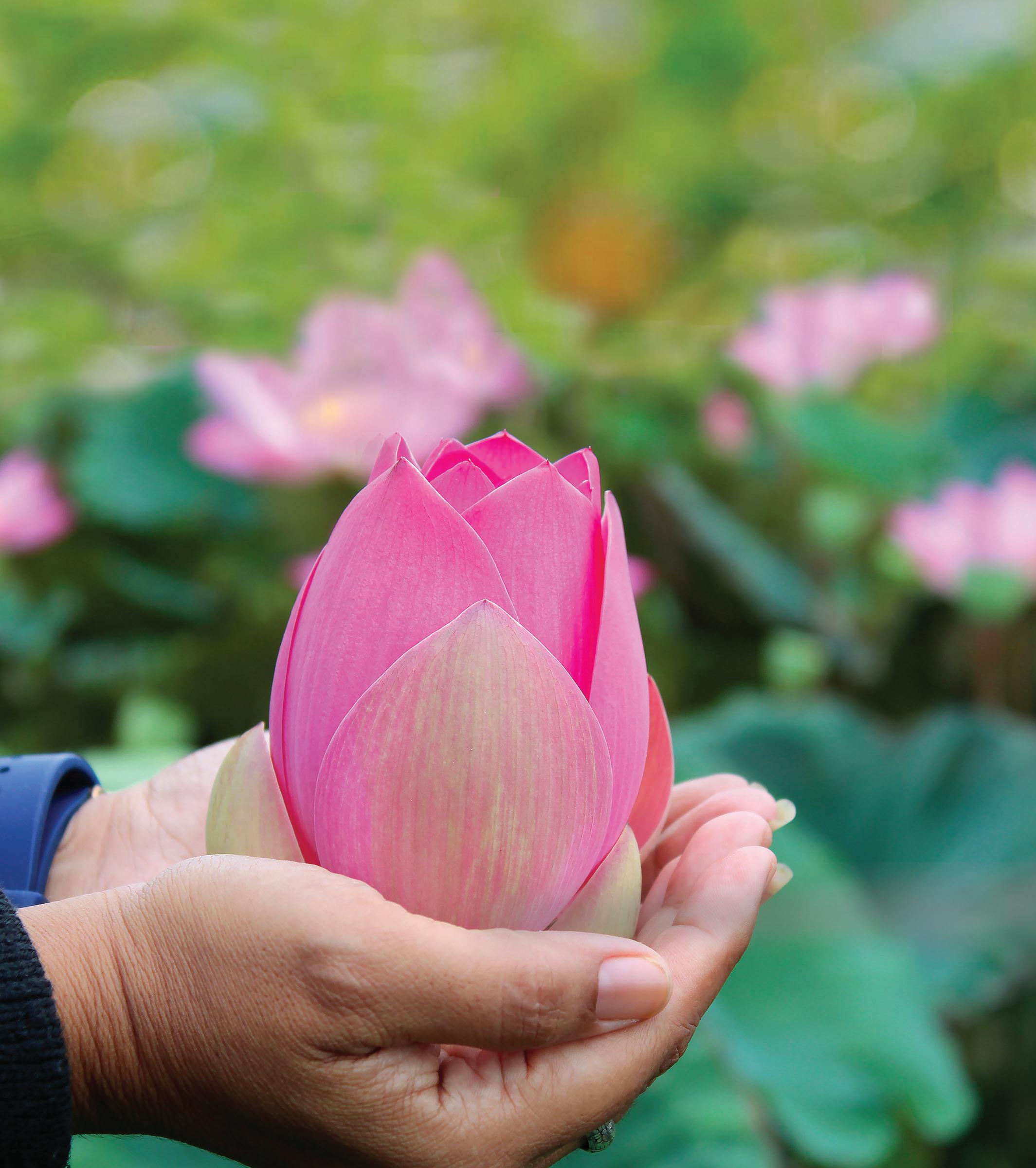
FREE ISSUE 57 • SEPT DEC 2023 kmspks_monastery kong meng san phor kark see monastery kmspks org/awakenonline 供佛斋 僧 的起源与功 德 供 僧 就 是 种 清 净 的 供 养, 能 让 众 生 当 下 远 离 烦 恼 ,除 心 束 缚 得 清 净 心 ,法 喜 充 满 。 P28 心香达 信 心 中 有佛,心 怀 虔 诚 ,不论 是 否 烧 有 形 的 香,都 能 达 到 恭 敬 供 养 佛 菩 萨 的目的 。 P42
and
P52
Embrace change, empathy
embodiment for transformation
Kong Meng San Phor
Monastery P64
at
Kark See
P76
FOUNDER / MANAGING DIRECTOR
创刊人 / 董事总经 理
Venerable Sik Kwang Sheng 广声大和 尚
AWAKEN CHIEF EDITOR (CHINESE)
普觉执行主编(中文版 ) 传雄法 师
AWAKEN TEAM 普觉团 队
Alvin Goh 吴衍 庆
Christina B. 黄秋 蘋
Dennis Chew 周国 栋
Frankie Chew 周金 祥
Mabel Tan 宽 智
Ong Geok Boon 王翊 文
Tay Kim Thia 郑金 锭
AWAKEN CONTRIBUTORS 撰稿 人
Ajahn Chah· Ajahn Jayasaro· Ajahn Sucitto
Venerable Lindagala Ananda Thero (Chang Xi)
Venerable Thubten Chodron· Chloe Huang
Jos Tan Law Wen Hui Robert Yeo Sarah Napthali
Wong Kee Yew
济群法师·马行荣·何佳原·蓝郁·明巍·净 璇 晓雪·远尘·禅悦·明慧·张瑞·惟珍·善 缘 常 静
PRINTER 印刷
Oxford Graphic Printers Pte Ltd
PUBLISHER 出版
Kong Meng San Phor Kark See Monastery
Awaken Publishing
88 Bright Hill Road Singapore 574117
Tel: 6849 5342
e-mail : publication@kmspks org
Website : kmspks org/awakenonline
COPYRIGHTS & REPRINTS 版权所有,翻印必究
Awaken is owned, published and distributed tri-annually by Kong Meng San Phor Kark See Monastery All material printed in Awaken is protected under the copyright act. All rights reserved. No material may be reproduced in part or in whole by any means, electronic or mechanical and retrieval system, without the prior written consent of the publisher Permission may be requested through Awaken Publishing.
所 有 刊 登 在《 普 觉 》杂 志 的 内 容 均 受 版 权 法 保 护。未 获 得正 式 书 面 同 意 前 ,请 勿 通 过 任 何 形 式 ,包 括 电子 媒 体 或 搜 索 系 统 , 自行 翻 印 。有 意 翻 印 者 请 事 先 联 系普 觉 出 版社 征 求 同 意 。
DISCLAIMER 免责声明
The views and opinions expressed or implied in Awaken are strictly those of the authors and contributors and are not necessarily the views of the publisher Although every reasonable care has been taken to ensure the accuracy and objectivity of the information provided in this publication, the publisher, editors, employees and agents of Awaken shall not be responsible for any actions taken based on the views expressed or information contained within this publication.
所 有 在《 普 觉 》杂 志 发 表 的 意 见 和 言 论 纯 粹 属 于 个 别 作 者 或 贡 献 者 的 观 点 ,未 必 代表 光 明 山 普 觉 禅 寺 的 立 场 。因 此 ,纵 然
意 见 或 讯 息 而 引 起 的 任 何 事 故 我 方 包 括 所 有 的 编 辑 、职 员 和 受 委 托 者, 概 不承 担责 任 。
ISSN: 1793-298X
MCI (P) 071/12/2022
/02 /04 /06 /14 /24 /32 /38 /44
卷 首 语 Abbot’s Message
光 明 法 讯
Buddhist News
意 解 人 生
对不起的反思
缅怀父亲 — 从 支金表谈 起
修行要趁早
脚底伤, 还是心病?
菩 提 清 韵
乐在当下
小妖 怪与三只鹅的启示
承天禅寺:喧嚣城市中的清凉地
莫恼 切诸有情
法 海 拾 贝
《吉祥经》中的伦 理 思想
供佛斋 僧的起 源与功德
求生西方净土的三种发心
竹 林 夜 话
大师铺路 后人 遮阴
生病与瞻护病人的功德方法
磐 陀 钟 磬
息灭妄想
心香达信
本 寺 活 动
Calendar of Events
表
我 方 尽 全 力 确 保 杂 志内 容 的 真 实 性 和 客 观 性 但 因 杂 志 内 所
达 的
kmspks_monastery Published with environmental awareness. Printed in Singapore on eco-friendly paper provided by a certified sustainable forestry mill. kong meng san phor kark see monastery
/52 /64 /70 /74 /80 /82 /84 /86 /87 /88
Feature
Beyond the edge
The place of coolness
Did You Know?
Journey through a century of gratitude

Buddhist Tales
My daily routine
Hard work is the key to success
Winning may result in unexpected losses
Something to Ponder
Choices
Mind vs Matter
Finding a way forward
Q&A
Contentment in life
Mindfulness Parenting
Too much technology
Savour
Heartbreak no more
@ Heartbreak Melts
Affordable vegan eats in town
Recipe
A cup of spiced goodness
Great Reads
Books for your well-being
What’s New
The latest products in Awareness Place
P32
Transforming oneself for a better society
Every day presents us with opportunities for personal growth and transformation through unity, understanding and positivity. By nurturing qualities such as loving-kindness and compassion, transforming our minds, and fostering understanding and harmony in our interactions, we wield powerful tools like mindful speech, compassionate actions, and forgiveness to bridge divides and heal wounds.

As we focus on our inner transformation, we must also recognise the pressing environmental challenges — the deterioration of our environment. Pollution, deforestation, climate change, and the exploitation of natural resources pose significant challenges to all beings and future generations. Thus, our actions, no matter how small, have far-reaching effects that can inspire others to join in the pursuit of a sustainable future.
As we enter this last quarter of the year, let us recommit ourselves to the path of peace and understanding. May our inner transformation positively impact the lives of those around us, and through our words, actions and mindful consumption, may we contribute to the well-being and happiness of all beings and the preservation of our precious Mother Earth.
Sik Kwang Sheng (Ven.)
/ Abbot’s Message 2 慈悲COMPASSION I 智慧WISDOM I 生活LIFE
自心蜕变 步向大同社会
我们所度过的每一个平凡日常,都汇聚了人与人之间的圆融相处、 包容理解或积极正向的生活姿态。这些生活中的因缘和合,都是 生命成长或蜕变的机遇。通过培植慈悲心,洞察自我或在人际关系中 倡导和平与包容,相信大家都可以吸收或释出正念正语,实践慈心善 举,进而化解生活中的隔阂冲突,释然他人与自我。
除了调伏自身心性,我们也应该正视生态环境保护的重要课题。环境污 染日渐加剧,滥伐森林、全球气候变暖、自然资源过度开采等问题,都 威胁着子孙后代的生存,更是我们最应该关注与反思的课题。一石激 起千层浪,两指弹出万般音。若我们能从自身的一言一行开始改变,相 信大家终能启发身边的有情众生,将环境保护的意念根植于心,一起 守护共同家园,与自然和谐共生。

步入今年的最后一个季度,愿各位都能发心护持正法,弘扬包容和谐的 精神。希望大家都能从个人心性的蜕变开始做起,积极地影响身边的每 一位。以言传身教的方式传递正心、正念、正行,贯彻仁爱与和平,守护 环境大地,由自心的蜕变,迈向大同的社会与世界。
释广声
普觉 I Issue 57 3 慈悲COMPASSION I 智慧WISDOM I 生活LIFE
awaken
Walking in the footsteps of timeless wisdom
Held on June 25, 2023
monastery's foremost abbot. Under his leadership, the monastery experienced significant growth and development. The Hall of No Form, located on the fourth level of VHCMH, astounds visitors with its colossal 13.8m height of Shakyamuni Buddha statue.
Another remarkable sight awaits in the Hall of Amrita Precepts, situated near the sacred Bodhi Tree. This Bodhi Tree traces its lineage back to the revered Bodhi Tree in Bodhgaya, India, where Prince Siddhartha attained enlightenment.
The tour also includes the Pagoda of 10,000 Buddhas, which features the Hall of Medicine Buddha located on the second level. This hall contains an impressive display of ten thousand Buddha images symbolising the boundless presence of Buddhas throughout space and time. The Hall of Universal Brightness, the oldest hall in KMSPKS, houses the statues of Shakyamuni Buddha, Amitabha Buddha, and Medicine Buddha.
Kong Meng San Phor Kark See Monastery (KMSPKS) has recently reopened its monthly guided Temple Tours, inviting participants to embark on an extraordinary journey transcending time. Resuming after the easing of covid-19 restrictions, these tours offer a unique opportunity to uncover the hidden gems within the Monastery.
Warmly welcoming a limited number of 20 participants each month, this guided Temple Tour leaves visitors in awe as they admire the stunning architecture and captivating artifacts while immersing themselves in Buddhist traditions. This experience instils a deep appreciation for the Monastery's enduring cultural significance and the cherished historical legacy across generations.
Among the notable highlights are the Venerable Hong Choon Memorial Hall (VHCMH), a poignant tribute to the
Participants of the tour expressed their profound satisfaction through the experience of this tour, describing it as truly enriching and well worth the two hours spent. One of the participants, Ms. Joanne Sim, shared her delight in having serendipitously discovered this exceptional Temple Tour, expressing deep gratitude for the meticulous planning and execution that allowed her to learn the history of Kong Meng San Phor Kark See Monastery.
The free guided tours at KMSPKS are availble in both English and Mandarin, allowing visitors to fully immerse themselves in the monastery's history and the profound teachings of Buddhism.
To find out more about this enriching experience or join the next tour, email guidedtour@kmspks.org.

/ Buddhist News 4 慈悲COMPASSION I 智慧WISDOM I 生活LIFE
依三宝是学佛的入门,受持戒律是信仰 的实践。光明山普觉禅寺于7月30日 (星期日)举行三皈五戒典礼,礼请广声大和 尚主法,为现场120位佛子证盟皈依受戒。

典礼开始前,由职员讲解及带领在座各位了解 合掌、问讯、跪拜等基本行仪。佛子们捧持 《三皈五戒仪规》,于无相殿释迦牟尼佛像前 参与庄严典礼,由道明法师及悟承法师引礼大 众虔诚跪拜,经请师、香赞、求受皈依、请圣、 忏悔发愿、及宣誓皈依后,在座诸位正式成为 佛弟子。
“皈”指的是回传或皈投,“依”指的是依靠 或信赖。“皈依三宝”,即是指将心念皈投于三 宝——佛、法、僧,赋予心灵与信仰上的安全 感。皈依三宝的目的与意义其实非常简单——
寻求佛性的显现,以智导行,以慧修观,在生死 轮回的暗路中,皈向三宝的光明指引。
完成皈依后,64位佛子发心求受五戒——不
杀生,不偷盗,不邪淫,不妄语,不饮酒。如《佛 遗教经》云:「戒是正顺解脱之本」,佛弟子修 戒定慧,三业清净,依戒而生正知正见,改往 修来并朝向智慧的觉道迈进。响亮的「能持」
在大殿中清澈回荡,声声持戒的愿声化作慈光
摄照,证授了佛子们的圆满受戒。
典礼圆满之际,佛子们肃穆合掌感谢广声大和 尚主法证授。洒净后的滴滴法喜滋润身心,大 家也在仪式后信心坚定的接过皈依证与戒牒, 心系正法正念的带上结缘念珠。依循三宝点亮 的光明心灯,相信大家将继续精进学习,舒坦 宽容的面对世间的无限变化。
三皈五戒 典礼
三皈五戒典礼 典礼于7月30日,在光明山普觉禅寺 无相殿顺利举行。

光明山普觉禅寺于每年3月,7月及9月开办佛 教礼仪班、三皈五戒预备班以及三皈五戒典 礼(中文授课)。如有兴趣参与者,欢迎洽询 sed@kmspks.org,或致电6849 5300及 6849 5326了解更多。

皈
awaken 普觉 I Issue 57 5 慈悲COMPASSION I 智慧WISDOM I 生活LIFE
的补习班最近发生了一 起打架事件!
事情的经过是,一位四年级 的男同学利用休息时间在白 板上画了整片的地图图案, 另一位男生觉得碍眼便把它 擦掉。画画的同学很不服气, 结果两人就扭打了起来。
事情发生的有些突然,让我几 乎措手不及,还好立即把两 人分开,才不会酿成大祸。
画画的同学默默哭泣,花费 了很多心思来完成,甚至很 期待和大家分享他的杰作。 画作突然被擦了一半,感觉 很委屈。其实这个男生的学 习态度一向很不认真,讲话 又大声,不受其他同学们喜 爱,经常被排斥。
我那天看他在白板上画得很 投入,心想终于找到他可以 专注的事,于是任由他随意 的画。他的地图画确实有些 抽象,东一块西一块,令人理 不出头绪。因此引来另个男 生的不满,认为白板不该画 成这样,于是上前擦掉。
思索地说了声“对不起”,我这 才松了口气。
课堂上偶尔发生一些突发事 件其实并非坏事,可以利用 这样的反面教材来教导学生 们课本以外的生活小道理, 有警惕效用,灌输他们正确 的价值观。
勇敢说对不起 同样发生在补习班另一件 和“对不起”有关的事件。
我的一组学生趁休息时间 在补习中心外的空地嬉戏玩 水,结果引起清洁工人的不 满,向另一补习老师投诉。
同学们看到清洁工伯伯一脸 严肃地跟老师说小孩子不应 该随便玩水,会弄脏周遭环 境,都害怕起来。他们都躲进 课室,忐忑不安。
有位同学说:“糟了,他会不 会进来大骂我们一顿?”,另 一位说:“我们只是在装瓶 子里的水,没有玩水啊。”有 位女生甚至胆怯地说:“我并 没有玩水,只是跟在后面而 已。”众说纷纭。

这时有位男生自告奋勇走 出课室跟清洁工伯伯道歉, 说:“对不起,是我们错了。” 事情才告一段落。我后来发 现有同学在白板上写上“对 不起,请原谅我们。”还加了 一个哭脸表情。
成熟,希望他能继续成为其他 同学的学习榜样。
小朋友一旦做错事就必须教 导他们勇于认错,同时要学 会说对不起,很多事情便能 一一化解。他们或许不太明 白“对不起”这三个字的真正 含义,不过在适当的时候说出 口,相信以后就不会难以启 齿。
对不起即忏悔
反观大人,因为有自己的主 见和观念,又顾及自尊心,反
虽然我一直觉得画画的男生在 许多方面有待改进,但就事论 事,那位擦白板的男生在没有 老师的允许下是不该擅自擦掉 白板上的东西。我告诉他这样 很不尊重他人,因此要他向画 画的男生道歉。还好,他毫不
从这件事,我看到了这群十来 岁孩童的不一反应,欣慰他 们都知道错了,并懂得认错。
至于那位主动上前道歉的男 生,我留意他平时比其他同龄 学生较有主动性,思想也比较
我
/ 意解人生 6 慈悲COMPASSION I 智慧WISDOM I 生活LIFE
给别人一个 弥补的机会, 就是给自己 一个宽阔的胸襟 去包容他人的过错。
而越难鼓起勇气认错,更别 说低头向对方说对不起。倘 若遇到两个倔强的人,谁都 不愿服输,误会将愈陷愈深, 搞得心力交瘁,两败俱伤。因 此对一些人而言,说声对不 起需要莫大的勇气。

懂得说对不起即是懂得忏悔, 懂得忏悔意味着愿意放下执 念,不执着于事。我认为“对 不起”这三个字包含了反省、 良知及涵养,说出口时绝对要 诚心诚意,而非敷衍了事,毕 竟诚意是感受得到的。
“对不起”属双向的,当一方 诚心道歉说对不起后,另一方 必须欣然接受和原谅,那是 一种气度与宽容,也是一种相 处之道。给别人一个弥补的机 会,就是给自己一个宽阔的胸 襟去包容他人的过错,同时体 现善良的一面。
对不起 的反思
蓝郁
awaken 普觉 I Issue 57 7 慈悲COMPASSION I 智慧WISDOM I 生活LIFE
缅怀父亲 从一支金表谈起

/ 意解人生 8 慈悲COMPASSION I 智慧WISDOM I 生活LIFE
我把修好的表交给父亲, 看得 出他很开心, 又迫不及待地戴 在手腕上。
放在旁、坐在那儿等,俨然是 父亲良好基因的传承。父亲 时刻挂在口中的教诲是:要守 时,不要让别人等。就是因为 这样的“不要让别人等”,所 以他一辈子就总是在等别人。 但是也因这样, 守时的父亲一 辈子都坦坦荡荡的, 仰不愧于 天, 俯不怍于人。
过了几个月,这支手表又坏 了。父亲又叫我拿去修理,就 这样修了又坏,坏了又修,前 后修了好几次。我想, 现在的 人东西坏了,马上就丢了,换 个新的;还有的人喜新厌旧, 东西还没坏却也扔进垃圾桶, 哪像父亲这样惜物!父亲表 不离手腕,除冲凉时怕被淋 湿, 便取了下来,冲完凉又立 马戴回去。他连晚上睡觉时 都戴着手表,我常戏谑他要 与周公约会不能迟到,所以 睡觉也要戴着手表。
从一支腕表可看出父亲非常 节俭惜物,他这辈子身上穿 的永远都是一件背心、一条 黑裤和一双拖鞋。父亲吃饭 时桌上掉的米粒都一一捡 起来吃,尤其爱吃豆沙饼, 每回掉落的饼屑,他都不放 过。虽然节俭,但父亲对孩 子却很舍得花钱。我们在物 质与精神上感觉从不匮乏, 这都是父亲给予我们一辈子 无从回报的恩惠。
父
亲在世时,有一支钟爱 的手表,是大哥送他 的生日礼物。手表是金色底 镶银边的表带,表壳和表针 都呈金黄色, 因戴的年月久, 表的金漆斑驳,玻璃也刮花 了。这支表罢了几回工,我 后来买了一支新表送给他, 但父亲不太常戴。
他嘱咐我拿旧手表去修理, 说 还可以修,丢了可惜。我跑到 丹绒加东购物中心的一家手 表修理店去找“救星”,修表 大叔妙手回春地把表修好了。
父亲是一个非常有时间观念 的人,他出门看医生,当我 到小弟家去带他时,他衣服 鞋子都已穿好,坐在轮椅上 等, 手中还握着把伞, 随时 可以出门。当时女佣也被他 训练有素,两人都戴好口罩 坐在那儿等。还记得我们小 时候他也是这样,准备好要 出门, 眼睛就瞄着屋里的人, 仿佛在催促着:“还不快快, 都几点了?”在这种环境下 我们兄弟姐妹也多少被熏陶 了, 守时观念特别浓厚。
直到今天, 我还是家里要一起 出门时, 第一个准备好的人: 包包准备好、鞋子穿好、雨伞
父亲为人慈悲大度, 总是对 别人“觉得很不好意思”。他 粗线条的外表下总蕴含着慈 悲善良的胸怀,不忍四姨家 生活清贫,总是暗地里拿零 钱给她家小孩,把自己中马 票的钱全数塞给五叔做小本 生意。这事老妈到现在还在 不停叨念着,而老爸却总是 静默不语。
岁月匆匆过, 父亲成仙也已一 年多了。睹物思人,那支旧手 表如今还在我哥那儿收藏着 做纪念。我们兄弟姐妹常在 闲聊话语中谈起父亲,眼底 尽是深深的怀念与不舍, 但是 我们也深知逝者已矣, 生者如 斯, 唯有放下, 继续前行才能 让父亲在天之灵安息。

晓雪 awaken 普觉 I Issue 57 9 慈悲COMPASSION I 智慧WISDOM I 生活LIFE
从一支腕表 可看出父亲 非常节俭惜物, 他这辈子身上穿的 永远都是一件背心、 一条黑裤和 一双拖鞋。
或许很多人常听到的 一句话是“出名要趁 早!”以世间的规律来看,年 少成名,接踵而来的便是富 贵加身,好则真的好,坏则真 的坏,多少惊为天人的才子 才女们,在中晚年时陨落, 甜蜜的果实里仿佛包裹着毒 药,在品尝的过程中令人不 易察觉,却在岁月静好的日 子里悄然的慢性中毒。
其中道理都是因为抵不过五 欲六尘的牵引,在欲望中打 滚,最终却将欲望的雪球越 滚越大,直到人生的福报无 法负荷,于是砰然倒塌。佛陀 的智慧教导我们,唯有放下, 才能真正拿起,唯有空杯,才 能将水倒入的原理。
如果说追求名利要趁早,不 输在起跑线上,不如修行要 趁早,在年少时,将自身这个 容器清理干净,干净的容器 若被灌入毒药,就能一眼识 破,即刻倒掉,防患于未然, 之后才能加入清洁的水。
并不一定,所以在这个社会 里,不同的时代有不同时代 的行为准则,如果时代所宣 扬的是追名逐利,而刚好有 那样一群引领在前的人,从 众效应便产生了,人的思维 会被牵引,认为跟随着时代 脚步才是正确的,而不会去 思考背后的对与错。
可能年轻人多是这样认为: 年轻时没有时间,老了再去修 行。年轻力壮时,吃过生活的 苦,也享受过生活的乐,年纪 渐长,回望过去的艰辛与快 乐,才感悟到生命的珍贵,希 望健康长寿,死后求生极乐, 再不济,至少也想求得人天福 报,不堕三途。却不知,在修 行上若没有千锤百炼,长时熏 修,业力现前无法自主时,要 达成愿望谈何容易?
人生短短不过百年,如诗所 言:天地者万物之逆旅,光阴 者百代之过客。而浮生若梦, 为欢几何?时光短促,人世间 所有的一切都是消福和消业 的过程,循环往复,趁早开始 修行的人,知道培福和消业, 往后的人生怎会不顺畅?若 是有这个福报,无论出名还是 求利都可以暂且放一放,但是 修行却是机不可失,时不再 来,所以修行要趁早。
在成长的过程中,尤其是当 今浮躁的环境,总是不容易 察觉危险,科学家们曾做过 一个实验,人是群体的动物, 当一个人发表了某一个意 见,其他人会因为群体的效 应而附和这个意见,最终大 家达成一致,但是所达成的 意见究竟对还是不对,其实
明慧

人世间所有的 一切都是消福 和消业的过程, 循环往复, 趁早开始修行的人, 知道培福和消业。
/ 意解人生 10 慈悲COMPASSION I 智慧WISDOM I 生活LIFE

awaken 普觉 I Issue 57 11 慈悲COMPASSION I 智慧WISDOM I 生活LIFE
修 行 要 趁 早
脚底 伤, 心病? 还是
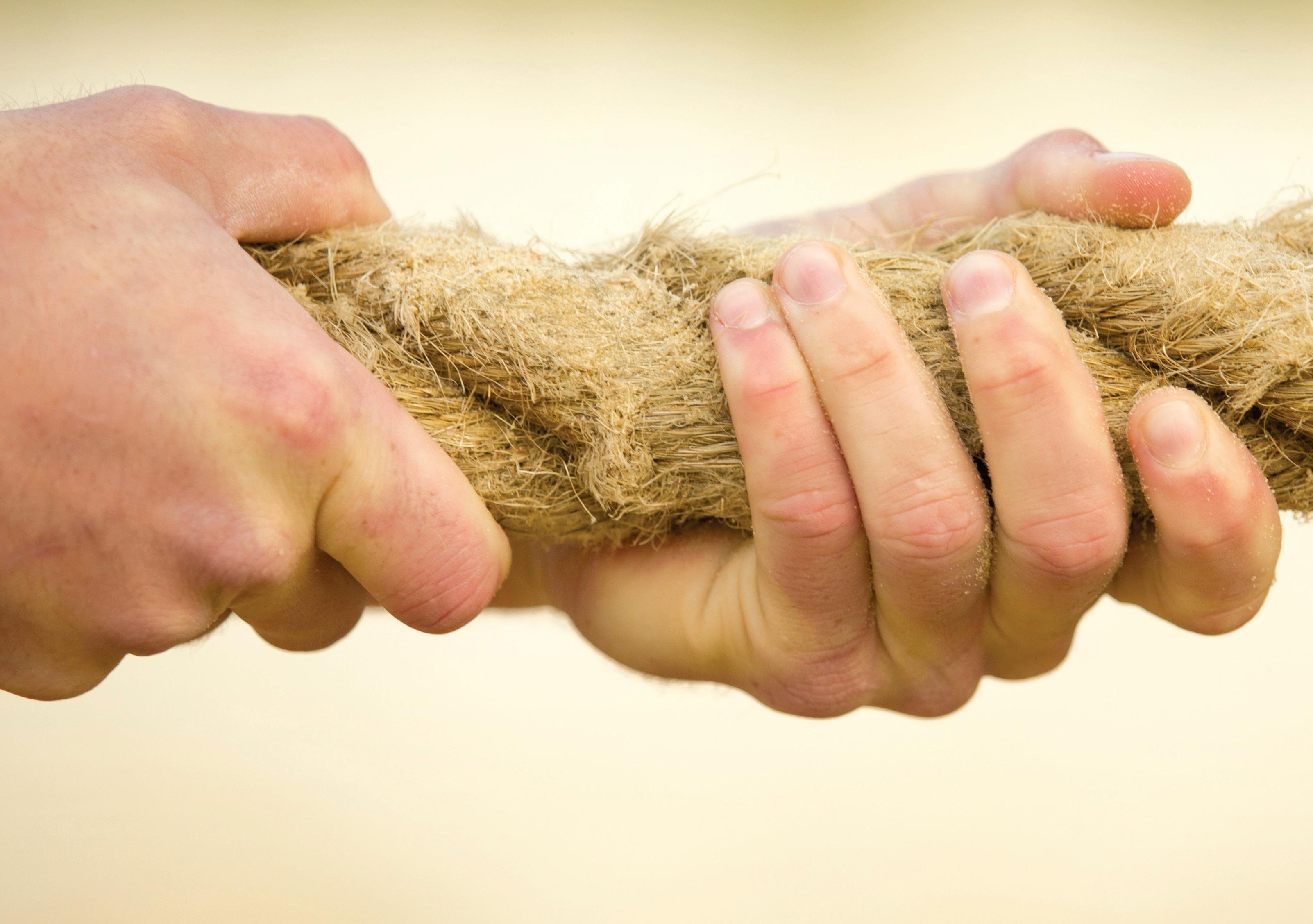
/ 意解人生 12 慈悲COMPASSION I 智慧WISDOM I 生活LIFE
昨夜临睡前,感觉脚底有 点刺痛,拿手电一照, 发现好像被刮伤了, 隐约中还 看到一条长长的刮痕。但睡 意实在太浓,便倒头继续睡 觉, 想等第二天再处理。
清晨起床检视伤口,见脚底 有一道暗红色的小伤疤,看似 伤口已愈合。心想:怎么这么 快就结疤了? 虽如此, 但每走 一步还是小心翼翼,下意识地 把重量放在另一只脚上,深 怕再把伤口撑开。心里越这 么想,注意力就全放在小伤 疤上, 总觉得下一秒就快把伤 口撑开,血流如注了。因为在 意,所以感觉脚底愈来愈痛, 走起路来也愈来愈艰辛。
就这样一拐一拐地走路,直 到下午要出门去办事。拿了 一瓶消毒药水准备处理伤口, 顺便贴上胶布。就在要处理 伤口时, 才发现原来是一条红 色的小铁丝紧贴脚底。取掉 小铁丝方才发觉原来脚一点 伤也没有,走起路来健步如 飞。至此真相大白, 原来的痛 与难堪,皆来自多虑的心底, 而非无辜的脚底。

天下本无事,庸人自扰之。我 就是那个名符其实的庸人! 原来我们一切的喜、怒、哀、 乐都是自己想像出来的, 连痛 也是。居然痛得像真的一样。 那么,我们最在意的东西, 包 括人、事、金钱、感情、爱情 等, 因为执着地以为都是属于 我们的, 紧紧抓住不放,有时 抓得太紧了, 反而伤到自己。
其实这些东西看似属于我们, 而实全都不属于自己, 但我们 心中仍执意以为,拥有一切。 而且一旦拥有,就害怕失去, 所以异常在意,特别纠结。就
如那根小铁丝,它甚至只是 暂时黏贴在我的脚底,但我 心里却足足痛了一整天。
这又让我进一步反思到,很 多时候我们的担忧恐惧和不 开心, 是不是因为我们总是反 复地胡思乱想。我们总是把 最糟的情况设置在我们的思 维中, 我们联想着各种可能, 总以别人的思维来决定自己 的快乐。换句话说,就是太在 意别人的眼光,以致希望活 成别人眼中的自己。我这么 做别人会怎么看我?我这样 别人会不会笑我?别人这样 说,是不是瞧不起我?甚至其 实别人什么也没说, 而自己却 在责备是不是做错了?殊不 知, 把焦点都放在别人眼中的 自己, 内心岂能自在舒意?说 穿了自己在别人的心里怎么 样, 其实也并没那么重要。别 人也很忙,谁也没空去搭理你 展翅飞翔的联想力。
是时候要学会放下了, 虽说放 下不易,但放下后天宽地广, 何处不自在?我想我们应当
快点抽离出来, 就像我抽离出 那根红色的小铁丝后,脚板 瞬间能健步如飞地走、连带 整颗心也飞跃起来。
晓雪
原来的痛与难堪, 皆来自多虑的心底, 而非无辜的脚底。
awaken 普觉 I Issue 57 13 慈悲COMPASSION I 智慧WISDOM I 生活LIFE
《大宝积经》云:“不分别过 去,不执著未来,不戏论现 在。”我们知道生命就在当下 一刻,并且我们有可能乐住当 下,因此在日常生活中的每一 刻训练我们自己深入到生活 中去。
安住当下,乐住当下。即不被 过去的种种事情感到遗憾、 困惑,也不被未来的种种事 情而感到焦虑或被当前的渴 望、嫉妒与嗔恨所挟持,从而 在正念中把握自我。我们决 心修习正念是生活的艺术。 通过接触我们自己及周围精 彩、新鲜、健康的元素,以 及滋养我们内心的欢乐、安 祥、爱与智慧的种子来帮助 我们转变并治愈心中的不良 因素。
当今社会物欲横流,科学技 术日新月异。物质生活越来 越丰富,而精神上却越来越 空虚。一颗支离破碎的心灵 常常感到恐惧、疑惑及忧虑。 当闲暇无事的时候,我们很 少能够反观自身,而是迫不及 待的打开电视或浏览网络来 打发时光。正念修习就好比 核桃一样,它是修行生活的核 心。无论你是常住在禅修中 心、从事办公室工作、居家生 活、或在大学读书,正念修习 都是非常关键的。
习,行、住、坐、卧,工作或休 息都是进行修习的时机。有 意识的呼吸是把我们带回当 下并保持住的工具。《安般守 意经》和《四念处经》教我们 如何使自己的身、受、心、法 处于正念之中。当我们的定 力与智慧增长时,必然伴随 着心中深深的欢愉与幸福的 感觉,因为我们深入体察到 现实的本性时,就看到世界 与一切众生——动物、植物、 有机物都是如此的精彩。没 有正念,我们无法触摸到那 些漂亮的花朵、靓丽的月光、 我们的孩子、伴侣及朋友。他 们无疑是珍贵而稀罕的,是 万物互即本性的一部分。正 念使生活真实、深入而且能 够引导我们更加积极的去体 验人生。它帮助我们活在当 下,与真实生命相遇。它帮助 我们同体内及周围那些清新 的、有治愈能力的因素相应。 修习正念时,我们常常浇灌着 心中快乐、安详与智慧的种 子发芽成长。这些种子是转 化和改变我们心中痛苦的力 量。这个时候,生命就是一个 奇迹。
安、舒畅的感觉。正所谓制心 一处,无事不办。
只有真正能够活在当下的人, 快乐时常与他相伴,空虚与他 无缘,烦恼离他而去。就如同 天上的云彩,感觉来来去去。 坐在这里,不想过去,不想未 来,并且知道自己在坐着,这一 刻美妙而精彩。我们只浇灌心 中欢乐、安详的种子,而不去 浇灌烦恼的种子,那么,此刻 我们已经步入解脱自在中了。
明巍
正念一词在汉字里包括两部 分:心与心念于当下。正念 意味着时刻都要把握心念, 任何时候都可以进行正念修
在巴利语三藏中,经常用到 dittha dhamma sukha vihari 这 句话。它的意思是乐住当下, 乐住现生。我们也许常常会感 到不幸福不欢乐,而且自身变 得很柔弱。也许我们的修习没 有转变我们的生活,没有给我 们带来愉悦的欢乐,如果我们 没有把欢乐带给其他人并去理 解他们,那么我们的修习是不 正确的。我们没有提起正念, 更没有安住当下。只有深深地 住于当下正在发生的事情,并 且深入到每一个细节中去。 那么,身心的所有焦虑和忧愁 便会烟消云散,立刻便产生轻

/ 菩提清韵 14 慈悲COMPASSION I 智慧WISDOM I 生活LIFE
浇灌心中欢乐、 安详的种子, 那么,此刻我们已经 步入解脱自在中了。
乐在当下
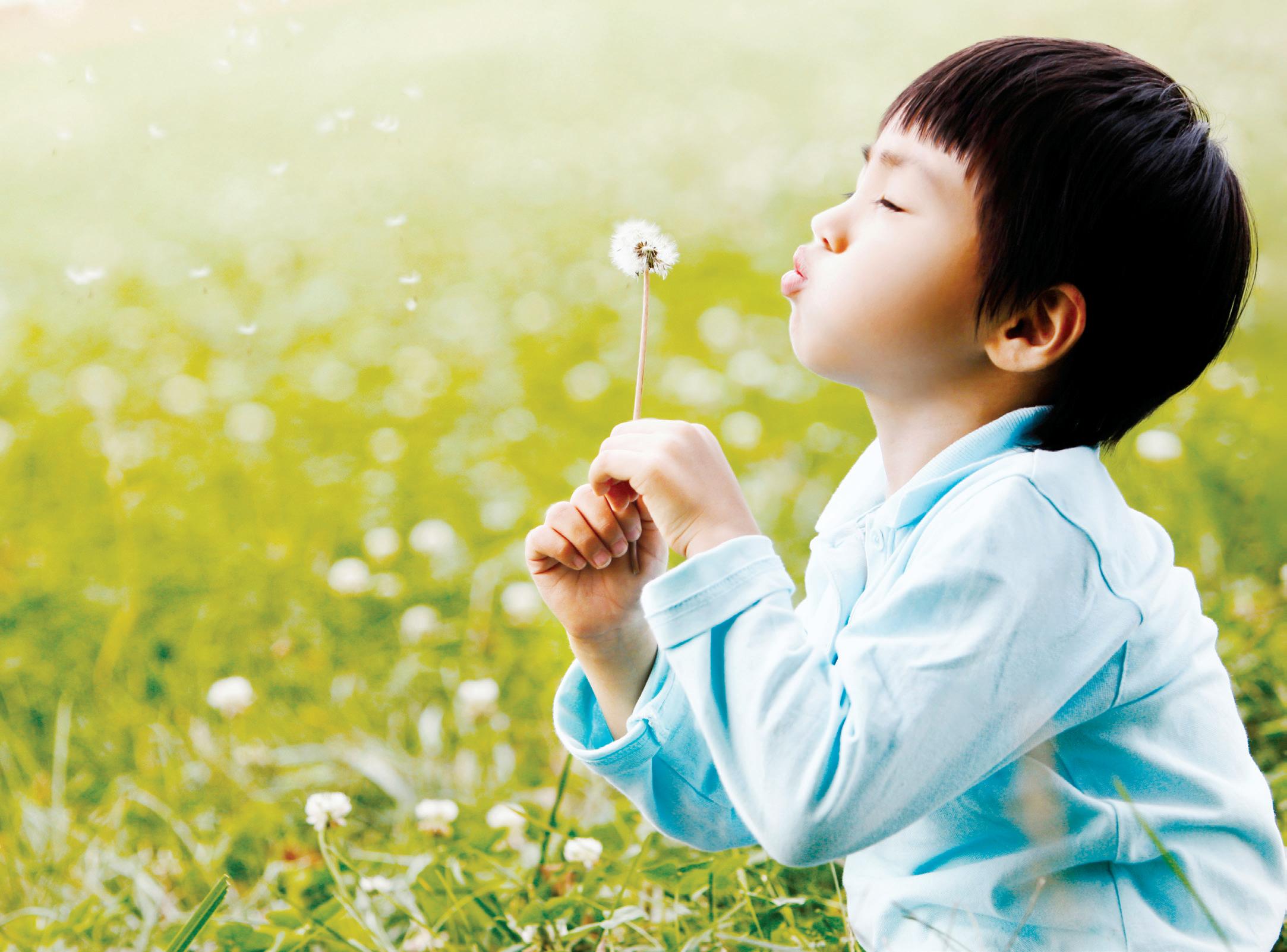
awaken 普觉 I Issue 57 15 慈悲COMPASSION I 智慧WISDOM I 生活LIFE
选 择眼前看似最直接, 易行的道路,须付出的 可能是自己预想不到的沉重 代价。
最近看了几集网上热播的《中 国奇谭》动画,每集的故事背 景、画风,截然不同,相同之处 在于都有妖怪,故事各包含了不 同寓意,其中《小妖怪的夏天》 与《鹅鹅鹅》令我印象深刻。
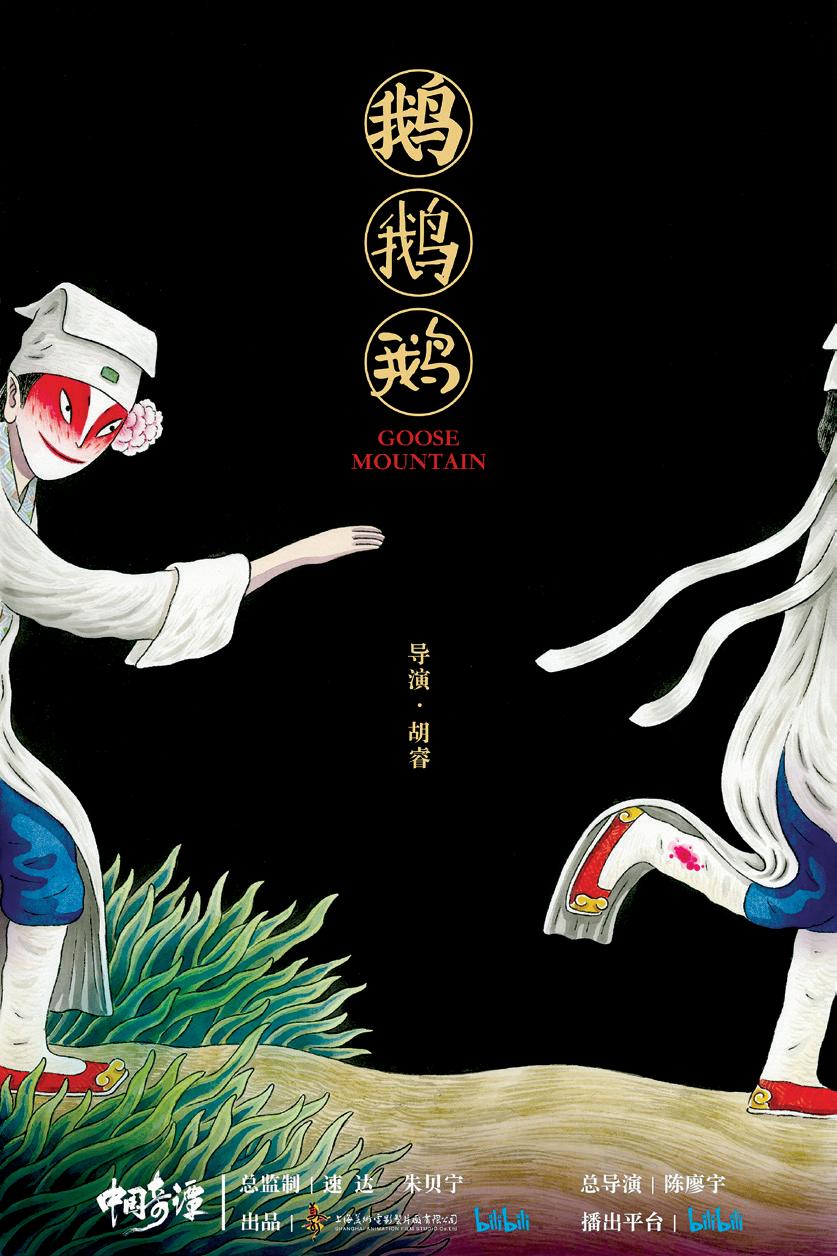

小妖怪的夏天
故事以唐僧取经为背景,但 主角并非唐僧师徒,而是一 个小猪妖。浪浪山的妖怪大 王想在唐僧路过时,将他拿 下烹煮,于是安排了小猪妖与 其他属下开展各种准备工作。 在这过程中,我们看到了上层 对底层小妖的欺压与不公,但 身为底层的小猪妖仍是尽心 尽力,完成任务。
/ 菩提清韵 16 慈悲COMPASSION I 智慧WISDOM I 生活LIFE
小 妖 怪 与 三 只 鹅 的 启 示
选择眼前 看似最直接, 易行的道路,
连续几日的筹备工作令小猪
妖对唐僧师徒产生了好奇心, 令我好奇的却是,小猪妖性 格单纯,并非恶妖,为何要为 大王干坏事?庆幸在众妖围
绕的环境,小猪妖还是分得 出善恶,当他听到人类对唐 僧频频赞美,心中升起了敬 仰,在得知唐僧的三个徒弟也 都是妖怪后,我想他心中更 是兴起了一个想法,妖怪也 能行善,受人尊敬,不一定要 做人人厌恶的妖。
最直接易行的道路
令我感触最深的是小猪妖回 家与母亲交谈的那一幕。一 年未回家的小猪妖,猪妖妈 妈仍以小猪妖当初被大王选 中雇用而感到自豪,当小妖说 想出去闯一闯时,母亲叫他 别瞎想,跟着大王好好干。原
来小猪妖之所以追随大王, 是因母亲无知的安排;我想 在猪妖妈妈生活的环境,大 家都把大王当作好妖,孰善 孰恶,又岂是一般老百姓所 关注的?毕竟,不是每个母亲 都能像孟母,除了希望孩子生 活在良好的环境,还具备分 辨环境好坏的智慧。
很多人说他们看这部动画时, 深深感受到打工族的辛酸, 但我想结尾是励志的;最后 小猪妖没有随众妖同流合
污,冒着生命危险也要通知 唐僧师徒山中有陷阱。或许 也有其他小妖不认同大王的 做法,但他们选择服从,选择 看似更直接,易行的道路,最 终却为自己的恶业付出沉重 的代价。“诸恶莫做,众善奉 行”,从来就不是凭着轻松, 被世俗认可,去决定是否要做 或不做某件事。
鹅鹅鹅
改编自南朝梁文学家吴均的散 文《阳羡书生》,往前追溯,故 事的起源是三国时期西域僧人 所译编的佛教寓言故事集—— 《旧杂譬喻经》《梵志吐壶》 篇,原文不过半百字,改编成 动画后增添了一些情节,但以 现代视角去看,还是颇为简约 的作品,故事结构中的留白空 间,则需要观看者自己去体会 与解读。
动画叙述一货郎为了送两只鹅 到隔壁村,在鹅山偶遇一腿瘸 的狐狸公子(狐妖),要求货 郎背他上山,抵达山顶,两只 鹅竟被狐妖吞噬。狐妖邀请货 郎喝酒,从嘴里吐出他的心上 人兔娘,狐妖睡去后,兔娘吐 出了她的心上人野猪郎,野猪 郎也趁兔娘睡后吐出了自己的 心上人鹅娘。货郎对鹅娘一见 钟情,鹅娘请求货郎带她走, 她愿做他笼子里的鹅,货郎犹 豫,但经过一番思索,还是答 应了。此时狐妖却苏醒,野猪 郎迅速吞下鹅娘,兔娘再吞下 野猪郎,而最后兔娘也回归狐 妖嘴里。
无危机感,无出离心
这层层的欺骗与压迫,充斥着 欲望。最初货郎不听猎人劝 诫上了鹅山,或许是因为鹅山 是捷径,但其中必然包含了欲
望与愚痴,让自己陷入险境。 在狐妖睡着时,货郎没有想逃 跑,或许是希望从狐妖获得补 偿,在兔娘、野猪郎睡去时, 他也没逃。睡着的妖怪们随时 会醒来,谁知是否会把货郎吞 入嘴里?但货郎丝毫没有危机 感,这不就像生活在娑婆世界 的众生,纵使危机四伏,纵使 身在火宅,也毫无出离之心? 即便当鹅娘要货郎带她走时, 也未点醒货郎该离开,反之他 最先考虑的是自己是否真能拥 有鹅娘,还是也会成为鹅娘吞 进口里的心上人。
作为一个看戏的局外人,我们 时时刻刻担心货郎不知接下 来会遇到什么危险,货郎怎么 就这么愚蠢,错过一次次扭转 局势的机会。在某些情况,我 们何尝不像货郎,浑浑噩噩过 日子,事发后却懊恼自己原本 拥有两只鹅,因没把握机会, 丢了三只鹅?其实无论是最初 的两只鹅,或是后来出现的鹅 娘,都不属于货郎。狐妖与货 郎告别时,回头露出了邪恶的 笑容,因为他知道无须使法或 威吓,货郎也走不出鹅山;放不 下过去所拥有的,对未来又持 有妄想,货郎失去的不是三只 鹅,而是自己的心。
蒲松龄曾写“事态渔洋已道 尽,人间何事不鹅笼”?鹅 山是个大鹅笼,我们所处之 处也是个鹅笼。但作为佛教 徒,我们还是幸运的,佛陀 已为我们指明离开囚笼的方 法——厌离娑婆,欣求极乐, 以出世心修净土行,如是念 佛,方可成就。
净璇
awaken 普觉 I Issue 57 17 慈悲COMPASSION I 智慧WISDOM I 生活LIFE
须付出的可能 是自己预想不到的 沉重代价。
承天禅寺

喧嚣城市中的 清凉地
/ 菩提清韵 18 慈悲COMPASSION I 智慧WISDOM I 生活LIFE
不容易起了个大早,乘 坐四十分钟的公车,再 转了一小时多的捷运,到站后 又赶上小巴,约十多分钟抵 达南天母广场,一下车随即被 路边野狗穷追不舍,仅仅两公 里的林间栈道,疾行起来却 足以要了我的小命。
即使一路上葱葱绿树成荫, 淙淙溪水为伴,身为“汗宝 宝”的我,依然大汗涔涔,几 乎湿透衣服,加上脸部出油, 一副狼狈模样,让我越发焦 躁,与想象中微风拂面,悠哉 漫步的唯美场景相去甚远。
“安土地真言”亦是不绝于 口,语速之快,快到舌头几乎 要打结、快到自己也听不清楚 在念啥,心慌意乱都怪沿途 野狗对我总是虎视眈眈。
不过,每到陌生异地,默念几 句真言回向当地土地神衹已 是我多年养成的习惯。因为 知道自己无法掌控的事情太 多,因为了解自身拥有与自然 抗衡的能力实在太渺小,对 于未知境遇,我们应该始终 保持谦卑与诚敬。所以在嘴 上的安土地,某种程度也是 在安住心地。
为了赶制毕业专题,频繁飞 驰在台湾北海岸淡金公路的 那段时间,不论启程或回程, 一旦骑上机车,六字大明咒与 绿度母心咒即脱口而出。从 淡水到石门,再到金山和万 里,一旁是蔚蓝广阔的海,另 一旁则是形态敦厚的山,不
时可见几座孤坟独立于荒山, 而高架桥下方的石门十八王 宫庙常年香火鼎盛,寺庙后方 金炉青烟袅袅,飘渺承载着 义犬护主的传奇事迹。
我知道,它们都在默默守望 这一片海岸,冥冥之中护佑一 方水土。我莫名地受到感动, 无意间随机涌现的咒语,似乎 可慰藉沿海公路上的生灵, 祈求风雨协和,勿使明媚风 光受毁伤,也愿宁息人祸,路 上行者皆平安。
倘若我在拜访承天禅寺时有 这样的心思就好了。如今回 想,简直是浪费了一路环绕山 林,在身旁、在脚下流淌不息 的石壁寮溪,那清澈水面上, 闪动银绿相间的粼粼波光, 令我印象深刻,凑巧契合了 我对承天禅寺的第一印象。
猛地,一阵深沉音波将我包 围。那是大殿传来的钟声,浑 厚而宏远,瞬间传遍整个禅 寺园区,“咚”声过去,一波 波“嗡”的余音由近至远,又 从远而近,往复萦绕,久久不 散……
钟声仿佛把我带到另一个世 界,难以言喻的熟悉感顿时 涌现。
是微风吗?不是的。是阳光 吗?不是的。更不是雨,不是 潮浪,不是电光石火。
可是全身毛孔张开了,淋漓大 汗干爽了,来自油头垢面的焦 躁感消散了。抽象但又实在 的力量,奇妙地稳住我的呼 吸,跟着它的节奏吐纳,并且 轻柔地将我包覆。
而它们,都回来了。对!就是 它们——我无始以来,诵持 过的咒语、经文与佛号。
行至山林步道尽头,“同登净 域”斗大四字映入眼帘。统一 的绿瓦白墙建筑群,如翠玉 一般镶嵌在清源山头,给人 一种别致的清新感。我伫立 在大雄宝殿前眺望,前方是 人口稠密、繁华喧嚣的台北 市,再远一些碧蓝色块是淡 水河,我从那里来,在这里回 望,曾经近在眼前的观音山, 此刻只剩虚影,若有似无浮 现海口之上。我使劲地细数 地理区块,找寻那些熟悉街
离得太远,所有熟悉建筑街 景,穷尽千里目光也不过是一 张模糊的轮廓。
我以为的布施和回向都不曾远 去,在特定时刻化作一声钟响, 一缕余音,围绕着我。耳朵里明 明只听到了一声“嗡”,却像极 每一次持咒开头“OM”字 音节。
这是有生以来首次如此强烈 感受,钟声入耳,通体清凉。
我无比清醒,不在它方它界, 我在当时、当刻、当下。
恍惚间明白了,身为一个佛教 徒,我究竟为何持咒念佛修行。
人心瞬息万变,咒语与佛号 就是恒定不灭的倚杖,作为 稳定心念的依止,使众生在
好
巷与生活区域,却发现自己距
人心瞬息万变, 咒语与佛号就是 恒定不灭的倚杖, 作为稳定 心念的依止, 使众生在规律的 节奏里达到 静与定的境界。
“咚……咚……咚……”
awaken 普觉 I Issue 57 19 慈悲COMPASSION I 智慧WISDOM I 生活LIFE
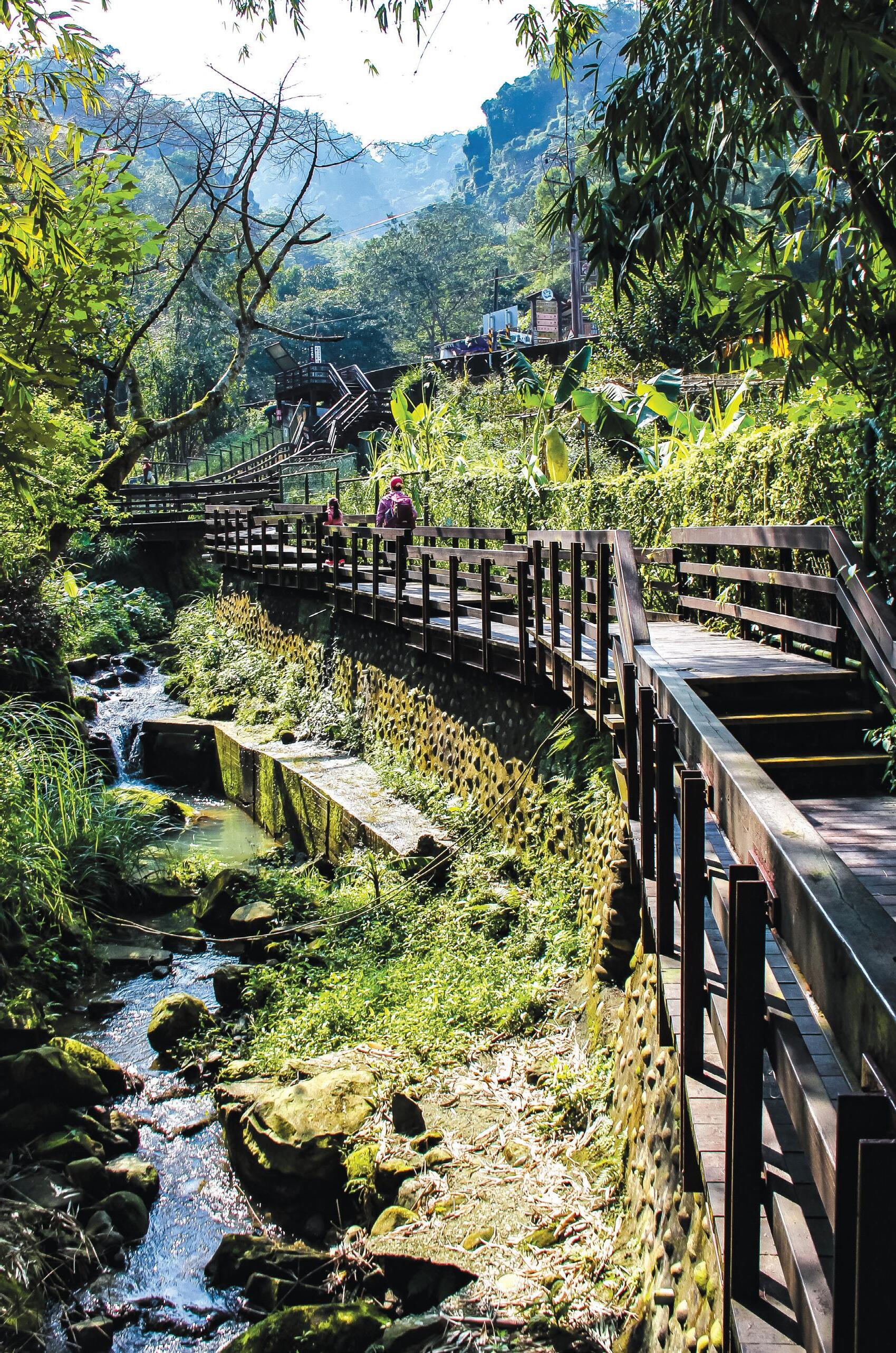
/ 菩提清韵 20 慈悲COMPASSION I 智慧WISDOM I 生活LIFE
规律的节奏里达到静与定的 境界。
我发现,不同的咒语有不同 的节奏:被称为快乐咒的绿 度母心咒是轻快的;而具有 破除魔障之效的普巴金刚 咒,念诵起来则有坚定信心 与滋长勇气的律动感;普及 度最高的六字大明咒,字字 铿锵有力,力量背后是菩萨 无远弗届的慈悲。
每个密咒的语感,都与其蕴 藏的愿力有直接关系。所以, 长期持诵一个咒语,让自己 透过咒语跟诸佛菩萨感应道 交,日复一日积累,一句一 歇,铺展成道,带领我们通往 诸佛菩萨的本心本愿。
礼佛完毕,我静坐蒲团上,隐 隐觉得大殿内的三宝佛,正 微笑凝视着我。然而,我并没
有忘记怎么呼吸,只是一直 不在当下。这次,深切体验收 摄身心,常常只在一呼一吸, 一意一念之间,这或许便是 经典上“闻钟声烦恼轻,智慧 长菩提增”的境界。怪不得学 佛多年的教授一再叮嘱我, 有机会一定要到承天禅寺领 受广钦老和尚遗留的道风, 及众僧修行的磁场。
广钦老和尚修行之路艰苦而传 奇。他在42岁时以念佛法门证 得三昧,虽本修禅宗法门,却 是近代净土宗代表人物之一, 圆寂前一直对弟子与广大信徒 传授念佛法门,揭橥“净土就 是禅”的法理,要求四众踏踏 实实地吃素念佛。据闻老和尚 在福建山洞修行期间,仅以树 薯和野果充饥,所在之地更常 有野猴与老虎出没,但他了无 畏惧,甚至以坚定的道行,感 召猿猴送果,老虎皈依。
老和尚生前信众济济,原来 接见访客的空间,现修葺为广 公纪念堂,以缅怀一代宗师 开山示教之德,里面供奉着 老和尚塑像及三分之一的灵 骨,龛内刻写圆寂前的法语“ 不来亦不去,没有什么事”。
色身虽去,法身常在,像如来 那样“无所从来,亦无所去”。 即是常在,又是不在,更是无 所不在。如果说,诸佛菩萨是 佛教的创行者,那历代高僧大 德就是传递梵音的人,而凡夫 俗子的我们,都是在时间长河 的须臾弹指间,与佛、祖师大 德们相应共振的回音。
何佳原
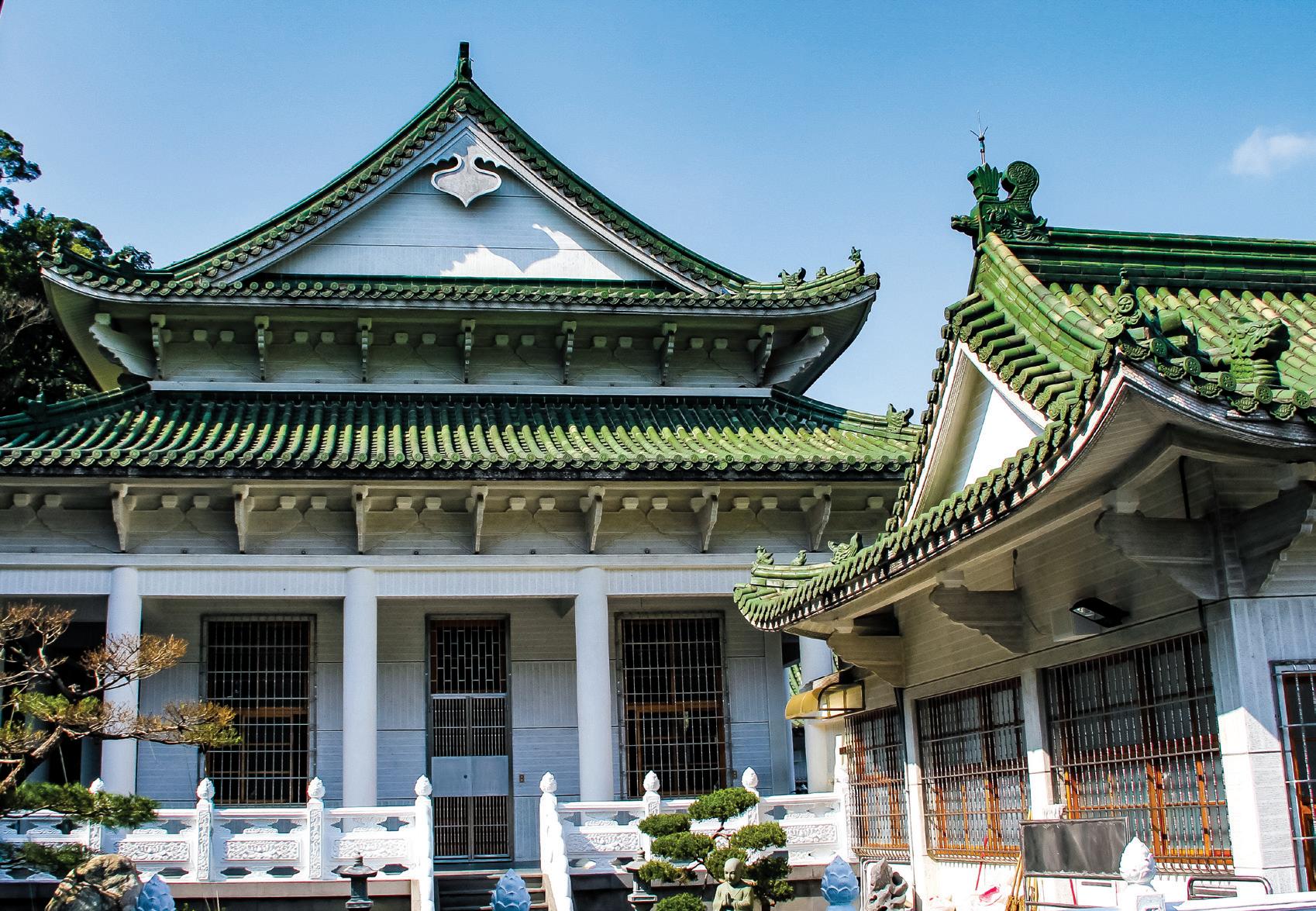
awaken 普觉 I Issue 57 21 慈悲COMPASSION I 智慧WISDOM I 生活LIFE
门中有一首著名的偈 语:“守口摄意身莫 犯,莫恼一切诸有情。无益 之苦当远离,如是行者得度 世。”意思是说,佛弟子应 当严格守护身语意三业,慎 勿犯戒。在日常生活中,对 人应当谦恭礼让,切莫让有 情众生因你的种种过错心生 烦恼。修行虽然需要勤行精 进,但对修道无益之苦也应 当远离。只有能够做到这些 要求的修行者,才能道业有 成,度化众生。
“莫恼一切诸有情”说起来 容易,做起来很难。俗语说: 岂能尽如人意,但求无愧我 心。我们在日常生活中,无 法做到事事都能令人满意。 很多时候,尽管我们做人处 事小心谨慎,但仍然会有照 顾不到之处。可能就因为这 一丁点的疏忽,就会令他人 生起烦恼,乃至心生嗔恨。 俗语说:智者千虑,必有一 失。尽管有时候自己觉得考 虑得很周全,但疏漏之处在 所难免。
自身方面,古人给我们树立 了榜样。曾子曰:“吾日三 省吾身,为人谋而不忠乎? 与朋友交而不信乎?传不习 乎?”我们应当如曾子这样, 每天多次反省自己的言语行 为,不断进德修身,就会减 少令众生烦恼之事的发生。 我们都是凡夫俗子,很难一 下子消除贪嗔之心。尤其是 在遇到令自己不开心之事 时,很多人都难以做到对别 人的诽谤和指责如饮甘露。 当我们的言行令有情众生恼 怒时,自己也一定会感到不 快。此时,就应当修忍辱行, 克制自己的怒气,做到忍受 各种侮辱恼害而没有嗔恨之 心。而不要以怒制怒,恼害 有情众生。当自己言行使人 恼怒时,自己能够忍辱并检 讨自己的言行,就能减少恼 害众生之事的发生。
佛教很多格言警语,不仅是 让我们学习的,更重要的是 要落实在修行实践中。学佛 修行的过程,就是不断修正 自己的过错,“莫恼一切诸 有情”。只有不恼有情众生, 才能与众生建立和睦相处 的关系,不断提升自己的修 养,才能进道修身。
正因为我们常会有各种缺 点和不足,因而就需要依照 这首偈语的要求来修行。在 与人来往的过程中,当遇到 因自己的言行引发他人恼 怒时,应当及时检讨自己的 言行是否有过错。做到有 则改之,无则加勉。在反省

佛
不恼有情众生, 才能与众生建立 和睦相处的关系,
/
22 慈悲COMPASSION I 智慧WISDOM I 生活LIFE
不断提升 自己的修养, 才能进道修身。
远尘
菩提清韵
莫 恼 一

有 情
awaken 普觉 I Issue 57 23 慈悲COMPASSION I 智慧WISDOM I 生活LIFE
切 诸
《吉祥经》
中的伦理思想
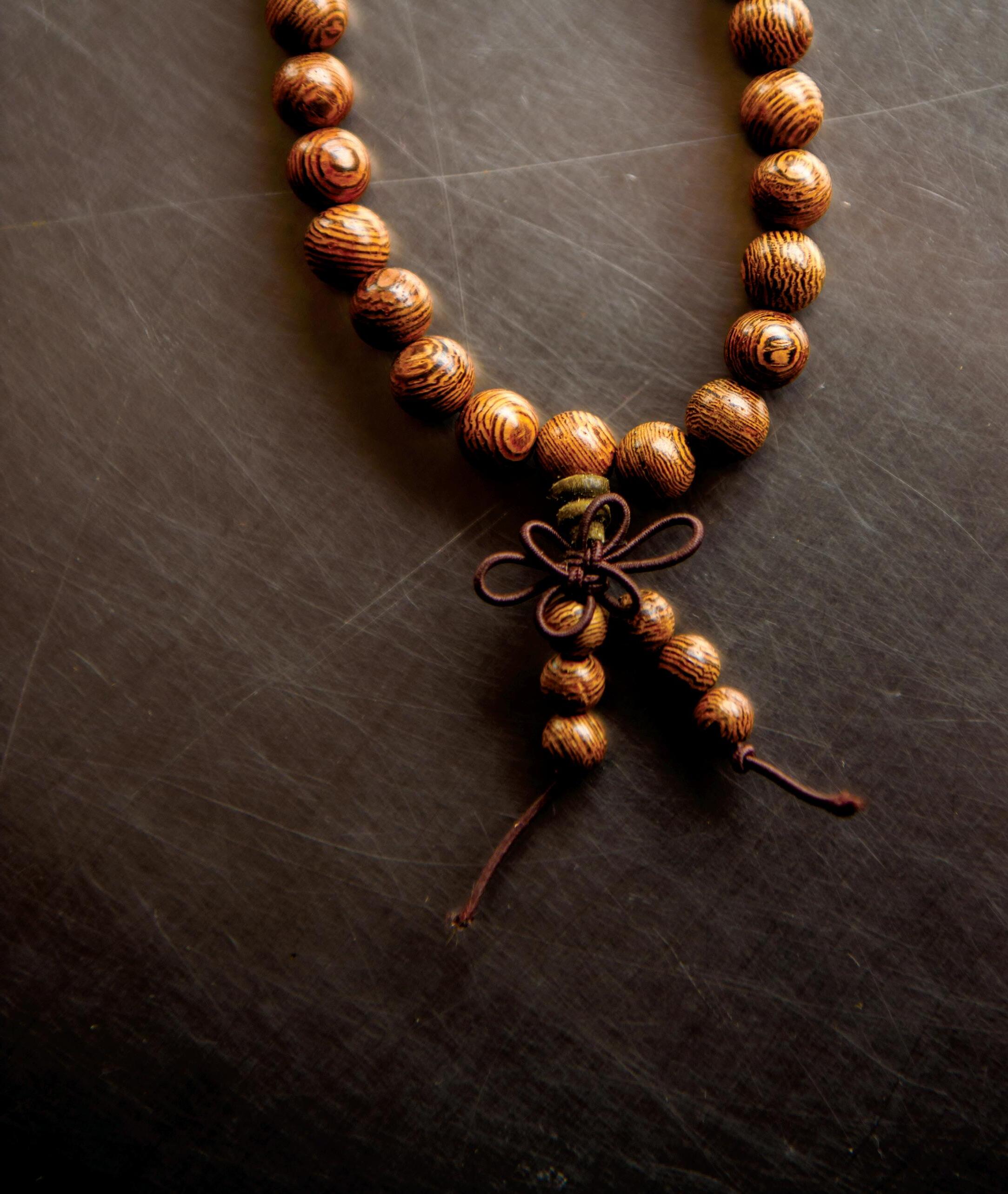
/ 法海拾贝 24 慈悲COMPASSION I 智慧WISDOM I 生活LIFE
《吉祥经》是讲说修行者应 当如何修学可获得幸福吉祥 的经典。在这些修学方法中, 有一部分是关于伦理关系的 内容。佛陀认为,一个人若能 妥善处理好人伦关系,就能 过上幸福吉祥的生活。
一、应与智者交
我们在交友时,一定要谨慎 选择,若与恶友交往,久而 久之,自己就会变成一个恶 人;若与善人交往,则自己会 被熏染成善人。佛告诫,交 朋友时不要结交愚痴的人, 应当与有智慧的人交往。愚 痴的人,不仅不能带给朋友 有益的帮助,还往往因自己 的愚痴,拖朋友的后腿,使朋 友难以进步。当与有智慧的 人结为好友,智友会帮助你 改正身上的缺点和毛病,促 使你每天都能得到进步。天 长日久,在智友的熏陶和引 导下,自己也慢慢变成智者。
二、奉养父母亲 一个人要想过得幸福快乐, 首先应当孝养父母。孝养父 母是做人最基本的义务。父 母含辛茹苦养育子女长大成 人,当他们年老后,子女应当 承担起孝养父母的责任。
《观无量寿经》说,修学净 土之人,应当以修学净业三 福为基础。三福第一为“孝 养父母,奉事师长,慈心不 杀,修十善业”。所谓孝养父 母,就是在父母健在时,要 给予衣食供养和精神关爱。
《善生经》指出:一为人子女 者,要对父母提供物质供养, 使父母在物质方面不至匮 乏;二要求子女不管做什么 事,都应当事先告诉父母,征 求意见,以示对父母的尊重, 也能免却父母的挂牵;三子 女对父母的所作所为恭顺不 逆;四子女对于父母正确的、 对自己成长有益的指令不能 违背;五子女不要破坏父母 所从事的正当职业。
一个人在结交朋友时,要选择 那些能够指出你的缺点,帮 助你进步的人做朋友。谨防 那些以利相交,或是怀有各 种目的与你相交的恶友。《善 生经》中介绍了酒友、赌友、 淫逸之友、歌舞之友等四种 恶友,这些恶友只会把人引 上邪路,对自己有百害而无 一利。因此,我们在结交朋友 时,一定要依遵佛言:勿近愚 痴人,应与智者交。只有与智 者交往,才能因智者的指点, 督促自己远离无明。
此外,如果仅仅给父母衣食 之需,却不能达到态度的和 悦,也算不上孝顺。因此,对 父母的恭敬顺从是孝养父母 的核心和最基本的要求。
三、爱护妻与子
夫妻是组成家庭的基础,夫 妻之间是否互敬互爱、互帮互 助,则直接关系到家庭的稳定 与和睦。在一个家庭中,男主 人是一家之主,担负着养家糊 口的责任。男人在家庭中要爱 护自己妻子、儿女,不仅让他 们物质上衣食无忧,而且还要 从精神上关心爱护他们,让他 们过得幸福快乐。
一个人若能妥善 处理好人伦关系, 就能过上幸福 吉祥的生活。
awaken 普觉 I Issue 57 25 慈悲COMPASSION I 智慧WISDOM I 生活LIFE
《善生经》中指出,丈夫对 待妻子首先要做到以礼相 待。对一个男人来说,妻子 是他一生中最亲的人,也是 能够终生相伴、相互扶助的 人。所以丈夫对妻子要以礼 相待,勤加爱护,建立一种相 濡以沫的夫妻关系。其次, 对妻子尊重但不要轻慢,令 其身心自在。只有夫妻之间 对内对外相互配合,才能将 家庭管理得井井有条。
男人对妻子而言是丈夫,对子 女来说是父亲。父亲不仅要 爱护妻子,对儿女也要同等爱 护。不仅要给子女衣食之需, 还要呵护子女健康成长。在孩 子嗷嗷待哺的幼年时期,父 亲应当关心儿女的冷暖,配合 妻子抚育儿女健康成长。待儿 女稍懂事时,应当教他们明白 事理,并学习文化知识。待子 女入学后,父亲也应该分配时 间,参与督促子女的学习,让 学业均衡发展,不可偏废。同 时,还要教他们为人处世的道 理,不仅学习好,还要成为品 行也好的人。
四、帮助众亲眷 一个人当在财富或智力方面都 超过亲眷时,应当关心爱护六 亲眷属中的弱者,让他们在你 的帮助下生活困境能得到改 善,从而一起发展进步。当有 能力帮助别人时,就应当以佛 教无缘大慈,同体大悲的教 理,不仅从财物上帮助亲友, 还应当从精神上去关心爱护他 们。切不可因自己在某方面优 越就看不起亲眷,甚至于唯我 独尊,盛气凌人。
总之,本经从结交朋友、奉养 父母、爱护妻子、帮助亲眷等 多方面论述了佛教应当遵循 的伦理关系。我们在日常生活 中,如果能依照经中所言来处 理各种人伦关系,就一定能成 为一位既有爱心,又能善始善 终,并且具有亲和力的人。
禅悦
/ 法海拾贝 26 慈悲COMPASSION I 智慧WISDOM I 生活LIFE

awaken 普觉 I Issue 57 27 慈悲COMPASSION I 智慧WISDOM I 生活LIFE
供佛斋僧
的起源与功德
佛斋僧是佛教重要的 修行方式之一,也是信 众培植福报、消除业障、积 功累德的修福方式。
供佛斋僧源自于神通第一的 目犍连尊者。尊者的母亲生 前不信因果,谤佛谤僧,贪瞋 邪恶,死堕饿鬼道中受无量 苦,咽小如针,皮骨连结,食 未进口,化成灰炭,尊者以天 眼视之,见状不忍。尊者问

供
/ 法海拾贝 28 慈悲COMPASSION I 智慧WISDOM I 生活LIFE
佛陀怎样做才能使自己的母
亲脱离苦海?佛告诉说:“你 母亲生前造业太多,凭你一个
人的力量和功德是不够的,
是没有办法救出你母亲的,
只有于七月中设斋供养十方
僧众,以此斋僧功德之力,其 母即于是日,脱离饿鬼之苦。”
因此,尊者遵照佛说,在农历
七月十五日设斋供养广大僧
众,故知供养十方大德圣僧, 或修行僧或证果罗汉或十方
菩萨现比丘僧众等,其功德
如大海之深广,难思难议,能
令现世父母褔乐百年,内外吉
祥,乃至七世父母能得解脱,
出离三途之苦,故应知设此
盂兰盆供佛及僧,是报答现 世父母生养抚育慈爱之恩, 超荐累劫父母之功德妙法。 供佛及僧的功德非常殊胜, 佛赞教导说:“以后佛弟子, 如果要行孝道就应在七月十 五日供僧,并以供僧功德回 向给过往的亲人,此功德不 只可以救度这一世的父母, 甚至也可以救度七世的父 母。”因此,七月十五日的“ 盂兰盆节”是佛教中最大的 节日之一,也是佛教徒举行 供佛斋僧和超度历代宗亲的 重要日子。
《佛说布施经》说,若以上 妙乐饮食供养三宝,得五种 利益:一者身相端严,二者气 力增盛,三者寿命延长,四 者快乐安稳,五者成就辩才。 《俱舍论》也说:“若能一昼 夜持不杀戒,于未来生,决 定不逢刀兵灾;若能以一粒 诃子,以殷净心奉施僧众,于 当来世,决定不逢疾疫灾; 若以一抟之食,起殷净心奉 施僧众,于当来世,决定不 逢饥馑灾。”《分别善恶报 应经》说:“若复有人斋食供 养佛及众僧,功德有十。云 何为十?一寿命延长,二形 色圆满,三肢节多力,四记 忆不忘,五智慧辩才,六众 睹欢喜,七丰足珍宝,八人天 自在,九命终生天,十速证 圆寂。如是十种胜妙功德, 施佛及僧,斋食供养获如斯 果。”《盂兰盆经》说:若能 以饭食、卧具、医药供养十 方僧众,藉此十方僧众清净 共修,功德回向之力,能使 供养者,往昔七世父母、六 亲眷属得远离三恶道,现世 父母及其本人,长寿无病无 恼,衣食自然具足,身心安
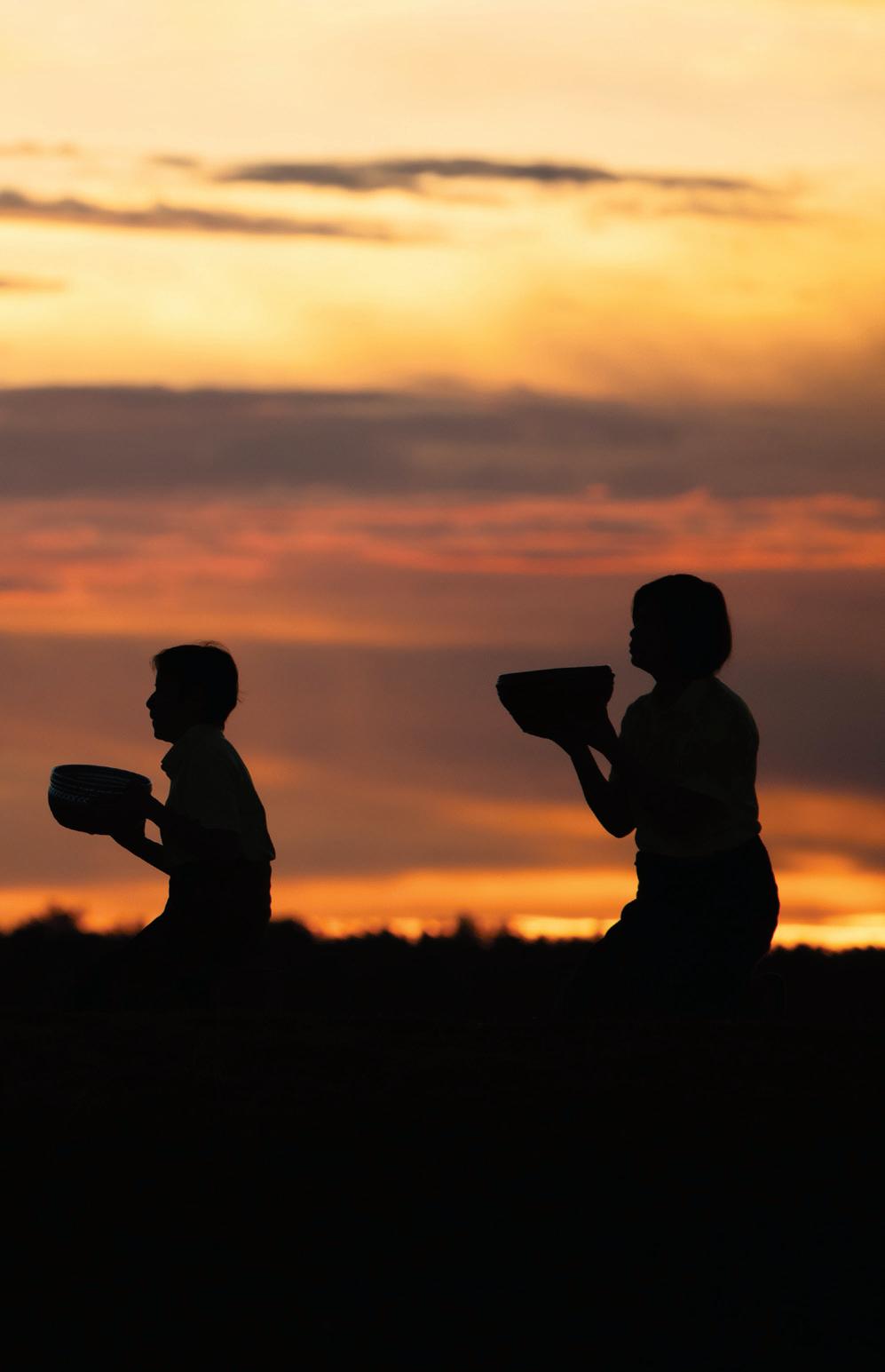
乐。由此可见,供养僧众的 功德不可思议,不仅可以获 福无边,而且还可以以此功 德消灾免难,利益有情。
正法弘扬本在僧,僧人是三 宝之一,僧人放下尘缘,剃度 出家,安心办道,弘扬佛法, 旨在令众生转迷成悟,转凡 入圣,转识成智,脱离苦海。 僧宝是一切世间供养、布 施、修福的无上福田。供僧 就是一种清净的供养,能让 众生当下远离烦恼,除心束 缚,得清净心,法喜充满。我 等发心设斋供众成就道场, 不仅能广结善缘、减轻业障, 长养布施喜舍之心,更为将 来深植出世的菩提善因。
出家众仰仗修行,进德修业; 在家信众以供僧功德,福慧 增长。由于信徒布施道粮, 供养有道、有学的出家人,让 他们没有物资的缺乏,而能 积极弘法利生,将佛法遍布 世间,居士于此因缘供僧,可 谓护法护教的菩萨行。也因 此,生生世世与三宝结清净 善缘,功德无量无边。
马行荣
供僧就是一种清净 的供养,能让众生 当下远离烦恼, 除心束缚, 得清净心, 法喜充满。
awaken 普觉 I Issue 57 29 慈悲COMPASSION I 智慧WISDOM I 生活LIFE
求生西方净土的 三种发心
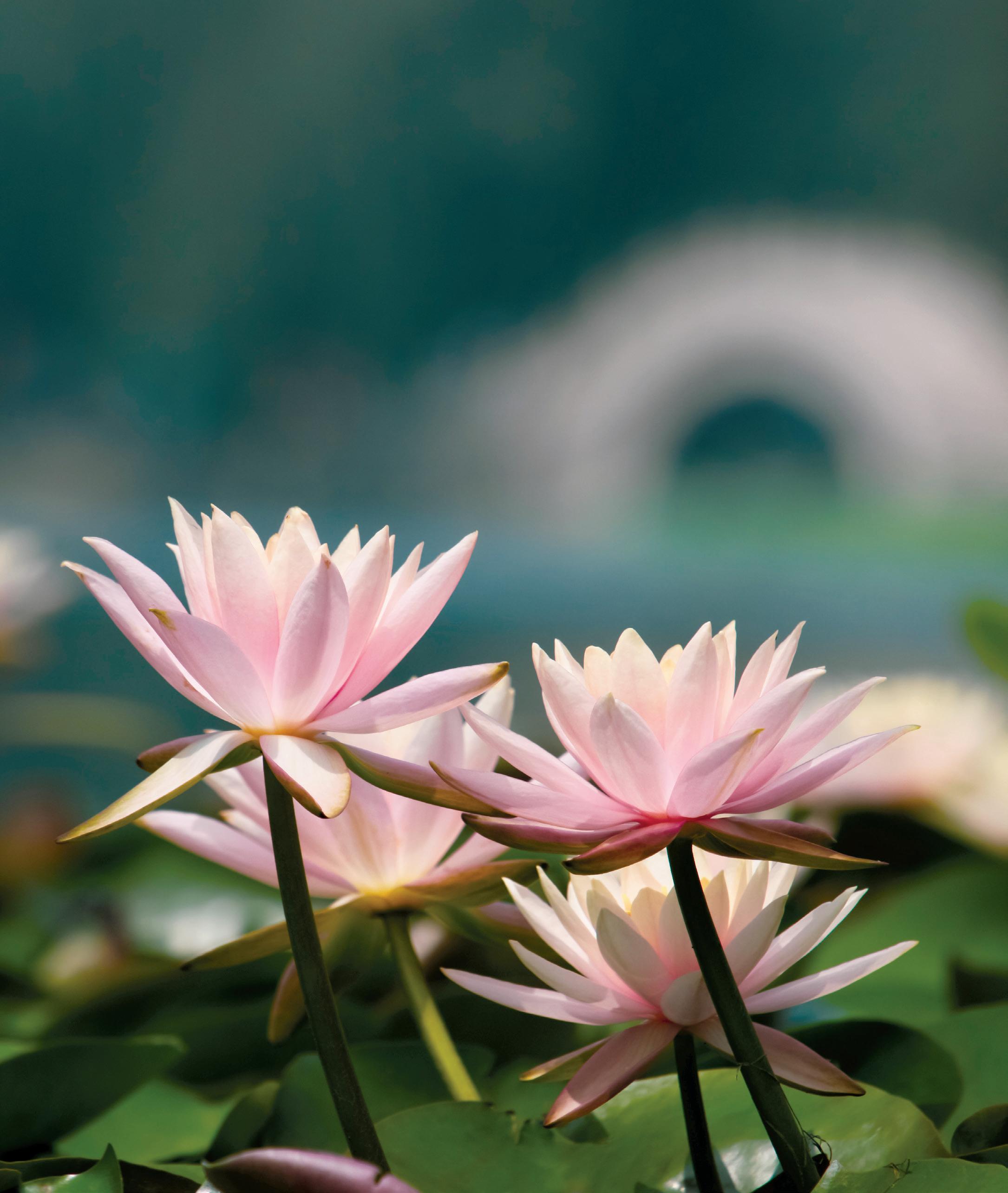
/ 法海拾贝 30 慈悲COMPASSION I 智慧WISDOM I 生活LIFE
求 生西方极乐净土是修学 净土法门之人的终极目 标。净业行人若欲求生西方极 乐国土,不仅要具足信愿行三 资粮,而且还要发至诚心、深 心、回向发愿心等。修行者若具 足这三种心,则必能往生极乐 净土。
一、至诚心 至诚心,是指真实愿生净土之 心。净影慧远之《观无量寿经义 疏》称,诚心者,起行不虚,实心 求去。对修净土的人来说,只有 发真诚求生净土之心,才能为实 现这种愿望切实努力修行,以期 早日往生净土。善导大师在《观 经四贴疏》中说:“至诚心,至 者真,诚者实。欲明一切众生身 口意业所修解行,必须真实心中 作,不得外现贤善精进之相,内 怀虚假,贪瞋邪伪,奸诈百端, 恶性难侵,事同蛇蝎,虽起三 业,名为杂毒之善,亦名虚假之 行,不名真实业也。”大师认为, 所谓至诚心,就是真实无伪之 心。《往生礼赞偈》亦云:“至诚 心者,身业礼拜彼佛,口业赞叹 称扬彼佛,意业专念观察彼佛, 凡起三业必须真实。”就是说, 修净土之人,要身口意三业谦恭 至诚拜佛、赞佛、观佛,方可称 为真实。
二、深心
深心,指信乐殷切至诚,欲 生西方极乐国土,即深愿净 土之心。《观无量寿经义疏》 云:“求心殷重,故曰深心。”
《观经四帖疏》云:“言深心 者,即是深信之心也。亦有二 种:一者决定深信自身现是,
罪恶生死凡夫,旷劫以来常 没常流转,无有出离之缘;二
者决定深信彼阿弥陀佛四十 八愿,摄受众生,无疑无虑, 乘彼愿力,定得往生。”即
深心包涵两方面涵义:一是 要深信自身现是罪恶生死凡 夫,旷劫以来常在生死中流 转,没有出离生死的殊胜机 缘;二是要深信阿弥陀佛的 四十八大愿,每一愿都是在 摄受众生。只要对四十八愿 深信不疑,并发愿求生,念佛 修行,就一定能往生西方。
直心则能发行,随其发行则得 深心,随其深心,则意调伏。” 这种对深心的解说,同样适用 于求生西方净土。
三、回向发愿心
又云:“深信者,仰愿一切行者 等,一心唯信佛语,不顾身命, 决定依行。佛遣舍者即舍,佛 遣行者即行,佛遣去者即去, 是名随顺佛教,随顺佛意,是 名随顺佛愿,是名真佛弟子。” 修净土法门者,还应当一心唯 信佛语,不顾身命,决定依照 佛言修行。佛说让舍弃的就立 即舍弃;佛命修行的就立即修 行,这就叫作随顺佛意,随顺 佛愿,方可称为真佛弟子。
《往生礼赞偈》云:“深心者, 即真实信心,信知自身是具足 烦恼之凡夫,善根薄少,流转 三界,不出火宅,今信知弥陀本 弘誓愿,及称名号,下至十声一 声等,定得往生,乃至一念无 有疑心。”
在佛典中,深心通常指深求佛 道之心,或指扫除犹疑不定而 对佛法真实确信之心,或指乐 集诸功德善行,又深信爱乐之 心。《维摩诘经》云:“深心是 菩萨净土,菩萨成佛时,具足 功德众生来生其国。……随其
回向发愿心,是指将自己过去 世及今生身口意三业所修的世 间善业与出世间的善根,以及 随喜其他一切凡圣所修的世间 善法与出世间功德,悉皆于真 实深信心中,回向愿生西方净 土。能将一切修行功德如是回 转趣向往生的目标上,即名回 向发愿心。此心的另一含义是 说,欲将自己所修的善根、功 德回转给众生,使往生净土。 善导大师指出:“又回向发愿 愿生者,必须决定真实心中回 向愿作得生想。此心深信,由 若金刚,不为一切异见异学, 别解别行人等之所动乱破坏。 唯是决定一心,投正直进,不 得闻彼人语。即有进退,心生 怯弱,回顾落道,即失往生之 大益也。”就是说,回向发愿 愿生西方净土的人,必须从真 实心中回向发愿作往生西方 净土之想。将自己的一念深信 心,固若金刚,不会被异见异 学,别解别行之人所动乱破坏 或心生怯弱。
修学净土法门的人,若能在修 学的同时,具足至诚心、深心和 回向发愿心,临命终时,就能往 生西方净土,得上品上生。
张瑞
将自己的 一念深信心, 固若金刚,
不会被异见异学, 别解别行之人所动 乱破坏或心生怯弱。
awaken 普觉 I Issue 57 31 慈悲COMPASSION I 智慧WISDOM I 生活LIFE
大师 铺路 后人 遮阴
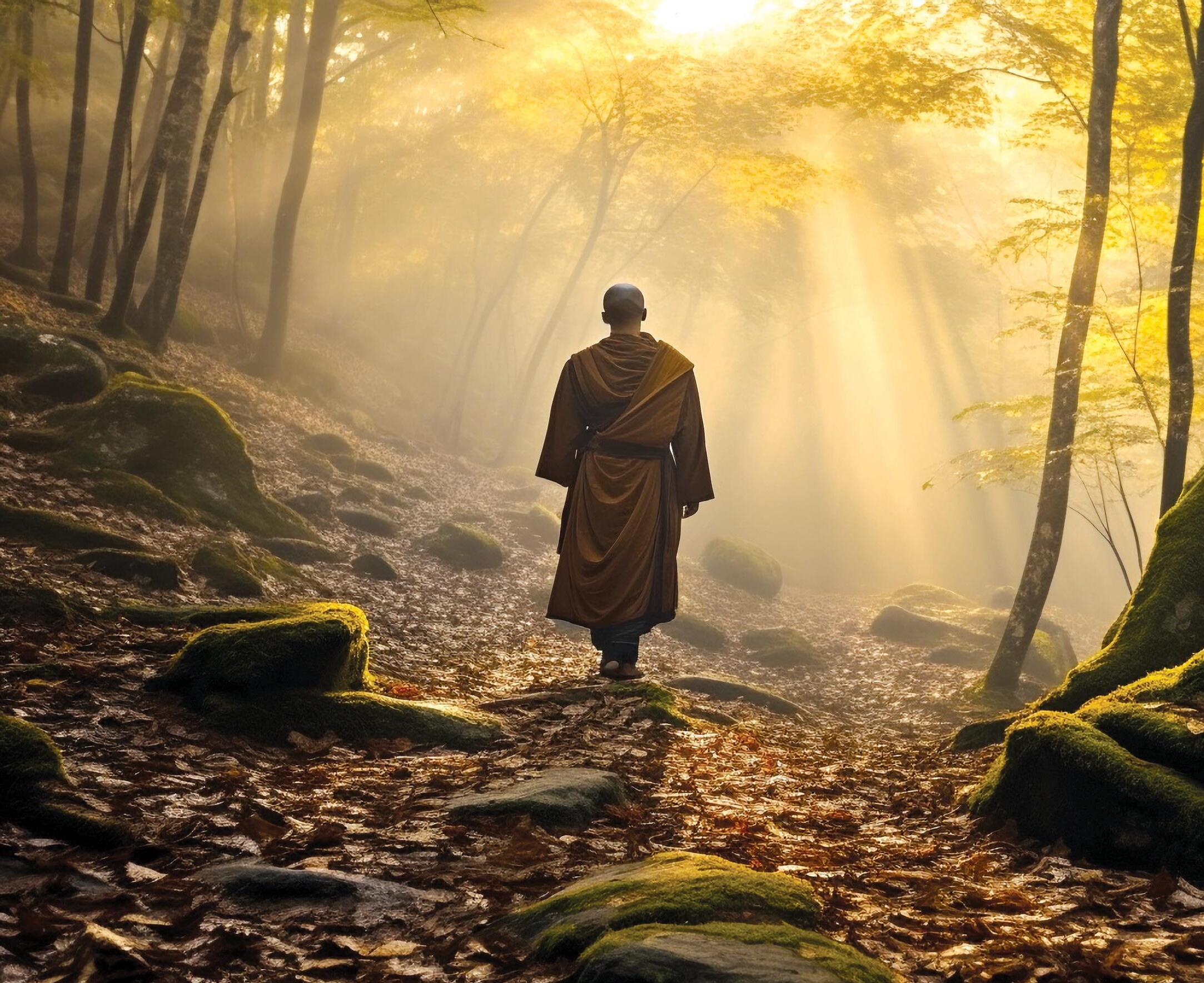
/ 竹林夜话 32 慈悲COMPASSION I 智慧WISDOM I 生活LIFE
正 当众人还沉浸在元宵 佳节气氛中,就在2月 5日下午,众人敬仰的佛光 山的创办人——星云大师圆 寂,享耆寿97岁。
一个时代的大师的陨落了, 不舍的是我们的凡夫心,看 淡生死的大师早在十年前就 写下“真诚的告白”一文,一 一交代“身后事”。其中一段 写到:“我一生,人家都以为 我很有钱,事实上我以贫穷 为职志。我童年家贫如洗, 但我不感到我是贫苦的孩 子,我心中觉得富有。到了老 年,人家以为我很富有,拥有 多少学校、文化、出版、基金 会,但我却觉得自己空无一 物,因为那都是十方大众的, 不是我的。在世界上,我虽然 建设了多少寺院,但我不想 为自己建一房一舍,为自己添 一桌一椅,我上无片瓦,下无 寸土,佛教僧伽物品都是十 方共有,哪里有个人的呢?但 在我的内心可又觉得世界都 是我的。”
我想,这就是对我 最好的怀念,也是 我所衷心期盼。”
大师的文字行云流水,从个人 到佛光山,从两岸关系、慈善、 教育,到丧礼安排等方方面 面,全文超过五千余字,仿佛 他本人亲临为我们娓娓道来。 许多悼念大师的文章纷纷涌现 在社交媒体中,分享与大师相 处的回忆,处处体现大师的幽 默与智慧。其中台湾作家李开
复,提到和大师的一段对话, 让我着实受益。
李先生请教大师,要以什么 态度来面对社会上的“恶”, 大师说:“一个人倘若一心除 恶,表示他看到的都是恶。 如果一心行善,尤其是发自 本心地行善,而不是想要借 着行善来博取名声,才能导 正社会,对社会产生正面的 效益。”这些话不只是带给 李先生深刻启示,对于我以 及很多想行善,对“恶”也看 不顺眼的人来说,无疑起着 警惕作用。
我二十多年前皈依佛教,就是 于大师所主持,在柔佛新山地 不佬体育馆举办的大型弘法会 的集体皈依典礼中完成,法名 惟珍,那时获赠《迷悟之间》 一书让我爱不释手。《迷悟之 间》曾是大师所创办之《人间 福报》的头版专栏,每篇针对 人世间的“迷”与“悟”,剖析 社会问题的症结,以及人心的 种种善恶好坏。大师充满智慧 的洞见与深具新意的观点,让 人读起来满心欢喜。
大师所著的《释迦牟尼佛传》 是我第一部接触的佛陀传,相 信这本书很多人都曾阅读过, 称得上是学佛的入门书。九十 年代到两千年间,大师来过大 马几次。在吉隆坡念大学时, 我有机会参与马来西亚佛光山 举办的“佛教靠我”青年研习 会,近距离见到大师本人。大 师身材魁伟,一脸笑嘻嘻的样 子,总是让人感到很欢喜。大 学毕业后,在新加坡的佛教杂 志社上班,有缘访问大师,印 象深刻,因为师父的扬州口音 我听不懂,在同事的协助下,才 得以顺利完成这篇专访。

大师说:“如果大家 心中有人间佛教, 时时奉行人间佛教,
awaken 普觉 I Issue 57 33 慈悲COMPASSION I 智慧WISDOM I 生活LIFE
找回当时2005年的访问稿, 其中一题就问大师如何看待 生死,他说:“我比较不关注 这个问题,因为生老病死不是 我能够阻止的。我是把色身交 给我们的常住,把我的性命付 给龙天护法。什么时候生,什 么时候死,我不太计较。该生 的时候生,该死的时候死,生 也未尝生,死也未尝死,生死 只是一时的现象而已,生命是 永恒的。我们不是一期生命 结束,生命生生世世,世世 生生,是无限延续的。像我 出家六、七十年了,快八十岁 了。我和别人对生死的看法 有一点不一样,不过也不需 要人人跟我一样。我想,一个 人在世时,要活得有价值,把 生命活得潇洒、自在,来到世 间是为了欢喜而来的,不是 为了忧愁悲伤、分别烦恼而 来的,大家要面对自己。”
大家要面对自己,这句话深 切地打动了我。我们一般人 或许活不到大师的高度,那 至少,也要对得起自己,清醒 地活着。
结束新加坡的工作,我来到 大师创办的台湾嘉义南华大 学念书,非常感恩大师创办了 这所大学,让我有这样的机会 再继续深造,修读出版所。由 于大学设有宗教所,我时常 找机会去旁听,打开了我的视
野。在这所大学,留下了许多 美好的回忆,亦结识了良师 益友,是我最大的收获。
长期以来,大师积极推动文 化教育,指导监修《佛光大 藏经》、《佛光大辞典》。相 继成立“佛光出版社”、“佛 光山文教基金会”、创办“香 海文化”、设立“人间卫视”。 发行《人间福报》,成为第一 份由佛教界发行的日报。此 外,大师一生著作无数,辑成 《星云大师全集》395册出 版发行,逾4千万字。
一直走在佛教道路上,大师 铺路,后人遮阴。
大师说:“如果大家心中有 人间佛教,时时奉行人间 佛教,我想,这就是对我最 好的怀念,也是我所衷心期 盼。”
感恩师父,衷心祈盼您乘愿 再来。
惟珍
/ 竹林夜话 34 慈悲COMPASSION I 智慧WISDOM I 生活LIFE

awaken 普觉 I Issue 57 35 慈悲COMPASSION I 智慧WISDOM I 生活LIFE
生病 与 瞻护病人 的功德方法

/ 磐陀钟磬 36 慈悲COMPASSION I 智慧WISDOM I 生活LIFE
佛教认为人生有八苦,其
中最痛苦的莫过于病 苦。人的一生不过几十年光 景,在这短暂的人生当中,谁 都无法逃避疾病的折磨。因 此,一个人生病是免不了的, 但是如果我们能够经常探视 病人,给予关心和安慰,就能 够减轻他们的病痛,增强战 胜疾病的信心。
当一个人健康的时候,也许
感觉不到疾病给人带来的痛 苦。而当一个人疾病缠身的时 候,他才会感觉到健康的重 要。那时会想,如果病好了, 一定要好好地珍惜健康,真 心善待他人。对于身患小毛 病的人来说,疾病带给的痛 苦也许并不明显。但是对那 些身患重病的人来说,那种 求生不得,求死不能的痛苦, 着实令人难以忍受。在现代 社会中,随着生活条件的改 善,人所产生的各种各样的 疾病也日渐多了起来。
身体的疾病有的还比较容易 治愈,而心理的疾病却远比 身体疾病要难以治疗。现代 人由于工作、学习或生活的压 力不断增大,出现了各种心理 疾病,有很多人因为心理疾病 得不到有效地治疗,最终变 成悲剧,给亲人带来了无尽 的伤痛。
一个人在生病时会经历许多
健康人体会不到的痛苦。此 时的他们,需要别人细心的 照料和精神的安慰,这样才 有利于病情恢复。佛住世时, 十分重视患病比丘的探视。
佛陀认为,探视照应病人不 仅是广行善事,还是为了多结 人缘。据经典载,一次佛见一 个比丘病得很厉害,一个人躺
在床上。就上前问他:“你为 什么在生病时没有人照应?” 生病比丘说:“因我平时很懒, 从不知道关心别人,在别人有 病时,我也没有耐心去看护别 人,所以我现在病了也没人来 看护我。”佛知道他因为没有 人缘,所以生病时没人来照应 他,就说:“你不要担心你的 病,我现在来护理你。”于是, 佛陀亲自给他打水沐浴,清洗 大小便等各种不净,又给他打 扫出来一间干净温馨房间,铺 设好床铺,以善言安慰他,耐 心服侍他的饮食起居,直到病 好为止。
经过此事后,佛便立下规矩, 在僧团中,凡有僧人生病时, 应由和尚、阿阇梨及诸弟子 从亲至疏,次第轮流担任照 护工作。假使病人没有这些 有关系人,要在大众僧中派 出人来担任照护工作。佛劝 诫大众,应当自动发心照顾 病人,抚慰病人,能随顺佛 语,供养病人,也就等于供养 佛。不但同住的人有病应互 相照顾,就是在旅途中遇到 人生病,也应当在可能范围 内,尽量予以帮助照应。
佛陀认为,世间最大的布施 是探视病人,如果一个人经常 看护病人,就能得到很大的
功德。所以,佛劝告弟子一定 要学会照应病人。
佛陀不仅要人探视照顾病 人,而且还提出了照顾病人 的具体方法。《增一阿含经》 有“瞻病五法”:即作为一个 护理病人者,应当能为病人辨 别药物的好坏;能善言安慰 病人,增强病人战胜疾病的 信心;看护病人时要减少睡 眠,以随时照应病人所需;还 要不贪图饮食;最好能懂得 佛法,开导病人顺应人生的 各种无常。
历代祖师也都很注重对病人 的探视与看护,认为照护福田 是世间第一福田,而且还是 广结善缘的最好方法。
其实,人的一生,谁都无法避 免病苦的折磨。当你处于疾 病折磨时,应当深切体会到 作为病人的痛苦,应该时常 想到康复后,应当多关心照 顾那些正在遭受疾病磨难的 人;如果你是身体健康者,也 应当听从佛陀和历代祖师的 教导,设身处地的为病人着 想,多探视身边的病人,从物 质和精神上给他们无微不至 的关怀,帮助他们树立战胜 病魔的信心,从而早日摆脱 病痛的折磨。
善缘
人的一生, 谁都无法避免 病苦的折磨。
设身处地的为 病人着想, 帮助他们树立 战胜病魔的信心。
awaken 普觉 I Issue 57 37 慈悲COMPASSION I 智慧WISDOM I 生活LIFE
息灭 妄想

/ 磐陀钟磬 38 慈悲COMPASSION I 智慧WISDOM I 生活LIFE
很
多人会把生命的痛苦 归之于客观环境:诸如 身体欠安,生活清贫,世道不 公……其实,这些只是造成痛 苦的客观原因,而它产生的真 正根源来自我们的心念。

我们心中充满种种妄想,如 错误的观念、迷信、执著、贪 嗔邪见等等,都是妄想的表 现。妄想使我们的内心失去 平静;妄想使我们陷入永无 止境的追求;妄想使我们寻 求各种刺激;妄想还会使我 们胡作非为。所以,要解脱痛 苦,就必须息灭妄想。
无住、空灵的心,对一切境界 如雁过长空,风吹竹叶,不留 一丝一毫的踪迹。心清净了, 打坐时自然不会妄想连翩。
念佛也能息灭妄想。人们往 往将念佛误解为老婆婆专修 的法门,或以为念佛是在求 佛。有个故事说,一位老婆婆 整天念佛,小孙子听得很厌 烦,于是就奶奶、奶奶地叫个 不停。老婆婆嫌吵:“没完没 了地叫什么?”孙子说:“我叫了 几声你就烦,可你总是不停地 念佛,佛难道就不烦吗?”故 事中小孙子的看法,代表了许 多人对念佛的误解。事实上, 念佛是为了调御自己的心态, 息灭自己的妄想,所谓“清珠 投进浊水,浊水不得不清; 佛号注入妄心,妄心不得不 净。”《大势至菩萨圆通章》 中说:“都摄六根,佛号相 续,息灭妄想,深入禅定。” 所以说,念佛是用来对治我 们妄想的最佳方法之一。
如何才能息灭妄想?经常听很 多初学打坐的人说:打坐时妄 想太多,静不下来,有什么办法 可以对治?办法当然是有的, 但我们需要先考察一下,为什 么会有这些妄想的出现?
我们的心念有前后延续性, 如果想在静坐时能够专心, 日常生活中就要时刻注意用 心。打坐时出现得最频繁、最 强烈的妄想,一定是我们平 时最执著的境界。因此,一个 修习静坐的人,在生活中要能 够观照一切,从而保有一颗
止观能息灭妄想。止观乃禅 定之异名,梵语奢摩他,汉译 曰止,止息散乱,止心一处; 毗钵舍那,汉译曰观,是对所 止境起正观察。止观有小乘 止观与大乘止观之分。小乘 止观从六根门头摄一而入, 系缘而修。如修数息观就是 专注呼吸,知息出入、知息长 短、知息冷暖、知息粗细。把 心念系在呼吸之上,心息相 依,由粗而细,由细而无,待 妄想息灭,止观也就成就了。 观心能息灭妄想。观心是
妄想是 痛苦产生的根源,
awaken 普觉 I Issue 57 39 慈悲COMPASSION I 智慧WISDOM I 生活LIFE
要在根本上断除 我们的痛苦, 就要从 息灭妄想着手。
观察自己心念的起灭,我们 的心如流水一般念念相续, 平常人缺乏观照能力,总是 随着念头东奔西跑,不能自 己。观心是要认识到心念的 虚妄性,心念无非是由一系 列的经验和概念组成,离开 这些经验和概念,我们的心 究竟是什么?所以《金刚经》 告诉我们:“过去心不可得, 现在心不可得,未来心不可 得。”这是从时间上透视心念 的实质。过去心不可得,是说 过去的就让它过去,不要陷入 追忆,也不要随着它跑;未来 心不可得,是说未来还没有到 来,不必去想它。在前念过去 而后念未生之际,保持中间这 段清明、干净的心,所谓“生灭 灭已,寂灭现前”。《楞严经》 说:“狂心顿歇,歇即菩提。”
临济禅师说:“沿流不止问如 何,真照无边说似他,离名离 相人不禀,吹毛用了急须磨。”

这都是教我们从观心中认识真 心,保养真心。
参话头能息灭妄想。参话头也 是禅宗修行的重要方法之一。
话头通常有:念佛是谁?父母 未生前本来面目是什么?无梦 无想时主人是谁?一念未生 前是什么……参话头不可对 话头下注解,不可以推理,不 可以等开悟,不可以扔掉话头 求静,不要给自己讲道理,外 界动静一概不管,一路追问下 去。黄龙南禅师对参话头有个 比喻:“如灵猫捕鼠,目睛不 瞬,诸根顺向,首尾一直。”参 话头重在一个“疑”字,祖师
云:“大疑大悟,小疑小悟,不 疑不悟。”要把自己全部身心 凝聚在话头上,如同活死人一 般,不达到这个程度,不算上 路。一个修行人,当话头参到 得力时,专注一念,心无旁骛, 妄想自然也就无从生起。
妄想是痛苦产生的根源,要 在根本上断除我们的痛苦, 就要从息灭妄想着手。当我 们的妄想得到有效的控制, 我们就不会被它所转,就能 拥有一颗平静的心;我们就 不会被妄想分散我们的精 力,就能提高工作和学习的 效率,专心地去做任何事;我 们就不会被妄想所干扰,就能 把心念专注一处,进入禅定的 状态;我们就不会被妄想遮蔽 我们本具的佛性,就能使我们 的真心得以显现,智慧得以开 发;我们就不会被妄想带来的 错误认识所左右,就能使我们 对宇宙人生有正确的认识…… 所以说,息灭妄想的重要性是 不容忽视的。
/ 磐陀钟磬 40 慈悲COMPASSION I 智慧WISDOM I 生活LIFE
济群法师
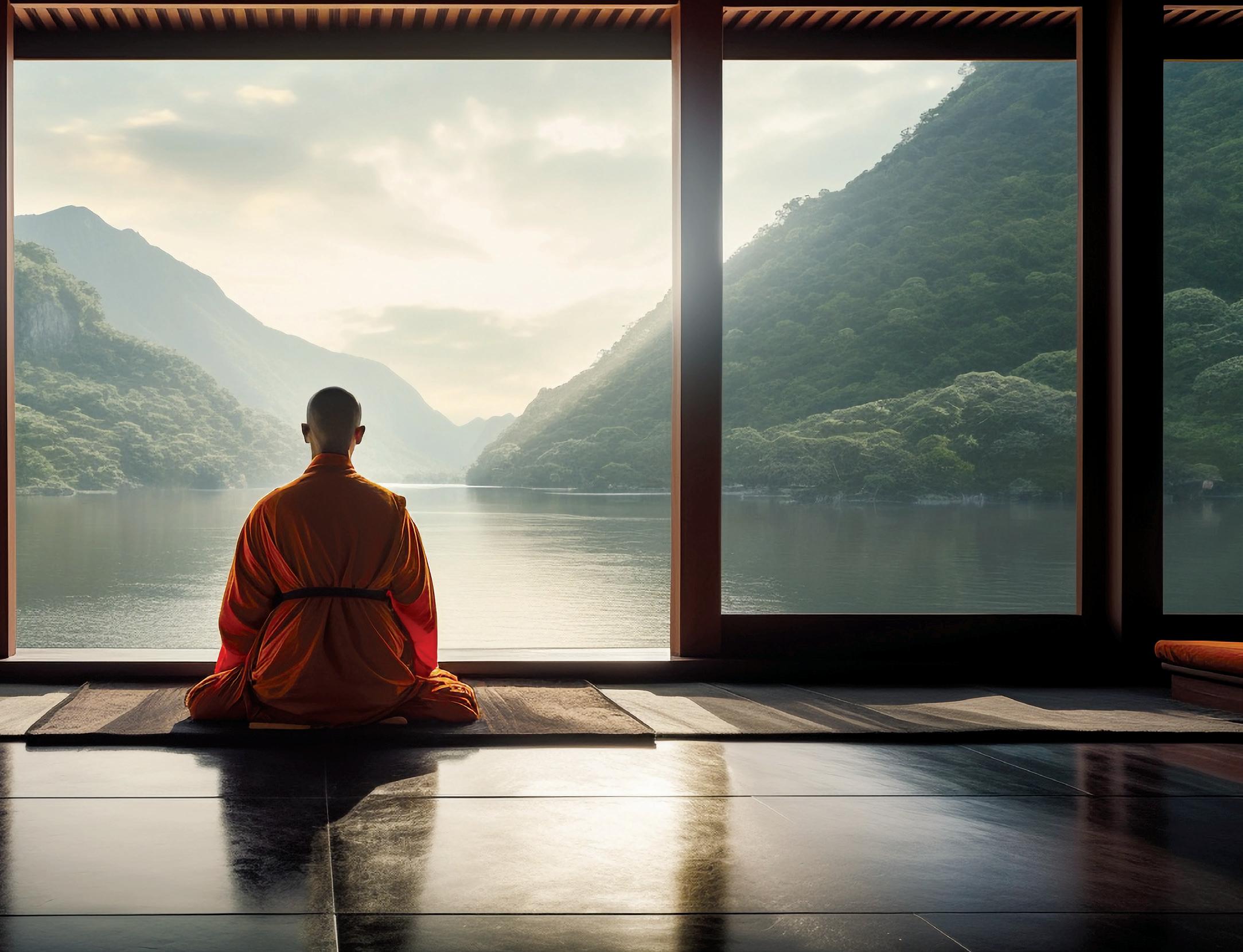
awaken 普觉 I Issue 57 41 慈悲COMPASSION I 智慧WISDOM I 生活LIFE
心 香 达 信

/ 磐陀钟磬 42 慈悲COMPASSION I 智慧WISDOM I 生活LIFE
在《水陆仪轨》有“香 赞”云:“心香达信, 云篆腾空。六尘周遍互重 重,法界悉含融。圣境冥通, 应念现金容。”意思为,恭敬 点燃净香,将诚敬之心遍法 界而上达,香烟袅袅如篆文 妙形,缭绕腾空蔚为云海。
六尘妙供庄严周遍而重重无 尽,十方法界悉皆含融。诸佛 无上庄严圣境,悉皆冥应而 感通。应此殷诚一念,悉现 尊贵殊妙之金容。“心香达 信”是赞文的核心思想,说 明佛子对诸佛菩萨的恭敬虔 诚之心,需要借助外在有形 的烧香来传达,从而让诸佛 海会大众都能闻知。《修设 瑜伽集要施食坛仪》云:“是 知欲达诸圣,先具正信。信 无形相,藉香表之。香烟遍 处,信心必通。以心感佛,何 佛而不应。此一瓣香,乃指 法体而言也。夫吾人法性, 量充沙界,体含万有。湛若澄 清之海,香腾薝卜之林。明逾 日月,德等太虚。舒之能遍于 法界,卷之可纳于微尘。”
与此相类,《炉香赞》也有 与“心香达信”说法:“炉香 乍爇,法界蒙薰。诸佛海会 悉遥闻,随处结祥云。诚意 方殷,诸佛现全身。”香点燃 后,香味能够熏染法界,香烟 能够随处结集成祥云,十方 诸佛菩萨都能闻到香味。佛 子殷切的恭敬虔诚之心通过熏 香传递给十方诸佛后,能够感 得诸佛示现金色之身护佑。
对于修行者来说,燃香供佛 只不过是一种外在的表现形 式。最主要的是要对佛菩萨 存有恭敬虔诚之心。佛法认 为,内心的清净、慈悲和虔 诚,是“真供养”,比形式上的
敬香更重要,故称“心香”。对 于虔修者来说,心若恭敬虔 诚,即使不烧香,也同样能得 到佛菩萨的慈悲护佑。
气污染,同时还严重影响了 人的身体健康。
随着人们对环保的重视,很 多寺院对乱烧香造成的环境 污染更加关注,纷纷采取各 种措施来减少烧香对环境的 污染。如有的寺院严禁外来 香进入,由寺院赠送三支香 的方式减少污染;有的寺院 专门让信徒烧具有环保功能 的香来减少污染。
心香能传达佛子虔诚之心, 但为何从古至今,各大丛林在 举行法会或诵经时,都会在 佛菩萨圣像前燃香供佛,并 且烧香的种类越来越多,有 檀香片、檀香粉,还有盘香、 整支香等等。我们之所以要 在佛菩萨圣像前燃香供佛, 是因我们需要借助拈香和烧 香这种形式来传达佛弟子对 佛菩萨的恭敬虔诚之心。
供香,既是对佛菩萨的恭敬, 同时也是一种重要的修持方 法,象征并启示自身烦恼止 息,得到究竟的喜悦与自在。 具体有形的供养是摄心的表 法,而内心的清净虔诚则是 真供养。香还代表“戒定真 香”提示世人要以自己的戒 定真香来净化身心和环境。
以香供佛表示佛子的虔诚, 是佛涅槃后最好的供佛方 式之一。但是长期以来,在 民间形成了一种错误观念, 认为香烧得越多越表示自己 内心的虔诚。于是很多信徒 来到寺院中就会拿成把的香 来烧,有的寺院为迎合善男 信女的求福之心,还兜售形 同棍棒的高香。烧香数量的 增多,增加了一定程度的空
为了身心环保,对信众的烧 香观念进行引导显得尤为重 要。其实,烧有形的香只是 一种表达恭敬的形式,佛教 所讲的真正恭敬在于内心 的虔诚。禅宗祖师常说“即 心即佛”、“一念悟,众生即 佛;一念迷,佛即众生”。对 佛菩萨的虔诚关键在于我 们的一念心,心中有佛,心 怀虔诚,不论是否烧有形的 香,都能达到恭敬供养佛菩 萨的目的。
常静
内心的清净、 慈悲和虔诚, 是“真供养”, 比形式上的 敬香更重要, 故称“心香”。
awaken 普觉 I Issue 57 43 慈悲COMPASSION I 智慧WISDOM I 生活LIFE
寺院活动
线上诵念地藏菩萨圣号
8月16日至9月14日 (农历七月初一至七月三十)
诚心诵念“南无地藏王菩萨”
大悲忏法会 一 线上供灯
9月11日 | 10月11日 |
11月10日 (有待确定) | 12月9日 (每逢农历廿七日)
上午10时至11时30分
地点: 大悲殿
费用: $8 (一盏灯一个名字)
欢庆中秋园游会
9月16日 (农历八月初二)
下午6时至晚上9时30分
地点: 大悲殿
费用: 入场免费
吉祥斋天法会
10月1日 (农历八月十七)
早上6时至8时
地点: 无相殿
法会赞助: $10, $20, $50
供品赞助: 供品篮 $28, $88
新加坡佛教论坛
10月14日至15日上午9时至下午5时
(农历八月三十至九月初一)
地点: 无相殿
水陆法会
12月3日至10日
(农历十月廿一至廿八)
地点: 光明山普觉禅寺

佛教礼仪班 一 中文 (有待确定)
10月28日 (农历九月十四)
上午9时至11时
地点: 聚缘坊
三皈五戒预备班 一 中文 (有待确定)
10月28日 (农历九月十四)
下午1时至3时
地点: 聚缘坊
授三皈五戒典礼 (有待确定)
10月29日 (农历九月十五)
下午1时至3时
地点: 无相殿
药师消灾燃灯法会
10月30日至11月4日 (农历九月十六至九月廿一)
晚上8时至9时30分
地点: 无相殿
观世音菩萨出家日 一 大悲忏法会
11月2日 (农历九月十九)
上午10时至11时
地点: 大悲殿
虔礼药师宝忏一咏日 (线上供灯)
11月5日 (农历九月廿二)
上午9时下午4时30分
地点: 无相殿 费用:$8(一盏灯一个名字)
线上诵唸阿弥陀佛圣号
12月13日至1月10日 (农历十一月初一至十一月廿十九) 诚心诵念 “南无阿弥陀佛”
闻钟声 迎祥年
12月31日至1月1日 (农历十一月初九至十一月初十)
晚上7时至凌晨1时30分
地点: 大悲殿
禅学入门
舒心·正念·静坐班
10月开始新课程
下午3时至4时30分
晚上7时30分至9时
地点: 般若禅堂
费用: $30
外来法师禅修营 (有待确定)
11月和12月
地点: 般若禅堂
正念禅修 一 传航法师授课 (有待确定)
地点: 般若禅堂
费用: $30
佛学课程
普觉中文佛法经典学习系列
—— 单元三:四十二章经
9月11日, 18日, 25日
10月2日, 9日, 16日, 23日, 30日
11月6日, 20日
星期一 | 晚上7时30分至9时
地点: 宏船老和尚纪念堂
费用: $35
佛经实修 (3) 药师经
9月11日, 18日, 25日
10月2日, 9日, 16日, 23日, 30日
11月6日, 20日
星期一 | 晚上7时30分至9时
地点: 宏船老和尚纪念堂
费用: $35
《成佛之道》(第五章) 大乘不共法
9月15日, 22日,29日
10月6日, 13日, 20日, 27日
11月3日, 10日,17日
星期五 | 晚上7时30分至9时
地点: 宏船老和尚纪念堂
费用: $35
普觉中文佛法经典学习系列 —— 单元六:心经
9月19日, 26日
10月3日, 10日, 17日, 24日, 31日
11月7日, 14日,21日
星期二 | 晚上7时30分至9时
地点: 宏船老和尚纪念堂
费用: $35
报名方式 欢迎浏览 kmspks.org kmspks.org/activities/
接待处 9am 4pm ( 午休 : 11.30am to 12.30pm )
普觉坊 11.30am 6pm (Bras Basah Complex #03-39)
/ 本寺活动
44 慈悲COMPASSION I 智慧WISDOM I 生活LIFE
社区活动
社区活动
弟子规课程 (第二系列)
7月16日至10月8日 (每逢星期天)
上午9时30分至11时30分
地点: 万佛宝塔
费用: 每人$20 (包括课本与讲义) , 每加一人另加$10 (12 堂课)
成人书法班 (第二系列)
7月22日至9月23日 (每逢星期六)
上午9时至11时
地点: 万佛宝塔
费用: $110 (10 堂课)
成人抄经班
7月23日至9月10日(每逢星期天)
下午1时30分至2时30分
地点: 万佛宝塔
费用: $50 (8 堂课)
公益补习 (小学生)
7月至11月
线上Skype
依据义工老师与学生的时间进行安排
新加坡华族文化中心 家庭出游日
9月6日 (星期二)
上午9时至下午12时30分
地点: 新加坡华族文化中心
费用: $5
捐血活动
11月5日 (星期天)
上午9时至下午3时
地点: 无相殿
联络: 新加坡红十字会 redcross.sg
电话: 6220 0183
心悦康龄

我们一起动一动
5月8日至9月25日
上午9时30分至10时30分
地点: 宏船老和尚纪念堂|三楼课室
辅导关怀 辅导与社会服务 每逢星期二至星期日 (公共假日除外)
上午9时至下午4时
地点: 宏船老和尚纪念堂 (所有辅导咨询者,请以电话或电邮方式进行 预约,严禁无预约到访。)
普觉坊活动
书法之修身养心 一 行书
8月13日至11月5日 (每逢星期日)
下午2时至4时
费用: 每人 $432 |10 堂课
书法之修身养心 一 楷书
8月13日至11月5日 (每逢星期日)
下午5时至7时
费用: 每人 $432 |10 堂课
网上营养课
三高和体重管理 (双语)
9月17日
下午2时至5时
费用: 每人 $42
自制药香工作坊
10月13日
晚上7时至9时
费用:每人22元 (材料费每人25元)
线上课程 乐龄基础佛学班
10月19日
下午2时至3时30分 免费,欢迎随喜乐捐
“食物可成为药物”
实体营养与烹饪示范课程 (双语)
10月22日
下午2时至6时
费用: 每人 $120
用正念改善睡眠
11月19日
上午10时30分 至 中午12时30分 费用:每人40元
线上课程 学佛第三课: 八正道
12月22日至1月12日 (每逢星期五)
晚上7时30分至9时
费用: 每人 42 元 | 4 堂课
环境保护
修福轩
星期一至星期天 上午10时至下午3时
地点: 斋堂外
义卖站
9月11日 | 10月11日 | 11月10日 |
12月10日
上午9时至中午1时30分
地点: 修福轩的斜对面
修福站 一 环保物品回收
上午9时至下午4时
地点: 宏船老和尚纪念堂|一楼
回收物品: 金属 / 衣服和背包 / 铝罐 / 纸张 (书籍、报纸、杂志、纸皮)
6849 5326 | sed@kmspks.org
6849 5346 | meditationhall@kmspks.org
6849 5345 | ded@kmspks.org
6849 5300 | gratitude@kmspks.org
6849 5359 / 6849 5317 | community@kmspks.org
6849 5339 | joyousheart@kmspks.org
6849 5351 | counselling@kmspks.org
6336 5067 | awarenesshub@kmspks.org
更多法会与活动 详情欢迎联系
活动日期、时间与地点将有所更动。以上详情已在印刷前确定更新。 请游览 kmspks.org 以获取最新资 讯。
awaken 普觉 I Issue 57
45 慈悲COMPASSION I 智慧WISDOM I 生活LIFE
MONASTERY EVENTS
Online Pledge of Ksitigarbha Bodhisattva’s Name Chant
16 Aug to 14 Sept
Recite the sacred chant of “Na Mo Di Zang Wang Pu Sa”
Lunar 27th Great Compassion
Repentance Puja
Online Light Offering
11 Sept | 11 Oct (TBC) | 10 Nov |
9 Dec 10am to 11.30am
Fee: $8 (1 candle with 1 sponsor name)
Mid-Autumn Festival Carnival
16 Sept | 6pm to 9.30pm
Venue: Hall of Great Compassion
Fee: Free Admission
Offering to Buddha and Celestial
Beings Puja
1 Oct | 6am to 8am
Venue: Hall of No Form
Online Puja Sponsorship:
$10, $20, $50
Offering Items Sponsorship: $28, $88 (hampers)
Singapore Buddhist Symposium
14 Oct to 15 Oct
9am to 5pm
Venue: Hall of No Form
Buddhist Etiquette Class — Mandarin (TBC)
28 Oct | 9am to 11am
Venue: Ju Yuan Fang
3 Refuge 5 Precepts Preparatory
Class Mandarin (TBC)
28 Oct | 1pm to 3pm
Venue: Ju Yuan Fang
3 Refuge 5 Precepts Ceremony (TBC)
29 Oct | 1pm to 3pm
Venue: Hall of No Form
Renunciation Day of Avalokiteshvara Bodhisattva
Great Compassion
Repentance Puja
2 Nov | 10am to 11am
Venue: Hall of Great Compassion
Medicine Buddha Prayer
Completion Puja
Online Light Offering
5 Nov | 9am to 4.30pm
Venue: Hall of No Form
Fee: $8 (1 candle with 1 sponsor name)
Online Pledge of Amitabha
Buddha’s Name Chant
13 Dec to 10 Jan
Recite the sacred chant of “Namo A Mi Tuo Fo”
Shui Lu Grand Prayer
3 Dec to 10 Dec
Venue: Kong Meng San Phor Kark
See Monastery
Countdown 2024:
108 Bell Resonance
31 Dec to 1 Jan
7pm to 1.30am
Venue: Hall of Great Compassion
MEDITATION
Relaxation and Mindfulness
Meditation
New run in Oct 2023
3pm to 4.30pm | 7.30pm to 9pm
Venue: Prajna Meditation Hall
Fee: $30
Retreat by Foreign Retreat Master (TBC)
Nov and Dec 2023
Venue: Prajna Meditation Hall
Mindfulness Meditation Group
Practice Class by Venerable Chuan Hang (TBC)
Venue: Prajna Meditation Hall
Fee: $30
DHARMA CLASSES
2023 Buddhism Lecture Series (Module 6) Ultimate Happiness
13, 20, 27 Sept | 4, 11, 18, 25 Oct |
1, 8, 15 Nov
7.30pm to 9pm
Venue: Ven. Hong Choon Memorial
Hall
Fee: $35
One-day Study Camp: Don't Look Down On The Defilements They Will Laugh At You
4 Nov | 8.30am to 5pm
Venue: Ven. Hong Choon Memorial
Hall
Fee: $20
COMMUNITY
General
Free Community Tuition 2023 (Primary School Students)
July to November
Online via Skype
Subject to the availability of tutors and students
Singapore Chinese Cultural Centre
Family Exhibition Tour
6 Sept | 9am to 12:30pm
Venue: Singapore Chinese Cultural Centre
Fee: $5
Food Ration
17 Sept | 22 Oct | 19 Nov | 17 Dec 9am to 11.30am
Blood Donation Drive 2023
5 Nov | 9am to 3pm
Venue: Hall of No Form
Contact: Singapore Red Cross at 6220 0183 or visit redcross.sg
Joyous Heart
Exercise Movement Class
8 May to 25 Sept 9.30am to 10.30am
Venue: Ven. Hong Choon Memorial Hall (Level 3)
Well-being
Counselling & Social Service
Tuesday to Sunday (excluding public holidays)
9am to 4pm
Venue: Ven. Hong Choon Memorial Hall
* No walk-ins allowed. Strictly by appointment only.
Bright Youth
In-House Badminton Gathering
24 Sept | 1pm to 4pm
Venue: Buddhist College of Singapore
In-House Badminton Competition
19 Nov | 1pm to 5pm
Venue: Buddhist College of Singapore
Fee: $10
REGISTRATION Online kmspks.org kmspks.org/activities/
office @ KMSPKS 9am to 4pm (Lunch break: 11.30am to 12.30pm)
Hub 11.30am to 6pm (Bras Basah Complex
Reception
Awareness
#03-39)
/ CALENDAR
46 慈悲COMPASSION I 智慧WISDOM I 生活LIFE
AWARENESS HUB
CHILDREN
Children's Art Class
5 Aug to 7 Oct (Saturday)
14 Oct to 23 Dec (Saturday)
2pm to 3.30pm
Fee: $62 per pax for 10 Sessions
Mindfulness for Kids —
Paws b (Age 8 to 10)
20 Nov to 11 Dec (Monday)
1pm to 2.30pm
Fee: $122 per pax for 4 Sessions
Mindfulness for Kids
Dot b (Age 11 to 16)
20 Nov to 11 Dec (Monday)
2.30pm to 4pm
Fee: $122 per pax for 4 Sessions
WELLNESS
Shufa for Self-cultivation
Xingshu Running Script
13 Aug to 5 Nov (Sunday)
2pm to 4pm
Fee: $432 per pax for 10 Sessions
Shufa for Self-Cultivation
Kaishu Standard Script
13 Aug to 5 Nov (Sunday)
5pm to 7pm
Fee: $432 per pax for 10 Sessions
Mindfulness-Based Stress Reduction
18 Aug to 6 Oct (every Friday) 7pm to 9.30pm
24 Sept (Sunday) | 9.30am to 4pm
Fee: $350 per pax for 8 sessions + full day retreat (Subsidised Rate)
Seniors Amazing Craft
6 Sept to 20 Sept (Wednesday) 1pm to 2.30pm
Online Wellness Series — Holistic Approaches to Graceful Aging
9 Sept | 10am to 5.30pm (Lunchbreak noon to 2pm)
Fee: $95 per pax
Interactive Online Nutrition Class 3 Highs and Weight Management (Bilingual)
17 Sept | 2pm to 5pm
Fee: $42 per pax
Mindfulness Foundation Course
1 Oct to 22 Oct (Sunday)
10.30am to 12.30pm
Fee: $162 per pax for 4 Sessions
“Food can be Medicine”
Interactive Nutrition and Cooking
Physical Course (Bilingual)
22 Oct | 2pm to 6pm
Fee: $120 per pax
Online Pastel Nagomi Art
Flower of Crystal Art
29 Oct | 1.30pm to 5.30pm
Fee: $68 per pax
Online Wellness Series
Herbal Health and Nutrition
18 Nov | 1pm to 5pm
Fee: $95 per pax
Rhythm Rejuvenation
Rhythmic Communication and Expression
19 Nov
Restorative Sound Immersion
17 Dec
3pm to 5pm
Fee: $32 per pax per session
YOGA
Hatha Yoga
Monday Class:
21 Aug to 23 Oct | 30 Oct to 22 Jan 6.45pm to 8.15pm
Fee: $182 per pax for 10 Sessions
Tuesday Class:
25 Jul to 26 Sept | 3 Oct to 5 Dec |
12 Dec to 20 Feb
10.30am to noon
Fee: $182 per pax for 10 Sessions
Wednesday Class:
13 Sept to 15 Nov | 22 Nov to 24 Jan
6.30pm to 7.45pm
14 Jun to 23 Aug | 30 Aug to 1 Nov |
8 Nov to 10 Jan
7.45pm to 9pm
Fee: $172 per pax for 10 Sessions
Saturday Class:
2 Sept to 4 Nov | 18 Nov to 20 Jan
9.30am to 11am
Fee: $182 per pax for 10 Sessions
Hatha Gentle Yoga
Tuesday Class:
25 Jul to 26 Sept | 3 Oct to 5 Dec |
12 Dec to 20 Feb
2.30pm to 4pm
Fee: $162 per pax for 10 Sessions
Friday Class:
8 Sept to 10 Nov | 17 Nov to 19 Jan
2.30pm to 4pm
Fee: $162 per pax for 10 Sessions
Beginners Hatha Yoga
Friday Class:
18 Aug to 20 Oct | 27 Oct to 29 Dec
10.30am to noon
Fee: $182 per pax for 10 Sessions
Saturday Class: 8 Jul to 9 Sept | 16 Sept to 25 Nov |
2 Dec to 3 Feb
6.30pm to 8pm
Fee: $182 per pax for 10 Sessions
Relax & Recharge Yoga
1 Aug to 3 Oct | 10 Oct to 12 Dec |
19 Dec to 27 Feb (Tuesday)
12.20pm to 1.20pm
Fee: $162 per pax for 10 Sessions
Yin Yoga
18 Jul to 19 Sept | 26 Sept to 28 Nov
| 5 Dec to 6 Feb (Tuesday)
6.30pm to 7.45pm
Fee: $172 per pax for 10 Sessions
Yoga for Diabetes
10 Aug to 12 Oct | 19 Oct to 21 Dec |
28 Dec to 14 Mar (Thursday)
10.30am to 11.30am
Fee: $122 per pax for 10 Sessions
Chair Yoga
25 Aug to 27 Oct | 3 Nov to 5 Jan (Friday)
12.30pm to 1.30pm
Fee: $162 per pax for 10 Sessions
GREENISM
Gratitude Shop
Monday to Sunday 10am to 3pm
Venue: Ven. Hong Choon Memorial Hall (outside Dining Hall)
Mobile Kiosk Sale
11 Sept | 11 Oct | 10 Nov | 10 Dec
9am to 1.30pm
Venue: Ven. Hong Choon Memorial Hall (diagonally opposite Gratitude Shop)
Gratitude Corner Donation Items 9am to 4pm
Venue: Ven. Hong Choon Memorial Hall (Level 1)
Accepted items: Paper products (books, newspapers, magazines & cardboard) / metal / clothing and bags / aluminium cans.
For enquiry
6849 5326 | sed@kmspks.org
6849 5346 | meditationhall@kmspks.org
6849 5345 | ded@kmspks.org
6849 5300 | gratitude@kmspks.org
6849 5359 / 6849 5317 | community@kmspks.org
6849 5339 | joyousheart@kmspks.org
6849 5351 | counselling@kmspks.org
6336 5067 | awarenesshub@kmspks.org
Programmes, dates and venues are subject to change. Details are correct at the time of printing. Please visit kmspks.org for up-to-date information. awaken 普觉 I Issue 57
47 慈悲COMPASSION I 智慧WISDOM I 生活LIFE
Introducing Joyous Heart is a new initiative by Kong Meng San Phor Kark See Monastery. Our inclusive community invites seniors to engage in diverse activities, including the "Age Well Every Day" program (developed by Mind Science Centre), basic vocal classes, exercise groups, therapeutic forest walks, and enlightening Dharma sharing. Join us today and experience the enriching journey of togetherness and growth!
光明山普觉禅寺现已成立全新的心悦康龄部门 (Joyous Heart) 。 在这个充满慈爱与包容的友善社区,我们诚邀乐龄成员们一同参与各 式活动,包括了“天天康龄”活动 (由思维科学中心创办), 乐龄基础声乐课,小组运动,森林漫步疗养以及佛理讲座。
欢迎您的加入,让我们一同踏上共融成长的美妙之旅!
关于您的宝贵意见
We value your comments and welcome your suggestions.
我们十分重视每位读者的反馈与意见。
Let us know how Awaken magazine is working out for you. Your responses will help us understand what you like and contribute to our continued effort to spread the teachings of the Dharma and bring benefit to all sentient beings. May everyone cultivate love, kindness, wisdom, and compassion in our lives.



您的宝贵意见,将有助于我们更加了解普觉杂志进步的 方向。在您的帮助下,我们定能更好的宣扬佛法,愿你 我一起播下善种,待善根发芽茁壮,为众生种福德田。


Please scan QR code to take our survey.
JOIN US 欢迎加入 6849 5339 / 8121 1736 joyousheart@kmspks.org kmspks.org/joyous-heart
欢迎扫描QR码访问 我们的问卷调查。

BUSINESS
REPLY SERVICE
PERMIT NO. 08598
KONG MENG SAN PHOR KARK SEE MONASTERY
AWAKEN Magazine
88 Bright Hill Road Singapore 574117
您的微笑,您的宽厚 您为众人慈悲的奉献
Truly appreciate your smile, your generosity, your kind service to all

only.
Postage will be paid by addressee. For posting in Singapore
kmspks.org
THANK YOU
The Gift of the Dharma Excels All Other Gifts —
Buddha
佛说:一切布施中,法布施为最
Let us honour The Buddha and share his teachings with others by supporting the production cost of Awaken Magazine for free distribution.
如果您想和大家分享无上布施(法施)的喜悦,欢迎赞助印刷《普觉》杂志。
Simply fill in the donation form below and mail it back to us together with your cheque and money order. All cheques and money orders should be made payable to “Kong Meng San Phor Kark See Monastery”
可填妥以下赞助表格,并将划线支票或汇款单据回寄给我们。
划线支票抬头或汇款单据需写明 “Kong Meng San Phor Kark See Monastery”
For overseas readers, please send bank drafts in Singapore currency. Please include S$10 for bank charges. Please note that the monastery is NOT able to accept cheques in foreign currency.
由于本寺不接受外币支票,故海外读者如发心赞助本刊,请使用银行汇票(新加坡币)并附上 10元手续费用。
You can also donate via 您可通过以下方式完成捐款
Cashless 无现金支付
To make an online donation, please visit: 您可通过以下网站完成捐赠: kmspks.org/make-a-donation
(*Please select “Printing of Dharma Materials” and type in the donation amount.)
(*请在 “Printing of Dharma Materials” 栏目注明捐款数额)
Cash 现金支付
Please visit our Front Office to make cash donations. 可到访本寺的寺务处现款捐献。
Opening Hours 营业时间: 9am to 4.30pm
You will be issued a receipt for the donation. 完成捐款后,我们将会签发正式收据。
If you have any enquiries, please call (65) 6849 5342 or e-mail: publication@kmspks.org 如有任何疑问,请拨电
6849 5342 或电邮至 publication@kmspks.org
Name 英文姓名: Chinese Name 中文姓名: Gender 性别:
: Email 电邮:
Do you require an official receipt? 您是否需要收据? (Yes* 需要 / No 不需要)
*Please delete where appropriate
* Every donation counts towards the propagation of the Dharma and we want to thank you for sharing this journey with us. May the blessings of the Triple Gem always be with you and your loved ones. 您的善款将有助于佛法的弘扬与传播,感谢您与我们共赴这趟难忘的旅程。愿佛法的人生伴随您,三宝的愿力加持您。祝法喜充满,一切圆满。
* By submitting this donation form, you agree that KMSPKS may collect, use and disclose your personal data for the purposes of processing donations and performing donor relations activities and communication in accordance with the Personal Data Protection Act 2012 and the monastery’s privacy policy available at www.kmspks.org/privacy.
通过提交此捐款表格, 您同意光明山普觉禅寺可以根据 2012 年个人资料保护法令以及本寺的隐私政策 (可在 kmspks.org/privacy 获取) 收集、使用、 或披露您的个人资料以用于处理捐款与维系捐赠关系及沟通目的。
Tel 电话: (H 住家) (O 办公室) (Hp 手机)
数额: (*Cash 现金/Cheque No 支票号码: )
Age 年龄
Address 地址:
Amount
(65)
了解更多
Want your story to be heard ?
感动人心的故事 省思生命的园地
Perhaps you too have a story to tell, a story of how the Buddha and His Teachings so inspired you to walk the Buddhist path, or maybe a simple account of the little treasures and blessings in life, or how the Dharma changed your life forever. Whatever your story may be, we welcome you to write in to us. Share your inspiring tale of faith and awakening with the rest of the world. 我们的宗旨是弘扬佛教正法,推广平等、慈悲、无我、无私的精神,启迪众生智慧,净化大众之心灵。 《普觉》杂志真诚欢迎您的投稿与支持,愿每一篇有价值的故事或启迪,觉醒佛心之间的共鸣。
Submission guidelines for English articles
· Our articles range from 500 to 1,500 words. However, the final print is at the editor’s discretion.
· You may submit drawings and illustrations with adequate explanations or captions.
· Articles must be neatly typed out and copyedited carefully before submission. Drafts and hand-written articles are not acceptable.
· The topic must be original, and your articles cannot contain false or misleading information.
· Your article should have a title and be accompanied by a description of your article.

· Awaken magazine reserves the right to make the final decisions in the selection and edit your stories as deemed fit.
Send your articles to:
AWAKEN PUBLISHING
Kong Meng San Phor Kark See Monastery
88 Bright Hill Road Singapore 574117
Email: publication@kmspks.org
Please include your full name and contact details.
栏目内容 兰 若 轩 能以小见大,富有哲理、具有启发意义的佛学精品短文。
菩提清韵 描绘庙宇、山水的精美散文,以及佛教感悟,修行心得的散 文、诗歌。
竹林夜话 有启发意义的僧传、史传和佛教故事,以及近现代和当代的 现实故事。
意解人生 生活中的人生感悟,挖掘人性的真善美,提倡文明、和平、 环保的精美杂文。
法海拾贝 重拾人生走过的足印,以阐述佛法义理的精美文章。
盘陀钟磬 刊登逻辑严密、说理性强的佛教短篇论文,与精彩的法师大 德开示。
琉璃之光 秉承佛教慈悲的思想,从医学的视角介绍生活中的小百科, 阐发正确的生活习惯与饮食习惯。
狮城奋讯 新加坡的佛教简讯。
中文稿件要求
· 本刊欢迎电子邮件投稿。所投稿件以800至2000字为宜,采用与否, 概不退稿。
· 投稿若用笔名,请另注明真实姓名、电邮地址、住址及手机号码以便 联系与邮寄稿酬。
· 来稿三个月内未接到通知,请自行处理。
· 编辑部对所投稿件有权删改,如要保留原文或一稿多投者,必须注 明。
· 手写稿请用正楷字书写清楚,标点分明。来稿一经发表,文责自负。
· 稿件一经刊登后,我们将按稿件原址寄奉稿酬,每一千字60元新 币,以申谢忱。
投稿地址: AWAKEN PUBLISHING
Kong Meng San Phor Kark See Monastery 88 Bright Hill Road Singapore 574117
投稿邮箱: pujue@kmspks.org
BEYOND THE EDGE

/ FEATURE 52 慈悲COMPASSION I 智慧WISDOM I 生活LIFE
From time to time in our Dharma practice, we encounter periods of being “stuck”. This happens to everybody because it is a natural part of our life process — a point where we hold on based on false assumptions of how the mind is supported and how it is released. This state of self-orientation often guides us to strive, struggle, learn, adapt, and get results. And to an extent, this strategy works. Engaging in practices like meditation, service, and renunciation arouses ardour, faith, commitment, and energy. They establish the context of goodness and it is that foundation that stays with us beneath the personality level even when our efforts break down and we feel we are not getting anywhere. However, only a certain degree of awakening comes from that personality vehicle. After a while, the mind's tendency to "do" and "fix" exhausts its potential, transforming from a solution to a problem.
So, we get "stuck". Then the sense of "stuckness" spins out onto blaming our apparent self, our system of practice, or the people we live with. It triggers a compulsive activity — a sankhara accompanied by ignorance — that diffuses and disperses its distress outwardly onto the manifold rights and wrongs of people and things:
from the Buddha (why did he have to make all this
so difficult!) on down. Or inwardly: onto assessing our character, our heart, our history, our past, our flaws, and our virtues. We fidget, get busy and distracted and jump to conclusions that will cement the "stuckness" into a situation — “I can’t practise here with these people,” or “I must have a lot of bad karma that is an insurmountable obstacle”, or some other piece of Buddhist jargon. This is the time to start waking up because the very compulsion to judge, compare, ruminate, and speculate over oneself and thereby creating suffering — and believing this process is true and necessary, shows that something more primary is going on here. Compulsion is not a process that supports awakening.
We yearn to cling to a particular identity or conviction within our practice-tradition, yet we find ourselves unable to fully grasp it. Instead, we stick to uncertainty. This is the edge. It is not a comfortable place, but it becomes a piece of our journey. This experience is essential because it is at this edge that the self-vehicle undergoes an overhaul, necessitating the removal of its wheels. By reaching this crucial juncture and navigating beyond it, one can experience a vital opening and fruition: the unraveling of the attachment to the "self" at the level of personality.
However, when we review the experience as just an experience, it fosters an environment where we encounter a state of "stuckness" that eludes our attempts to eliminate or ignore it. This state leads us to an "edge", a realm of uncertainty where we do not have a fixed identity but still desire to be something.
Often when we get to that edge of uncertainty, the mind moves away from it so quickly that we either shift into doing something or otherwise displace the uncomfortable feeling. The mind starts scurrying around: “Why am I like this? What can I do about this?” Restlessness builds up until we feel compelled to do something to make ourselves feel capable and comfortable again. Unfortunately all this activity intensifies the real obstacle, which is our self-orientation — "I do", "I cannot do", "I am", "I am not", "I have", "I do not have". If it is not handled wisely, the "stuckness" will keep propelling us into activities that justify this self-centred outlook. So, notice that: suddenly all this dharma-
awaken 普觉 I Issue 57 53 慈悲COMPASSION I 智慧WISDOM I 生活LIFE
So instead, we stick to uncertainty. This is the edge. It is not a comfortable place, but becomes a piece of our journey.
practice is making you more neurotic and self-obsessed than you were before!
Notice what takes you to the edge of feeling you are on solid ground. It may be within something as humble as a daily routine. Routine acts of service can be testing grounds — places where we are no longer so spontaneous, or feel on top, or seem to develop much. So surely all this humdrum stuff is not going to take us to the bright gates of the Deathless! Then again taking responsibility may take us to an edge of uncertainty about our own worth: “Am I good enough? Do people approve of me?” We get stuck in that self-consciousness and keep recycling reviews and progress reports in terms of “being” (bhava) — “I am”, “I ought to be” “Oh no, look what I’ve become, and haven’t yet become!” This sense of being something always leans upon an achievement, a future, or other people’s approval. Or it causes us to imagine the worst: “I haven’t become a success, my future has no potential, I’m not getting acclaim, so I must be a failure.” The compulsion to identify with this sense of being is so strong that if we can't find a positive selfimage to lean on, we resort to adopting a negative one. The "stuckness" is then more difficult than any particular flaw because the doubt that it stimulates corrodes our faith in the path and the practice.
At this place, all the teachings sound like platitudes that we have heard a thousand times (and “we still have not become enlightened”), and although we should have gotten rid of our defilements by now, we have not — and sometimes they even seem more authentic than our virtues. Our unconscious attachment — to the teachings, the highs of meditation, the presence of teachers and presents its downside, the romance looks like it is heading for divorce. "Stuck" stuff is highly emotive, and emotion creates credibility. Whatever is emotive has a vitality to it, and it captures and convinces by its power and ability to evoke, stimulate, and cause the mind to create. So, we might not even go beneath the convictions and stories, to reveal the hard core of self-orientation, self-importance and selfpity: “I’ve tried so hard, and Buddhism has let me down.” We start to believe in our minds and solidify with the pathos of it all. We may become destabilised, irrational, and moody. This sense of loss of conviction in “becoming something” can get difficult and even dangerous (people crack up).

Hence, it is a crucial edge: we are asked to find a sense of continuity and coherence that is valid but not based on a personality-centric view.
This comes around through two interconnected processes: developing the relational sense and the sense of presence. Whereas the personalityview is structured around “what I can do”, and "what I am going to do about this situation" (it is a “head sense”), the relational sense tells me “how I am” in the presence of something “other.” It is a “heart sense”. By “presence” I mean the bodily, somatic sense, that
/ FEATURE 54 慈悲COMPASSION I 智慧WISDOM I 生活LIFE
This comes around through two interconnected processes: developing the relational sense and the sense of presence.
tells me “where I am”. The journey out of the “stuck” place involves coordinating all of these aspects. But in many cases, the process primarily entails cultivating the sense of “how am I” and “where am I”, as these often receive less attention than the ”doing sense”. But when all these three elements come together, you have a solid and intelligent vehicle for practice.
As we all know, relationships can challenge who we think we are. Thus, it is important to maintain a sense of commitment to others (within, of course, ethical

boundaries), to a place, to a routine, or to a practice, even though these are often the targets that the “stuck” sense is throwing the dirt at. So how good, enlightened and stateof-the-art do these have to be for you? Do they have some dukkha in them? It is important to maintain mutual trust and faith, despite occasional discomfort, awkwardness, anxiety, or hurt. The essence of commitment is not about attachment or giving a hundred percent approval ratings on the people, the place, or the routine, it is about contemplating
how things are, and using the commitment to affect leverage against our need to have things go “my way”. It takes us to the edge — the place for us to realise the limitations within ourselves and our external conditions and encourage us to let go and expand beyond our current selves. In this process, we discover new resources and grow bigger than ourselves, bigger than our comfort, happiness, effectiveness, and intelligence. Part of this growth arises from a more complete sense of relational understanding.
The riddle of the "stuck"
awaken 普觉 I Issue 57 55 慈悲COMPASSION I 智慧WISDOM I 生活LIFE
place is something that we cannot negotiate in our normal mode of operating. If it could be done by a "me" it would not transcend our limitations. What is required to overcome this is a change in direction and energy. Then there can be an opening into something that is larger, kinder, and more boundless than the self-mechanisms. We get beyond attachment to the ups and downs of our personality, beyond attachment to systems and techniques of the dharma, as well as the doubts that arise from measuring the dharma in these limited terms. As we move past these inevitable
attachments, we become spacious and at peace.
So, investigate: What is the voice behind the emotional charge of the "stuck" place? Who is standing on the edge? This can give us a good insight or recognition of what the mind is affected by. That subject, or that person, becomes one’s meditation theme. Here the standard meditation for relaxing the energy that engenders “self” is that of empathy, goodwill, and compassion (brahmavihara). We hold this self in the sphere of wishing it well, and of recognising its suffering. This shift in intention and energy changes the way
we relate. We are not trying to change our apparent self, or even understand it, but rather to establish a centre of loving-kindness and compassion around it. We make room to embrace our helplessness or meanness, focusing on offering pure kindness and compassion. When we can discern the self as a succession of mindobjects, and not a single true and solid thing, our centre shifts. At that moment at one time, what is the relationship with it? Can it be empathic, towards another, even another that you do not like, but have to live with? There does not have to be an answer, we can

/ FEATURE 56 慈悲COMPASSION I 智慧WISDOM I 生活LIFE
find a resolution through patience: spaciousness, inquiry into to what brings around the most useful and agreeable states of mind.
Another resource is to hold this "stuckness" in its bodily sense. With "stuckness", we too may feel tension in the body, disturbances in the body’s energy, or even more of a visceral or somatic disturbance. Learn to sit and scan the body with awareness, and particularly to open, as "stuckness" has a magnetic and adhesive power. For example, the body may tighten up. Or we may feel pulled up into the head, tense in the belly, or spun out — bits of our
body disappear out of consciousness and other places get intense. So just try sweeping the body with attention, as if we were making this whole bodily sphere into a good place in which the sticking energy can sit. Rather than trying to get rid of it, find a place to hold that conundrum, and make the sensed bodily space big enough. For sticking and holding on, tightening and narrowing us.
The sensory impact, isolation, and the general afflictive relationship experiences that we have tend to drive us behind a protective "skin wall", leading to the belief that we are confined within our bodies. During times of retreat, some of us may seek to delve even deeper into our physical form. However, practising mindfulness of the body requires embracing both its internal and external aspects. As we become mindful of our bodies, we recognise that embodiment is the key focus of our day-to-day practice. Our conscious process is embodied and our body has its own

intelligence. This embodied intelligence is not within the physical form, rather, the physical form manifests within it. It has an energy and sensitivity that move out around this physical form, and they interrelate with our emotions. Both the bodily sense and the emotional, emotive senses work together.
When we enter a room, we naturally find a comfortable place to sit or maintain a distance from others. Furthermore, when we have powerful emotions, we sense their effect in a bodily way — the nerves start firing, the face flushes, and the guts tighten or relax. This is somatic intelligence. It means that this physical form can attune to its environment without constant physical contact.
However, when we get afflicted and hurt, we contract, we withdraw that sensitivity, we switch off our context, and retreat into our minds. The retraction of awareness leads to a numb, habituated state which is how many people live most of the time. The body grows numb and clumsy, losing its grace, while mental attitudes and emotions seize up. People become rigid and unable to see things beyond a simple this-orthat mentality, losing their lateral thinking abilities, their ability to play, to look around, or to be spacious — all the flexibility and
awaken 普觉 I Issue 57 57 慈悲COMPASSION I 智慧WISDOM I 生活LIFE
Learn to sit and scan the body with awareness, and particularly to open, as "stuckness" has a magnetic and adhesive power.
agility go out of awareness. Thus, meditation plays a helpful role in restoring full sensitivity to the body. By doing so, the more "mental" aspect of awareness can draw cues from the somatic experience of the body. In general, the instruction is to widen and soften our awareness as we experience the way the body senses its own presence.
This makes it possible to recognise where stress is manifesting physically and to release it. In mindfulness of the body, it is important to attend to the joints, which often lose their space. The body's space element primarily resides in the small spaces between joints and tissues. When one gets rigid, these spaces tend to contract. So practise opening the hands, relaxing the arms from the body, opening the shoulders, relaxing the jaw where it tends to clamp, and opening up the place between the skull and the neck, all of which tend to shut down. Deliberately widen and soften the sense of the body (it is not a matter of physical movement or stretching, but of adjusting the nervous energy). This allows the energy to flow freely. Emotional and cognitive states will follow. Unlocking the body can lead to feelings of release, compassion, or clarity. The body serves as the ground for negotiating intense and difficult places because it is conscious and related
to the consciousness that manifests the mind.
Within the sphere of loving-kindness, compassion, and the open body, transformations may occur, at times even leading to discomfort, but ultimately liberating. Our need to succeed and our attachment to ideals and excellence cannot carry us any further, but the unfolding of self and the shifting to an embodied and heartful centre can. Our intention has to transform into being more fully and empathically present with the way it is. As the Buddha expressed it: “the feelings in the feelings, mind in the mind.”
through a more empathic intention. In simpler terms, we do not always have to do a whole lot as doing is already happening in subtler ways. When we focus on something and listen to it, awareness naturally imbues its intention, or dominant mood, pattern-producing energy, or sankhara , onto that object. In this “stuck” state, the sankhara that we encourage is one of empathy. Applied persistently and patiently, while maintaining spaciousness. This entails locating the stagnant energy within the body and listening to that while keeping the overall bodily state in mind. This process of connecting localised “stuckness” to the wholeness of our being generates a healing pattern, rather than merely wishing to change or understand it. So, we must give full attention to it, feel it out, and listen to it, until we can transcend the hostility, hopelessness, or frustration of trying to force change upon it. At the edge of our ability to make and do, a purer intention emerges — to listen and resonate fully.
Awareness is normally directed by volition or cetana , which represents the conscious or semiconscious will to do, to be, or to have. We do not necessarily recognise that it has an innate vitality and energy that can be harnessed
When we have all three aspects of awareness: its cognitive, decisive "head" sense, its empathic "heart" sense, and its grounded bodily "presence" working together, we might say we have full awareness. As we give full attention to feel and to listen, we
/ FEATURE 58 慈悲COMPASSION I 智慧WISDOM I 生活LIFE
Our need to succeed and our attachment to ideals and excellence cannot carry us any further, but the unfolding of self and the shifting to an embodied and heartful centre can.
perhaps see new features in that experience, in that compounded state, and we may also realise how we are holding onto that state. The state of uncertainty may be held with agitation, fear or all kinds of stories associated with it. Notice the emotional charges such as distaste, guilt, rage, or grief, or the somatic symptoms like tightening in the face, throat or chest, and flurrying in the guts. Additionally, the thought processes — the rights and wrongs and “should bes” that occur at the edge. By recognising them as they are, and keeping the whole picture in mind, we prevent these energies from becoming ingrained. The “stuck” state is just a pattern of sankhara energies that
we are not fully aware of. However, once we bring full awareness to them, the self is taken out of it, and it comes “unstuck”. This process is a profound learning experience, leading to purer awareness and a quiet knowing that has no opinion and does not evoke any activity. It is dispassionate and spacious, opening us up to a place that is more intimate and
comfortable than our usual personalities.
The very predicament of "stuckness" is vital in eradicating the conceit “I am” or “You are” or “I’m not” or however self-view forms itself. This self is a compounding of dharmas that arise and subside. "Stuckness" and grasping can take us beyond this — if we can sense and handle them with mindfulness and full awareness.
Ajahn Sucitto is a Buddhist monk (bhikkhu). He entered monastic life in 1975 in Thailand, but since 1978 he is based in Britain. He spent fourteen years training under Ajahn Sumedho, the senior Western disciple of Ajahn Chah.
 Adapted from: Beyond the edge.
Adapted from: Beyond the edge.
awaken 普觉 I Issue 57 59 慈悲COMPASSION I 智慧WISDOM I 生活LIFE
PlAcE the of

/ FEATURE 60 慈悲COMPASSION I 智慧WISDOM I 生活LIFE
The practice of Dharma goes against our habits, the truth goes against our desires; thus, there is difficulty in the practice. Some things which we understand as wrong may be right, while the things we take to be right may be wrong. Why is this? Because our minds are in darkness, we do not clearly see the truth. We do not really know anything and so we are fooled by people’s lies. They point out what is right as being wrong and what is wrong as being right; and we unquestionably believe it. This situation arises because we have not yet attained mastery over ourselves, and our fluctuating moods mislead us persistently. We should not take this mind of ours and its opinions as our guide because it does not know the truth.
While some individuals may completely disregard the views of others, such an approach does not reflect the path of a wise person. A wise man listens to everything. One who listens to the Dharma must listen just the same, whether he likes it or not, and not blindly believe or disbelieve. He must stay at the halfway mark, the middle point, and must not be heedless. He listens and then contemplates, giving rise to the right discernment accordingly.
A wise man should contemplate and see the cause and effect for himself
before he believes what he hears. Even if the teacher speaks the truth, do not just believe it, because you have not yet known the truth of it for yourself.
This principle applies to all of us, including myself. I have practised longer than you, I have seen many lies before. For instance, “this practice is really difficult" arises because we most often have the wrong view.
searching for something to appease my mind.
As a dhutaṅga monk, I went travelling, but things were still not right. So, I contemplated: “what can I do to make things right?” Living with a lot or a few people left me dissatisfied. For what reason? I just could not figure it out. Why was I dissatisfied? Because I had a wrong view, just that; I was still clinging to the wrong Dharma. Wherever I went I was discontented, and quick to blame external factors, such as the weather's extremities or the actions of others. I blamed everything! Just like a mad dog. When the mind is like this our practice is never settled. Today we feel good, tomorrow we do not. True contentment and peace remained elusive.
Previously I lived with other monks, but I did not feel right. I ran away to the forests and mountains, fleeing the crowd, the monks, and the novices. I thought that they were not like me, they did not practise as hard as I did. They were sloppy. This was something that really put me in turmoil, it was the cause for my running away. But whether I lived alone or with others, I still had no peace. On my own, I was not contented. In a large group, I was not contented too. I thought this discontentment was due to my companions, due to my moods, my living place, the food, and the weather. I was constantly
The Buddha once saw a jackal, a wild dog, run out of the forest where he was staying. It stood still for a while, then it ran into the underbrush, only to come out again. It repeated this movement several times, running into a tree hollow, then back out, and even entering a cave before swiftly exiting once more. One minute it stood, the next it ran, then it lay down, then it jumped up. That jackal suffered from mange. When standing, the mange would afflict its skin, prompting it to run, and when running became uncomfortable, it would stop. The cycle continued, with the jackal unable to find peace.
A wise man listens to everything. One who listens to the Dharma must listen just the same, whether he likes it or not, and not blindly believe or disbelieve.
awaken 普觉 I Issue 57 61 慈悲COMPASSION I 智慧WISDOM I 生活LIFE
The Buddha said: “Monks, did you see that jackal this afternoon? Standing it suffered, running it suffered, sitting it suffered, lying down it suffered. In the underbrush, a tree hollow, or a cave, it suffered. It blamed standing for its discomfort, it blamed sitting, it blamed running and lying down; it blamed the tree, the underbrush, and the cave. In fact, the problem was with none of those things. The problem was the mange.” We are just the same as that jackal. Our discontentment is due to the wrong view. Because we do not exercise a sense of restraint, we blame our suffering on external circumstances. As a result, wherever we go we remain discontented.
However, just as the jackal's suffering would cease if its mange were cured, we too can find contentment by understanding the truth about various moods. We can be satisfied regardless of external conditions, whether it be hot or cold, in the company of many or few. Contentment is not dependent on the number of people around us but arises from adopting the right view. When we have the right view, we find contentment wherever we are.
But most of us hold on to the wrong view. It is just like a maggot — a maggot’s living place is filthy, and it feeds on filthy food. If you take a stick and brush the maggot away from its lump of dung, it will struggle to
crawl back in. In the same way, when the path to correct understanding is shown to us, we resist, as it makes us feel uneasy. We run back to our “lump of dung” because that is where we feel most at home. If we do not see the harmful consequences of all our wrong views, then we leave them and are not able to progress in our practice. So, we should listen, for attentive learning is integral to the practice.
If we have the right view, contentment follows us wherever we go. I have practised and witnessed this. These days there are many monks, novices and laypeople coming to see me. If I still did not know, if I had clung to the wrong view, I would be dead by now! The right abiding place for monks, the place of coolness, is just the right view itself. We should not look for anything else.
So even though you may be unhappy it does not matter, for unhappiness is uncertain. Is that unhappiness your true “self”? Is there any substance to it? Is it real? I do not see it as being real at all. Unhappiness is merely a fleeting feeling, just like happiness. Does happiness or unhappiness possess any enduring essence? They are transient emotions that arise and fade away. Love, hate, and resentment lack any substantial entity; they are fleeting mental impressions,
deceiving and uncertain. Just as the Buddha said, when unhappiness arises it stays for a while, then disappears. When unhappiness disappears, happiness arises and lingers for a while and then dies, and the cycle continues.
In the end, we can only say this: apart from the birth, the life, and the death of suffering, there is nothing. But we who are ignorant run and grab it constantly. We never see the truth of it, that there is simply this continual change. If we understand this, then we would not need to give it much thought. It is only until we truly see the harm caused by our actions can we relinquish them. Similarly, when we see the genuine benefits of practice, we can strive for a "clear and good" mind.
If we cut a log of wood and throw it into the river, and if that log does not sink or rot, or run aground on either side of the banks of the river, that log will definitely reach the sea. Our practice is comparable to this. If you faithfully practise according to the path
/ FEATURE 62 慈悲COMPASSION I 智慧WISDOM I 生活LIFE
If we have the right view, wherever we go we are contented. I have practised and witnessed this already.
laid down by the Buddha, you will transcend two things. What two things?
Just those two extremes that the Buddha said were not the path of a true meditator: indulgence in pleasure and indulgence in pain. These are the two banks of the river. One of the banks symbolises hate, the other love. Or you can say that one bank is happiness, the other unhappiness. The “log” represents the mind. As it flows down the river it will experience happiness and unhappiness. However, if the mind does not cling to that happiness or unhappiness, it will eventually reach the "ocean" of Nibbāna
You should see that there is nothing other
than happiness and unhappiness arising and disappearing. If you do not “run aground” on either of these banks, then you are on the path of a true meditator.

This is the teaching of the Buddha. Happiness, unhappiness, love, and hate are simply established according to the constant
law of nature. The wise person neither follows or encourages them, he does not cling to them. This is the mind that lets go of indulgence in pleasure and indulgence in pain. It is the right practice. Similar to a log of wood that will eventually flow to the sea, the mind detached from these two extremes will inevitably attain peace.
Translated from a talk given to the assembly of monks and novices at Wat Pah Nanachat, during the rains retreat, 1978.
Ajahn Chah
An excerpt from “A Taste of Freedom”© 1991. The Sangha, Wat Pah Nanachat.
awaken 普觉 I Issue 57 63 慈悲COMPASSION I 智慧WISDOM I 生活LIFE
Kong Meng San Phor Kark See Monastery (KMSPKS), established in 1921, has come a long way from the humble Hall of Great Compassion and has since grown to become the largest monastery in Singapore.

The monastery's mission to liberate all sentient beings through the teachings of the Buddha is reflected in its name, with "Kong Meng San" (bright hill) representing the pure land of Avalokiteshvara Bodhisattva, and "Phor Kark" signifying the goal of universal enlightenment. The monastery's commitment to propagating the Dharma, advancing education, and promoting Buddhist culture has remained steadfast over the years, making it a spiritual sanctuary for its devotees.
The "Remembering Hundred Years of KMSPKS — Through the Passage of Time" exhibition, held at the KMSPKS Museum celebrates the monastery's centenary and offers visitors an experiential journey down memory lane to witness its growth and evolution over the years. The exhibition showcases the invaluable contributions of Venerable Seck Hong Choon, who expanded the monastery and actively propagated Buddhism, education and Chinese heritage, while also contributing to society
through relief work.
The museum also features a range of cherished artifacts and traces the origins of Buddhism in Singapore and how it has integrated into the country's multicultural and multireligious society.
Visitors can also learn about the life of Shakyamuni Buddha, the teacher and leader of Buddhism, and his teachings that continue to benefit all sentient beings today.
One of the highlights of the exhibition is the Interactive Area, which integrates technology and Buddhism to engage visitors in Buddha's teachings. Here, visitors can immerse themselves in Buddhist teachings, receive blessings, and even pray for the world and their families through the "Gifts of Merits" installation.
As we reflect on the past century with a grateful heart, let us wish for the continued benefit of all sentient beings for countless years to come as KMSPKS remains dedicated to its timeless mission of enlightenment, education and cultural preservation.
The monastery is truly a living testament to the beauty and richness of Singapore's spiritual and cultural heritage and will continue to inspire generations to come.
/ DID YOU KNOW 64 慈悲COMPASSION I 智慧WISDOM I 生活LIFE
JOURNEY THROUGH A CENTURY OF GRATITUDE
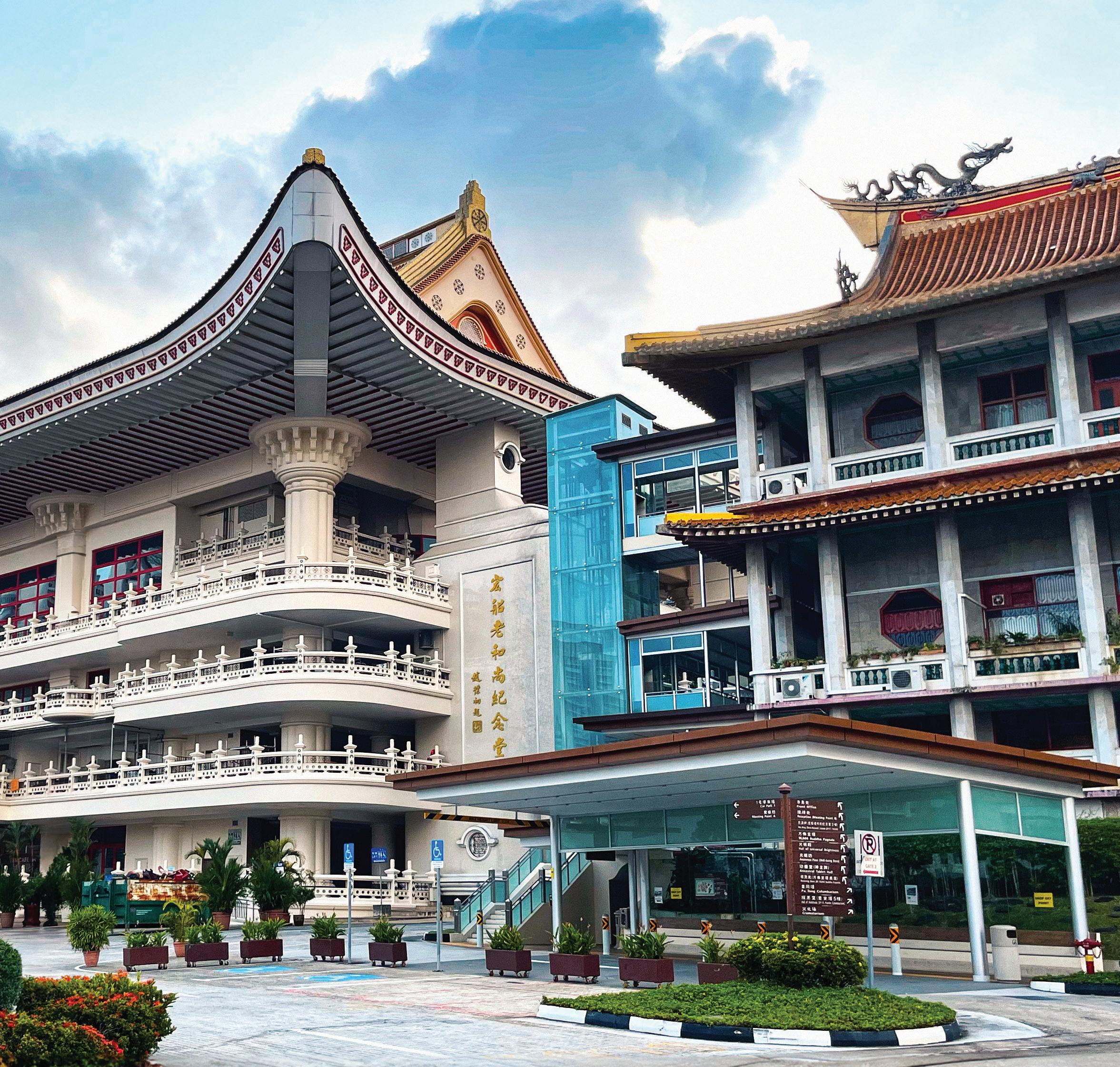 KMSPKS Museum, located at Venerable Hong Choon Memorial Hall (Level 3), is open to the public every 27th day of the lunar month from 9am to 2pm. Admission is free. Scan for more information.
KMSPKS Museum, located at Venerable Hong Choon Memorial Hall (Level 3), is open to the public every 27th day of the lunar month from 9am to 2pm. Admission is free. Scan for more information.
awaken 普觉 I Issue 57 65 慈悲COMPASSION I 智慧WISDOM I 生活LIFE
明山普觉禅寺不仅是 佛教法脉的传承之 地,更是新加坡历史与文化 遗产的重要证明。自 1921 年 开山以来,寺院规模从最初 的荒山小寺,逐步发展成为 新加坡最大的寺院,此一因 缘皆为众缘所成就。

寺院自始以“光明山”命名。
“光明山”相传为观自在菩萨的 净土;而“普觉”二字则有“普 遍觉悟”之义,以此象征“依佛 法知见,普令众生证觉大解脱” 的重要使命。秉持着弘法利生 的理念,光明山普觉禅寺致力 于推展教育、弘法及文化等事 业。作为禅门临济宗法脈传承 的道场,本寺也举办各类禅修 课,让信众有个心灵归处。
纪念馆以“百年思源——走进 时光的回廊”的展览活动, 欢庆开寺百年的无上成就, 也让各界到访者一览光明山
百年思源 走进时光的回廊
普觉禅寺的成长轨迹与代 表性文物。馆内展示了宏船 长老接任方丈并扩建寺院, 积极推动弘法、教育、文化、 慈善救济等事业的重要史 迹,以此纪念长老对佛教事业 的巨大贡献。
除此之外,纪念馆也展示了一 系列珍贵文物,追溯新加坡 佛教的起源,多元种族与宗 教的融洽关系,并了解佛教 如何发展成为新加坡最大的 宗教团体。馆内展示了释迦 牟尼佛自 2500 年前从出生、 出家、成道的过程,访客也能 从中了解佛陀如何透过言传 身教度化众生,并将佛法流 传至今。
纪念馆内的互动区更是展览 的一大亮点。以现代科技结 合佛法,互动区不仅让前来 的访客了解八正道,也在互动 区当中让访客透过“双手接
福”的活动来表达祝福心声, 祈求世界和平、合家安康。
让我们以一颗感恩的心回顾 这百年历程,期许在未来的 无数个百年,能够持续以菩 萨情怀利益众生。寺院里的 岁月痕迹,不仅是新加坡历 史与文化遗产的重要足迹, 背后也深藏了对世世代代的 期许,祈愿佛教传承的步伐 生生不息。
纪念馆 位于宏船老和尚纪念
堂(三楼),现已免费开放, 公众可于每月农历廿七,上 午 9 时至下午 2 时前来参观。 扫描 QR码查 看更多详情。
光
/ DID YOU KNOW 66 慈悲COMPASSION I 智慧WISDOM I 生活LIFE
Some historical artefacts on display 展出的历史文物
Venerable Seck Hong Choon’s daily living items
宏船老和尚生活用品
This set of display offers us a glimpse into the daily life of Venerable Seck Hong Choon. Through the use of simple and plain daily-use items, we can appreciate the Elder’s commitment to a basic and frugal lifestyle.
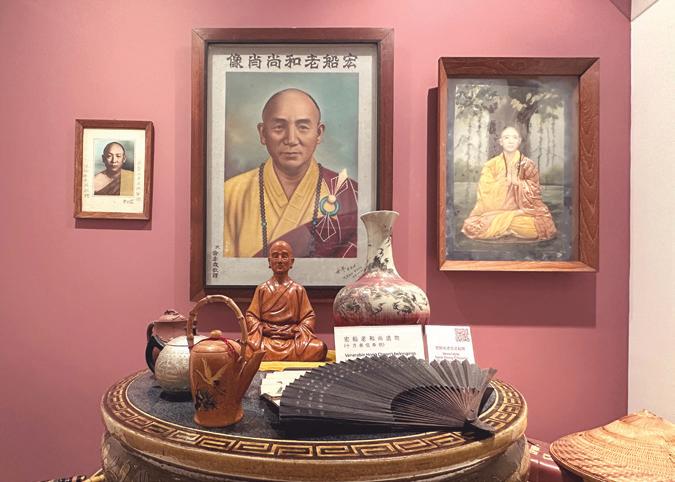
这里的陈列可以让我们一睹 宏船长老平时的起居生活景 象。简约朴实的日常用品让 我们看到了这位长者平常日 子里的清俭素雅。
Antique bell 开山大钟
The installation of a large bell commemorates the founding of KMSPKS. Venerable Seck Hong Choon, the second abbot, led the construction of the old Hall

of Great Strength (the main veneration hall in a Chinese Buddhist monastery) in 1950 with donations from the Haw Par Brothers.
这件面积颇大的大钟,堪称 光明山普觉禅寺的开山大 钟。1950 年寺内的旧大雄宝殿 落成,由宏船长老创建并由虎 豹兄弟出资捐建。
1966 Triple Platform Commemoration clock 1966 三坛大戒纪念钟 Venerable Seck Hong Choon commissioned a standing clock to commemorate the 1966 inaugural ceremony of “The Grand Prayer that Blesses and Benefits all Sentient Beings” at KMSPKS. The clock features inscriptions honouring the 45th anniversary of the monastery's founding Abbot, Venerable Sik Zhuan Dao,and the fulfilment of his wish for combined veneration events — “Triple Platform Ordination
Ceremony”, “The Grand Prayer that Blesses and Benefits all Sentient Beings”, and “Grand Prayer for World Peace”.
宏船长老定制了一座站钟, 以此纪念 1966 年光明山普觉 禅寺启建的水陆大斋胜会和 祈祷世界和平大会。站钟上 清楚可见这样的刻字: “为了纪念光明山普觉禅寺开 山住持转道老和尚建寺 45 周年,并且为了实现转道老 和尚的遗愿,举办律仪学会 (三坛大戒)、启建水陆大斋胜 会和祈祷世界和平大会。”
Mr. Zhao Pu Chu’s calligraphy 赵朴初居士的书法
The former Chairman of China's Buddhist Association, Mr. Zhao Pu Chu, personally gifted this calligraphy work to Venerable Seck Hong Choon, showcasing his skilful handwriting and the esteemed regard in which he held the Elder.
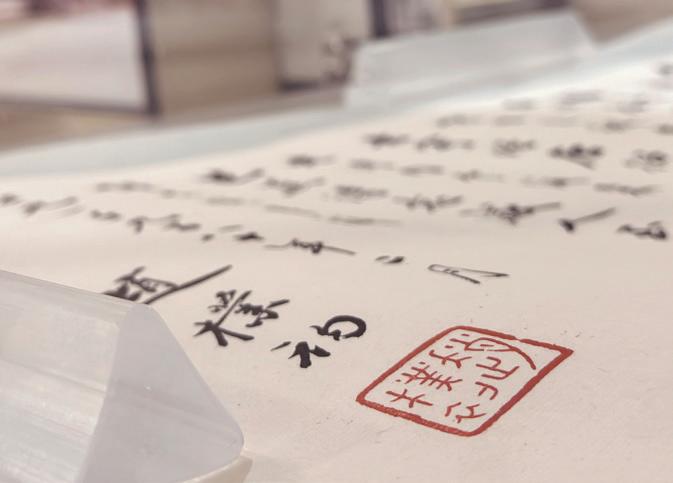
1: Venerable Seck Hong Choon’s daily living items 宏船老和尚生活用品
2: Antique bell 开山大钟
3: 1966 Triple Platform Commemoration clock 1966 三坛大戒纪念钟
4: Mr. Zhao Pu Chu’s calligraphy 赵朴初居士的书法

1 4 2 3 awaken 普觉 I Issue 57 67 慈悲COMPASSION I 智慧WISDOM I 生活LIFE
这幅书法是前中国佛教会长 赵朴初居士亲笔写的书法诗 词,于 1980 年赠送给宏船长 老。书法不仅展示了赵朴初居 士娴熟的书法技艺,也透露了 他对长老的尊敬之情。
Founding chime 开山大磬
The large chime at KMSPKS, dating back to 1922, commemorates the donation of land by Mr. Zheng Yu Sheng for the monastery's establishment. To mark the occasion, Mr. Zheng custommade the creation of the chime from a workshop in Hangzhou, China. Although no longer in use, the chime's engravings serve as a reminder of the virtues of generosity and compassion.
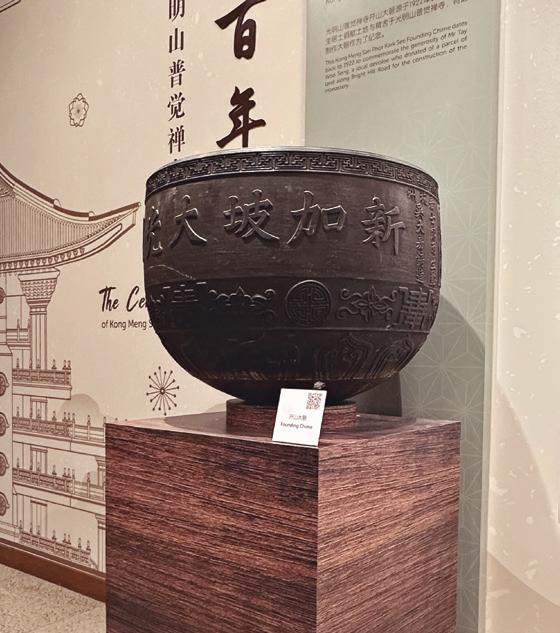
这件置于寺内的开山大磬,渊 源始于 1922 年。当时的善翁郑 雨生居士捐献了土地与精舍
给转道老和尚以创建光明山 普觉禅寺。为了纪念此事迹, 郑居士与中国杭州定做此大 磬,特捐给普觉禅寺。虽大磬 已不再使用了但它时刻提醒 着后辈们无私与奉献精神。
Old Animal Liberation Garden stele 旧放生园石碑
The Animal Liberation Garden stele in KMSPKS commemorates the foundation of the garden by members of the Singapore Buddhist Sutra Distribution Centre in 1933. Assisted by the founding Abbot, Venerable Sik Zhuan Dao, the stele details the garden's establishment, including the names of donors, fundraised amount, and the reasons for its founding.

The Animal Liberation Garden housed various animals, an observation
tower and rock garden. The garden attracted many visitors and aimed to inspire compassionate thoughts.
光明山普觉禅寺内的放生园 石碑,纪念了“新加坡佛经流 通处”(新加坡佛教居士林的 前身)的部分会员,在 1933 年
协助了转道法师创建光明山 普觉禅寺放生园。放生园石 碑以刻字记载了当时创建放 生园的捐献者的名字、募捐 数额、创建的缘由等明细。当 时寺内的放生园放生了很多 种类的小动物,后来园内也建 了观景塔、假山等供观赏用 途的景物。放生园吸引了很多 访客,在游玩观景的同时,以 放生一举,修慈悲之心。
18 Arhats 十八罗汉
In traditional Chinese Buddhist temples or monasteries, 18 Arhat statues are commonly displayed for devotees to pay reverence to. Originally placed in the monastery's old Hall of Great Strength, these ceramic statues were arranged in pairs on both flanks of the veneration hall. Today, only 10 statues remain, evoking the solemnity of the past.
在传统的华人佛教寺庙里, 经常可以看到“十八罗汉”的 雕像或塑像,供信众观赏、礼 拜。这批陶瓷材质的罗汉雕 像最早供奉在旧大雄宝殿内 的左右两侧。如今仅剩的有 10 尊。这些栩栩如生的塑像

Christina B. + 吴衍庆
身影,仿佛让人看到了寺内旧 大雄宝殿的庄严景象。
1: Founding chime 开山大磬
2: Old Animal Liberation Garden stele 旧放生园石碑
1 3 2 / DID YOU KNOW 68 慈悲COMPASSION I 智慧WISDOM I 生活LIFE
3: 18 Arhats 十八罗汉





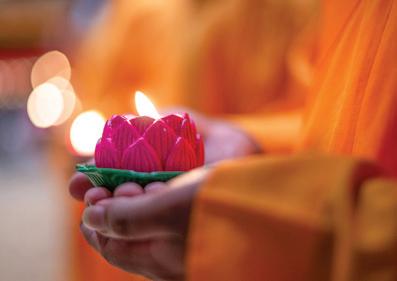



Every day I prepare myself for a fresh morning!
My name is Marta. I am a cat, as you can see. Like everyone, there are good and bad days. I try to live my life fully, and it starts every morning.


#1
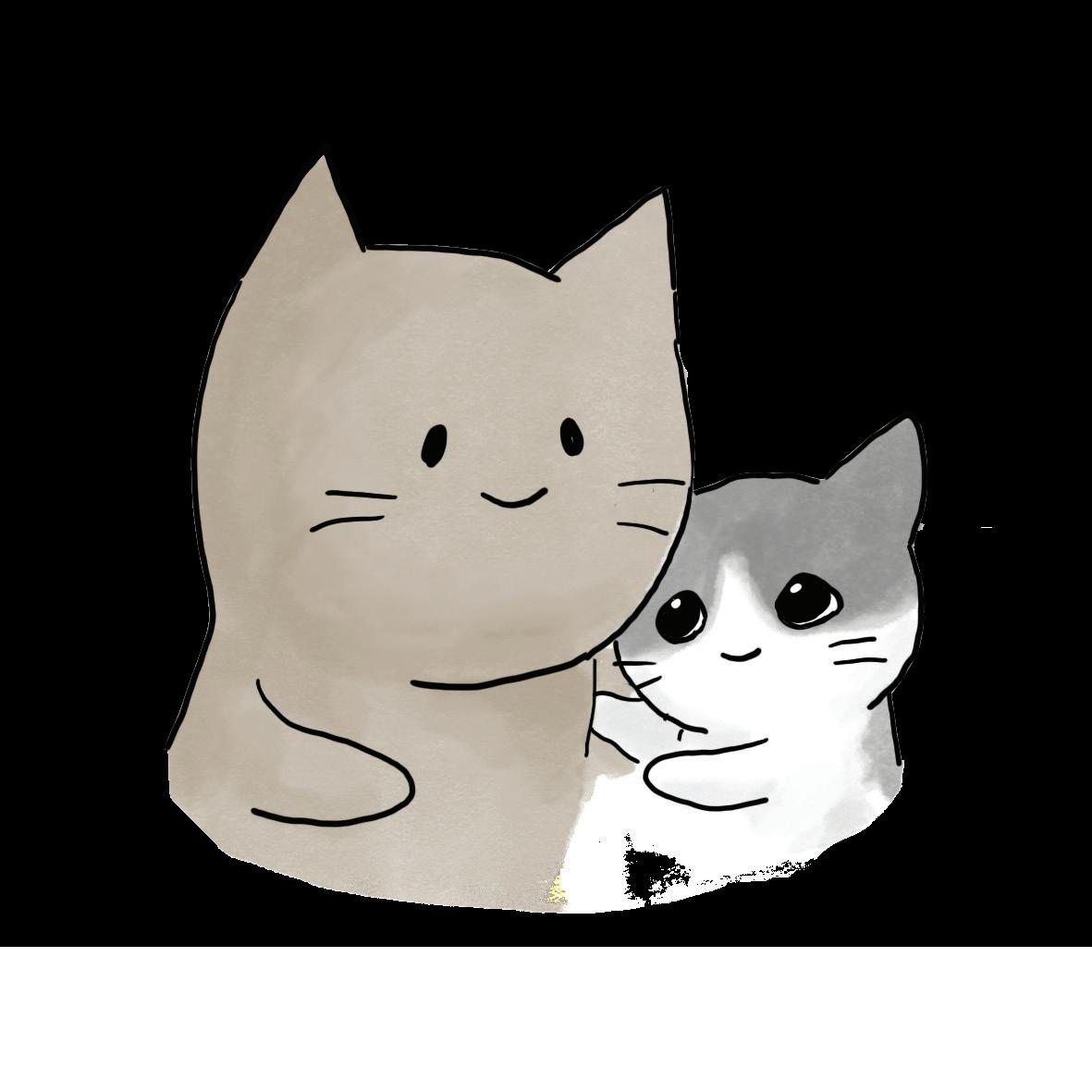
First, I ask myself how I can help others and the world today. Can I do something good today?
To say "I love you" to my loved ones before I leave my house as if this is the last time I will see them. Because today may very well be the last day alive.
Illustration & Text : @siha the wise
/ BUDDHIST TALES 70 慈悲COMPASSION I 智慧WISDOM I 生活LIFE
#4
I am always mindful throughout the day, and never let defilements overwhelm my mind.
After returning home, before sleeping, I will sit in a quiet spot to relax and meditate to just relax and let go.


#5
Before I sleep, I will remind myself of my good qualities and the good deeds I've done today.
Today I care for someone!
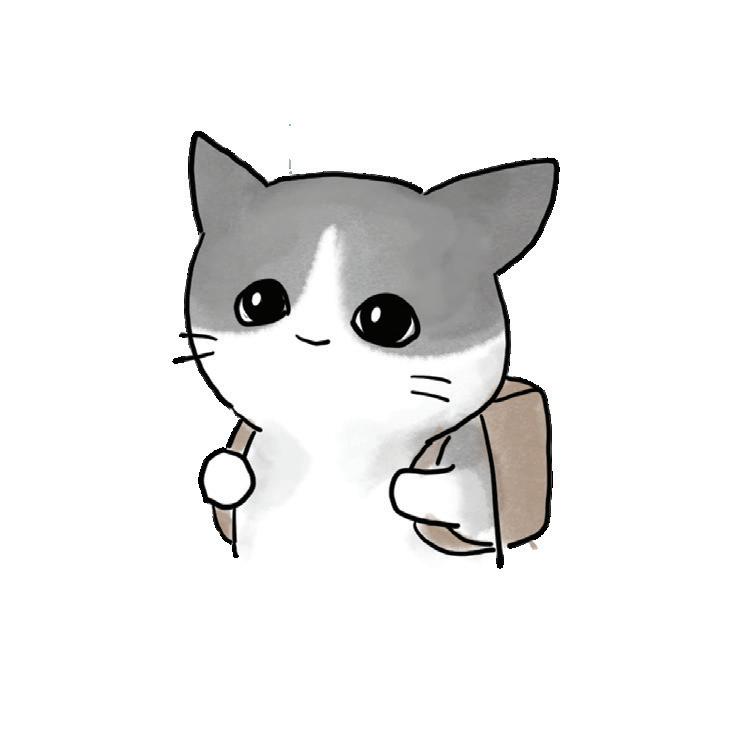
#6

If anyone is causing me frustration in my day, I wish them happiness and am grateful for being alive today.
Today, I am not overwhelmed by anger and frustrations.
Today, I did a kind act!
Try it out! Develop your own routine!
Buddha -
"Better it is to live one day virtuous and meditative than to live a hundred years immoral and uncontrolled."
awaken 普觉 I Issue 57 71 慈悲COMPASSION I 智慧WISDOM I 生活LIFE
HARD WORK IS THE KEY TO SUCCESS
In a faraway village, there lived a hardworking farmer who owned several vineyards. Every year, his grapery never failed to yield him a bountiful harvest, and the farmer soon became very successful.

He had three young and energetic sons who were never interested to work, let alone helping him in the vineyards. As the farmer grew old and his health started to deteriorate, he began to worry about his sons’ future.
One day, the farmer fell
very ill and realised that his death was near. On his deathbed, he gathered his three sons and told them, “Dear sons, I see my death approaching, but before I bid goodbye to all of you, I want to share a secret. There is a treasure hidden under the vineyards. To find it, dig the entire field after my death.”
After the old farmer passed away, his sons began to do a thorough search for the treasure in the vineyard but could find nothing. However, their intense digging of the field led to a
growth of healthy fruitage and resulted in huge earnings. These earnings made his sons realise what their father meant by “a hidden treasure”.
The Moral: Hard work always pays off. Fruits of hard work are always sweet whether or not they are in the form you desire.
Christina B. Retold
/ BUDDHIST TALES 72 慈悲COMPASSION I 智慧WISDOM I 生活LIFE
We haven’t even started this chessgame, how is it I’ve lost?
Fighting to win with one’s family, one wins but loses the kinship.
Fighting to win with one’s spouse, one wins but loses the love.
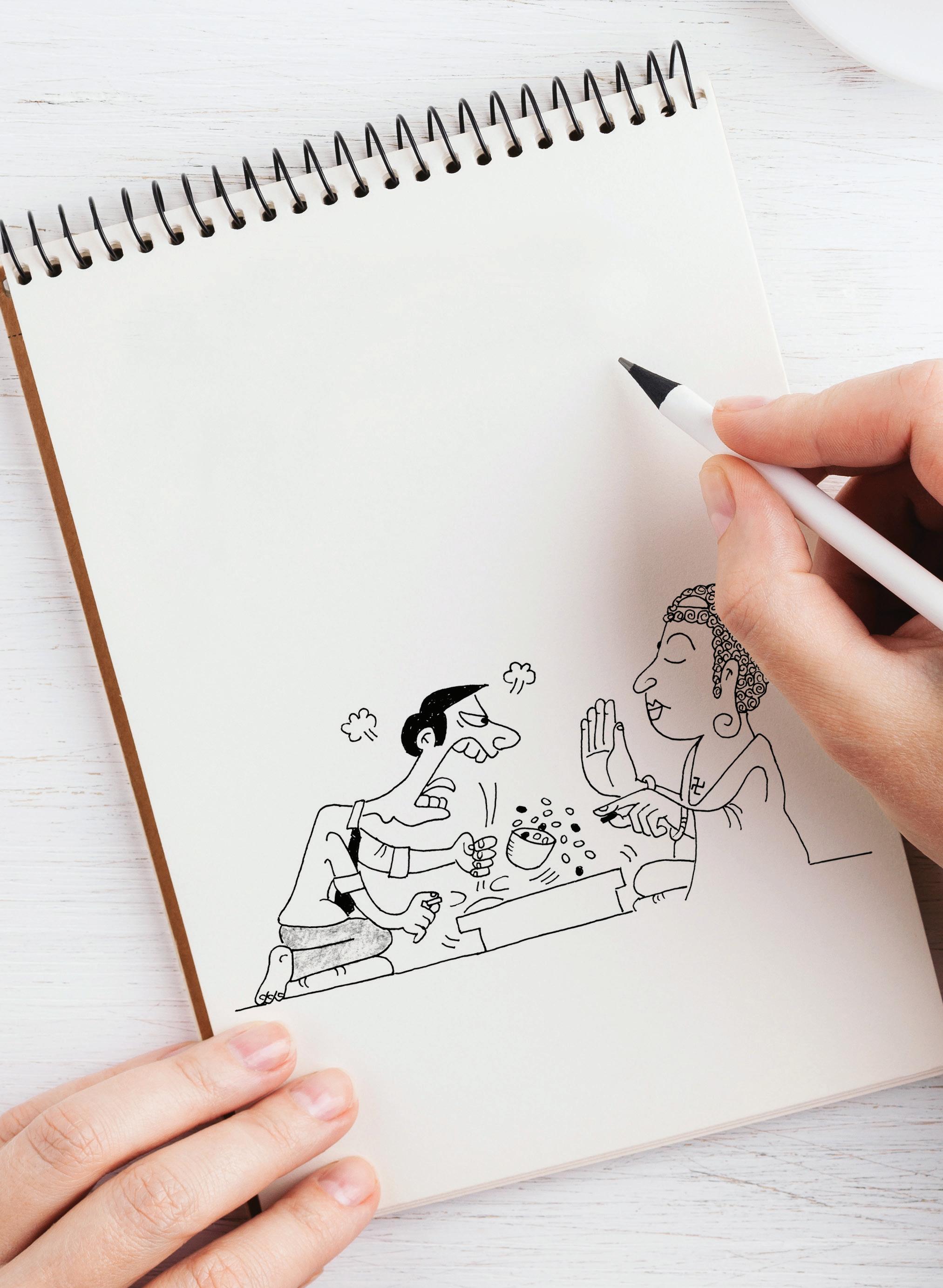
Fighting to win with one’s friend, one wins but loses the friendship.
Finally, one fights till the end only to lose one’s health. Amituofo!
Whenyoudecided to“fighttowin”, alreadyyouhavelost!
We always think of fighting to win, but forget that we may end up losing more.
awaken 普觉 I Issue 57 73 慈悲COMPASSION I 智慧WISDOM I 生活LIFE
Illustration: Robert Yeo | Translator: Oh Puay Fong
choices

/ SOMETHING TO PONDER 74 慈悲COMPASSION I 智慧WISDOM I 生活LIFE
Feeling powerless and without choices is depressing. But having too many choices can also cripple us. When there are many options available, fear of making the wrong choice, or of not making the absolute best choice, can mean that we end up making no choices at all.

There are so many Buddhist teachings and traditions to choose from these days. It is wonderful that in this modern world we can gain such easy access to the Dharma. But that easy access brings with it its own dangers. If we can turn on or turn off the Dharma with the tap of a screen, we can lose our sense of its preciousness. It can become just one more thing that we watched today, absorbing at the time but then soon submerged beneath all the other things. As a result, instead of taking advantage of technology to be encouraged, challenged and empowered in our practice, we risk becoming mere consumers of the Dharma, and accumulators of high-quality clips and links.
The Dharma challenges us to put the teachings to the test of experience, with sincerity, consistent and patient efforts. By whatever means we receive the Dharma, let us not forget that its purpose is always to lead us onwards on our path to truth.
Ajahn Jayasāro is a Theravada bhikkhu in the Thai Forest tradition. He received full ordination from Ajahn Chah in 1980, and was abbot of Wat Pah Nanachat from 1997 to 2002. In 2019, he was honoured with a royal title from Thailand’s King Vajiralongkorn (Rama X).
Dhamma by Ajahn Jayasaro. Facebook (June 13, 2022).
awaken 普觉 I Issue 57 75 慈悲COMPASSION I 智慧WISDOM I 生活LIFE
While it is true that we cannot change the past, we do have the power to shape our future. Our problems often arise from the struggle between our “mind” (thoughts) and “matter” (external world).
However, if we learn to let go of our attachments and negative thoughts, we can free ourselves from unnecessary worries

/ SOMETHING TO PONDER 76 慈悲COMPASSION I 智慧WISDOM I 生活LIFE
and focus on the present moment. Instead of chasing after external sources of happiness, we should strive to live in harmony and with nature, free from egoism, unrealistic expectations, and find joy in small things.
The key to happiness is not to pursue it relentlessly, but to live a simple life and allow happiness to arise within us. We can
cultivate positive thoughts every morning and start the day with a clear and focused mind. This will help us to navigate our day more effectively and make better decisions that will lead us closer to our ultimate goals.
So, let us focus on living mindfully, and planting seeds of positivity every day. This way, we can experience a beautiful,

fulfiling life, make a positive impact and create a more harmonious world for ourselves and those around us.
Remember: “if we do not mind, it does not matter.”
Ven Lindagala Ananda Thero (Chang Xi) is a student at the Buddhist College of Singapore.
awaken 普觉 I Issue 57 77 慈悲COMPASSION I 智慧WISDOM I 生活LIFE
Nobody

cares how much you know until they know how much you care.
/ SOMETHING TO PONDER 78 慈悲COMPASSION I 智慧WISDOM I 生活LIFE
— Theodore Roosevelt (26th President of the United States)
Alice's (not her real name) experience is a compelling reminder that even those who love their jobs can experience burnout and stress. In today's fast-paced and competitive work environment, the pressure to perform at a high level can be overwhelming and take a toll on our mental and physical wellbeing. However, as Alice discovered, there is always hope for a better tomorrow.
Alice's difficulties began in 2022 when her job as a pre-school teacher became more demanding. She struggled to keep up and felt overwhelmed. The mounting workload and heightened expectations from her students' parents added to her stress levels. Her mental well-being was adversely affected by these, and Alice started experiencing mood swings and feeling down most days.
The first step towards seeking help is to acknowledge that we need it. However, this can be challenging as seeking help often comes with a stigma attached to it. Alice was hesitant at first, but she knew that she needed help. With the encouragement of a friend, she embarked on the first step towards her journey to a better and more fulfilling life and decided to speak with a counsellor.
Through her counselling sessions, Alice delved deep into her strengths and
interests, gained a profound insight into herself, and acquired invaluable skills for managing stress. With newfound clarity and focus, Alice was able to prioritise her time and energy. As a result, she was able to let go of negative thoughts and emotions and regain control of her life.
Alice's experience highlights the power of resilience, the importance of seeking help, and the value of empathy and active listening. Her counselling sessions taught her that reaching out for assistance is critical to personal growth and well-being. She expressed her gratitude towards her friend for the timely encouragement to seek counselling as well as the counselling team at Kong Meng San Phor Kark See Monastery who had provided her with invaluable counselling services for several months. She described her sessions as enriching and highlighted the crucial feedback that she received, helped her achieve a greater sense of happiness than before.
The detrimental effects of workplace stress and burnout on a person's mental health and general
well-being cannot be understated. However, it is reassuring to know that with adequate support and guidance, individuals can successfully navigate even the most daunting of obstacles. Despite feeling disoriented or helpless, it is crucial to remember that there is always a glimmer of hope for a brighter future. Alice's account serves as a poignant reminder that reaching out for help requires courage, and we must not feel embarrassed, fearful or self-conscious about seeking assistance when we require it. Instead, we should embrace the chance to expand our knowledge and grow personally.
If you know of someone who is struggling, suggest and encourage him/her to seek help. Kong Meng San Phor Kark See Monastery’s Counselling and Social Service Department offers complimentary counselling and casework management to all, regardless of race, religion, gender, and age. They can be reached at 6849 5351 or email at counselling@kmspks.org
However, if you require immediate assistance, several 24-hour helplines are available, including Samaritans of Singapore (SOS) at 1767, SOS WhatsApp CareText at 9151 1767, and Mental Health Helpline at 6389 2222
Christina B.
awaken 普觉 I Issue 57 79 慈悲COMPASSION I 智慧WISDOM I 生活LIFE
It is crucial to remember that there is always a glimmer of hope for a brighter future.
Q :How can we be contented with what we have in life when we are pressured to keep up with wealth and social status?
:AWhen we are attached to wealth, it can encompass various forms — material wealth, reputation, the number of friends we have, how we gauge our "popularity," or any other kind of wealth we possess. Whenever we are deeply attached to something, it instils a sense of dissatisfaction and a feeling of never having enough. The attachment itself also prevents us from feeling satisfied with what we already possess.
Looking at our own experiences and the lives of the people around us, we will realise that our level of material possession is unrelated to how rich or poor we feel. The sense of wealth or poverty is purely a state of mind.
How many people have financial security? Even people who are very wealthy do not have financial security, as they do not feel secure no matter how much they have. This is the constant kind of dissatisfaction that comes from their attachment to wealth. Consequently, such attachment leads to stinginess, miserliness, and a reluctance to share their wealth with others.
During my time in India, I witnessed how the poor people in the community had a sense of wealth as they would share their things with other people without the fear of “if I share it, if I give it, I won’t have it.” Whereas so many people in the States, who are in the middle class were complaining to me how poor they were despite having tons more stuff than the people in India. What these American people did not have is a mind of satisfaction, as they are burdened by their attachments to material things.
When there is stinginess in us, fear of losing what we have, or concern about others' opinions on us due to our lack of something, then we are actually quite poor inside.
If we are willing to cultivate our sense of detachment on the things we consider our wealth, be they material possessions, reputation, or social status, we can then share and experience satisfaction.

This also applies to knowledge. Some people can be very stingy about sharing what they know. I have heard that at some elite universities, students check out important textbooks from the library and deliberately keep them for themselves without returning, thereby preventing others from
accessing and benefiting from these textbooks. People can be so selfish and do not want to teach others out of fear that sharing information
/ Q & A 80 慈悲COMPASSION I 智慧WISDOM I 生活LIFE
When there is stinginess, fear of losing what we have, or concern about others' opinions due to the lack of something, then actually we are quite poor inside.
might lead to someone else surpassing them. As a result, they hold onto their knowledge and reputation. Any teacher who is worth anything should want their students to be better than they are. These come down to that same stinginess, attachment, and dissatisfaction that will persist regardless of how much one acquires or in any kind of external situation. That kind of internal pain can only go away when we change our mindset.
Contentment In Life
This is where the practice of developing contentment comes in, along with the practice of cultivating generosity and taking delight in being generous.

Venerable Chodron emphasises the practical application of Buddha’s teachings in our daily lives and is especially skilled at explaining them in ways easily understood and practised by Westerners. She is well known for her warm, humorous, and lucid teachings. She was ordained as a Buddhist nun in 1977 by Kyabje Ling Rinpoche in Dharamsala, India, and in 1986 she received bhikshuni (full) ordination in Taiwan. Learn more about Sravasti Abbey at sravastiabbey.org
Adapted from: The poorest of all beings:
awaken 普觉 I Issue 57 81 慈悲COMPASSION I 智慧WISDOM I 生活LIFE
TOO MUCH TECHNOLOGY

/ MINDFULNESS
82 慈悲COMPASSION I 智慧WISDOM I 生活LIFE
PARENTING
One of the greatest gifts we can give our children is the opportunity to enjoy nature. It is a worry in this technological age that many children might miss out on the chance to learn the power of nature to comfort us, relax us and shift our perspective on our cares and concerns. In the bush, at the beach or in the local park, our capacity to be calm, open and present multiplies. Addicted to the adrenaline of computer games or the distractions of the television, some children do not see the need to step outside. I have taken friends of my sons on bushwalks only to hear them complain they feel scared — so unfamiliar with the experience.
In nature, we experience a simple and accessible
form of happiness. In the outdoors, children are active, creative and keen to explore. Outside, they are free to be children, to enjoy an active childhood and to create the very best of memories. As parents we can model a passion for nature, pointing out its wonders — and children invariably return the favour. If our children do not learn to love nature, how can we trust future generations to preserve it?
Sarah Napthali
This article is extracted from the book "Buddhism for Parents on the Go".

awaken 普觉 I Issue 57 83 慈悲COMPASSION I 智慧WISDOM I 生活LIFE
Heartbreak no more @
Heartbreak Melts
Iwrote about Love Handle in the last issue and in this issue, the topic related to affairs of the heart continues as I introduce Heartbreak Melts (HBM). It is a vegan ice cream café in the Ang Mo Kio neighbourhood, not too far from the MRT station! If you have been feeling heartbroken for missing out on ice cream due to its nonplant-based nature, it is time to mend your broken heart!


Unlike traditional ice cream that relies on milk, HBM crafts their creations using coconut milk, soy and nut-based ingredients. They come in unique flavours such as Tauheuy
Gula Melaka, Earl Grey, Cornflakes, Cookie Monster, and Pipagao (yes, it is that herbal cough syrup that we all know)! You can enjoy these delectable treats in a cone (from $5), on a waffle (from $10) or simply bincheat from a pint ($16). Notably, both the cone and waffle options are eggless. Though eggless, the waffles were not too dry. If you are feeling
peckish, their menu also offers cakes, pies and food items such as nasi lemak and finger food. However, do note their opening hours. This late-owl-friendly place remains open until 2am (or earlier, if you prefer). This is a great place for catching up with loved ones and friends after a hard day’s work or study, or simply to chillax during the weekend.
Overall Rating
Food: 8/10 I Service: 7/10
Address
421 Ang Mo Kio Ave 10, #01-1163, (S) 560421
Website: heartbreakmelts.com
Operating Hours
Weekdays: 3pm to 2am
Weekends: 12pm to 2am
Text: Jos Tan
/ SAVOUR 84 慈悲COMPASSION I 智慧WISDOM I 生活LIFE
Affordable Vegan Eats In Town
AAre you looking for a pocket-friendly vegan option in town? Look no further than Kang Su Vegetarian! Situated at Orchard Road, this bustling tiny cafeteria in the usually quiet Far East Shopping Centre is the place to go for


Out of the numerous varieties of dishes offered by Kang Su Vegetarian, my favourites are their signature Kang Su Kolo Mee Dry Noodle ($5) and Thai Style Chicken Cutlet Rice ($6). The springy Kolo noodle is complemented by the plant-based Char Siew, which tastes almost like the original. The addition of deep-fried soybean curd skin adds a crispy delight to the popular dish.
The Thai Style Chicken Cutlet Rice is not as spicy as the name suggests. The highlight of this dish is the sweet, sour and slightly spicy Thai sauce with a tinge of lemongrass, spread on top of the crispy chicken cutlet, adding character to the dish.

For healthier options, you may opt for the Soup Ban Mian ($5.50). Packed with a generous portion of vegetables and mushrooms, it helps warm the stomach on wet or under-weather days.

Overall Rating
Food: 8/10 I Service: 6/10
Address 545 Orchard Road, #05-16, Far East Shopping Centre, (S) 238882 (Opposite Thai Embassy)
Operating Hours
Mon to Sat : 10.30am to 8pm
Due to its limited space and growing popularity, do expect a queue of approximately 15 to 30 minutes during mealtimes. However, the delicious food is well worth the wait.
Text and photos: Chloe Huang
awaken 普觉 I Issue 56 85 慈悲COMPASSION I 智慧WISDOM I 生活LIFE
spiced goodness
Say goodbye to the monotonous cup of joe and discover a delightful, healthier alternative to your regular coffee. This exceptional beverage boasts a subtle kick of freshness from ginger and black pepper, complemented by the comforting warmth of cinnamon, cardamom, and cloves
For a rejuvenating twist, allow the latte to chill in the refrigerator or add ice for a cool and refreshing experience.
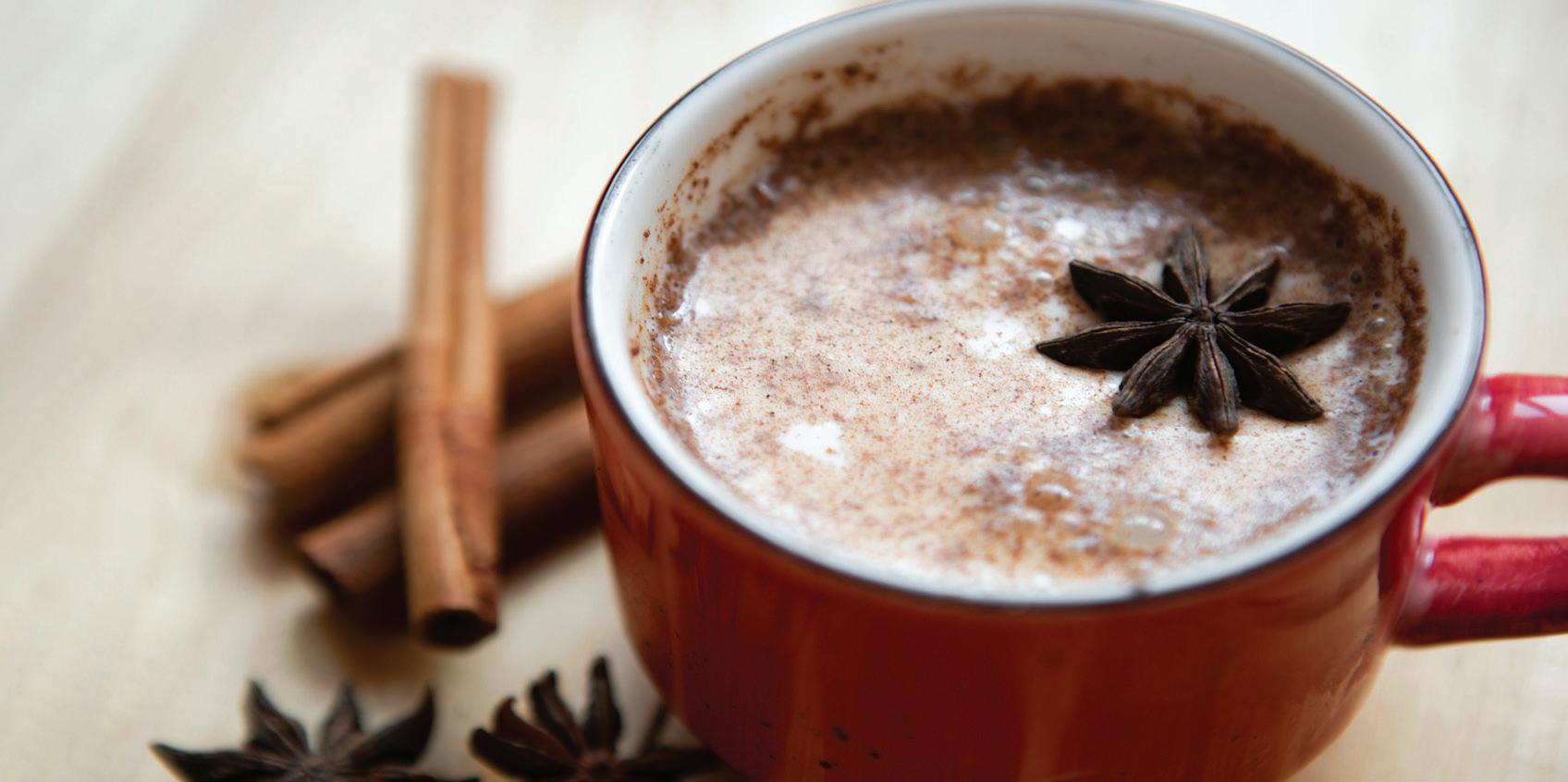
Masala Latte
Ingredients (Serves one)
(A) Masala powder
50g cardamom 50g ceylon cinnamon
25g cloves 25g black pepper
Method:
• Blend all the ingredients together until they form a fine powder. Store the powder in a bottle and keep it in a cool, dry place.
(B) Flavoured plant milk
250ml oat milk/almond milk/soy milk
A pinch bamboo salt/black salt
2 slices fresh ginger
1pc medjool, pitted
1tsp palm sugar
Method:
Combine all the ingredients and heat the mixture to 90°C.
• Using a blender, blend 1 to 2 teaspoons of the homemade masala powder (A) with the flavoured plant milk (B) on high speed for one minute.
• Serve warm.
Recipes are courtesy of Wong Kee Yee, a vegetarian nutrition teacher who conducts classes at Awareness Hub. You can find out more about his classes on page 47.
/ Recipe 86 慈悲COMPASSION I 智慧WISDOM I 生活LIFE Scan to find out more about Kee Yee
A cup of
Beyond Distraction: Five Practical Ways to Focus the Mind

A practical guide using Buddha's teachings to cultivate clarity, focus and freedom.
By Shaila Catherine S$25.90
In her book, meditation teacher Shaila Catherine shares practical steps from the Buddha's teachings to develop clarity and overcome distractions in various aspects of life. She emphasises five key steps: replacing unwholesome thoughts, understanding distractions' pitfalls, skilfully avoiding them, exploring their causes, and cultivating determination. The book includes exercises and reflective practices for deep concentration and realising the impermanence of thoughts, leading to inner freedom.
Present Moment Wonderful Moment
79 mindful verses to connect us to the present, cultivate calmness and find joy.
By Thich Nhat Hanh S$29.10
This book presents 79 meditations with insightful commentaries to bring mindfulness and joy to daily routines. From waking up to washing dishes, the verses help one stay present and find calmness and joy in one's life. The beautiful illustrations make the mindfulness verses easy to understand and apply. By reciting these verses, we can calm and slow down, appreciate every moment of our lives and find joy in everyday life.

The
Heroic Heart: Awakening Unbound Compassion Compassion, adversity, and mindfulness for a meaningful life.
 By Jetsunma Tenzin Palmo S$29.50
By Jetsunma Tenzin Palmo S$29.50
In this guidebook, revered Buddhist nun, Jetsunma Tenzin Palmo, explores the path of cultivating compassion, embracing adversity and training the mind for a meaningful life. Drawing from the teachings of the "Thirty-Seven Practices of a Bodhisattva", Palmo offers practical advice on embodying compassion and living as spiritual heroes. Through her profound wisdom and personal reflections, she inspires readers to tame the mind, uncover their true nature and foster meaningful connections with others.
The Bodhisattva Path: Commentary on the Vimalakirti and Ugrapariprccha Sutras (Paperback)

Includes the author’s unpublished commentaries on two early Mahayana sutras.
By Thich Nhat Hanh S$35.60
Thich Nhat Hanh explores the Bodhisattva ideal, recognising awakening potential in all and providing spiritual support. This book covers its historical roots and includes Thich Nhat Hanh's commentaries on early Mahayana sutras. Emphasising accessibility and cultivating love and compassion, it offers practical guidance to alleviate suffering and deepen the understanding of Buddhism.
/ Great Reads
87 慈悲COMPASSION I 智慧WISDOM I 生活LIFE
Experience tranquillity and elevate your meditation practice with our sublime Sandalwood Prayer Beads.

Sandalwood is renowned for its ability to stabilise the mind and facilitate deep meditation. It is also known to help alleviate desires and cultivate serenity within.
Crafted from quality Laoshan sandalwood, these wooden beads emit a captivating and woody aroma that will enhance your meditation practice or prayer
With 108 beads intricately strung together, every bead is meticulously crafted and finished to perfection. This creates a smooth texture that effortlessly glides through your fingers.
Transitioning from one bead to another, these prayer beads offer a seamless and comforting experience as you engage in your spiritual practice.
Strings of devotion
Available in four different bead sizes, these Sandalwood Prayer Beads cater to the needs and preferences of every individual.
To find out more, visit any Awareness Place stores or call 6337 7582/6452 1732.
/ What's New 88 慈悲COMPASSION I 智慧WISDOM I 生活LIFE























































 Adapted from: Beyond the edge.
Adapted from: Beyond the edge.



 KMSPKS Museum, located at Venerable Hong Choon Memorial Hall (Level 3), is open to the public every 27th day of the lunar month from 9am to 2pm. Admission is free. Scan for more information.
KMSPKS Museum, located at Venerable Hong Choon Memorial Hall (Level 3), is open to the public every 27th day of the lunar month from 9am to 2pm. Admission is free. Scan for more information.












































 By Jetsunma Tenzin Palmo S$29.50
By Jetsunma Tenzin Palmo S$29.50

